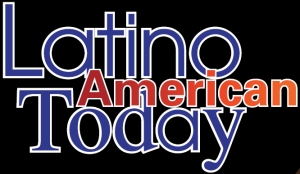LATINO AMERICAN TODAY - Education
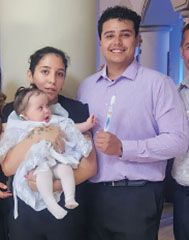
Juan Huerta is running for election for an at-large seat of the South Washington County Schools.
Interview with Latino American Today I grew up in Saint Paul, Minnesota Frogtown area and attended schools in Saint Paul, finishing my last two years of High School in Circle Pines, Minnesota. After joining the Marines, I completed my bachelor’s degree in criminal justice then joined the City of Leavenworth, Kansas Police Department. We have lived in Cottage Grove, Minnesota for the last 18 years. Happily married to my wife for over 22 years, we have six wonderful children, five daughters and one son. All my children have attended the 833-school district. I am currently working for a Fortune 500 company as their site security supervisor, fire chief for their onsite fire brigade and in charge of the EOC Emergency Operating Center.
LAT: What motivates you to want to become a board member?
I want to improve public education and serve the community. I want to be a voice for my community, work with teachers, parents, and administrators, but mostly I want to see our children succeed in the future.
LAT: What is your vision for education in this community?
My vision is to collaborate with parents and teachers to raise districts standardized test scores in reading, writing, and math. While creating a safe educational environment for our schools by collaborating closely with school officials and our local law enforcement to include more SRO school resource officers.
LAT: What do you see as the primary work of the board?
As a school board member, I would be reading over and establishing different policies that would affect our children. My vision for the school district is to ensure that the best interests for our children are being represented. Reviewing the district’s budget and balance financial needs with taxpayers’ affordability.
LAT: Do you have sufficient time/energy to devote to this position?
Yes, I am a motivated individual, and I am full of energy. Well organized in everything I do even had time to run a 5K for Run/Walk for Heroes in Cottage Grove MN. On 9/13/2025.

The statement “More Hispanics should go to trade schools” is supported by the argument that trade schools offer a pathway to well-paying jobs with practical skills, which can be particularly beneficial for Hispanic communities due to factors like potential financial constraints, a focus on immediate career opportunities, and a high demand for skilled labor in certain trades; however, it’s important to consider individual career goals and ensure access to quality trade school programs for all demographics.
Key points supporting this argument:
• High-demand, good-paying jobs:
Many trade careers offer stable employment with competitive wages without requiring a four-year college degree, which can be particularly appealing to individuals facing financial barriers.
• Hands-on learning:
Trade schools provide practical, hands-on training that can be beneficial for learners who prefer a more active learning style.
• Faster career entry:
Trade school programs often have shorter durations compared to traditional college degrees, allowing individuals to enter the workforce sooner.
• Community needs:
Certain industries like construction, plumbing, and electrician work are in high demand in many communities and could benefit from a larger pool of skilled Hispanic workers.
Important considerations:
• Access and awareness:
Efforts should be made to ensure Hispanic communities have access to quality trade school programs and are informed about the potential career paths available.
• Career counseling:
Guidance is crucial to help individuals choose trade paths that align with their interests and local job market needs.
• Addressing stereotypes:
Combatting negative stereotypes associated with trade work can encourage more Hispanic students to consider these pathways.
Los latinos deberían trabajar más en el sector de los oficios, como la construcción, la carpintería, la fontanería, la electricidad y la calefacción, ventilación y aire acondicionado (HVAC). Ofrece una vía de acceso a empleos bien remunerados y con gran demanda, especialmente en el sector de la construcción, donde ya están muy representados, y puede ayudar a abordar la creciente escasez de mano de obra cualificada, al tiempo que ofrece oportunidades de promoción profesional y estabilidad económica.
Puntos clave:
• Gran demanda de trabajadores cualificados:
El sector de la construcción, uno de los principales empleadores de trabajadores latinos, se enfrenta actualmente a una importante escasez de mano de obra cualificada, lo que lo convierte en un área primordial para aumentar la participación latina.
• Oportunidades económicas:
Los empleos en oficios suelen ofrecer salarios y beneficios competitivos, lo que supone una fuente de ingresos estable para los trabajadores latinos.
• Diversas trayectorias profesionales:
Los oficios abarcan una amplia gama de especialidades como carpintería, fontanería, electricidad y calefacción, ventilación y aire acondicionado, lo que permite la progresión profesional y la especialización.
• Impacto en la comunidad:
Una mayor presencia latina en los oficios puede beneficiar a las comunidades locales al crear una mano de obra más diversa y apoyar los proyectos de construcción locales.
Retos a superar:
• Barreras lingüísticas:
El idioma puede ser un obstáculo importante para los trabajadores latinos que se incorporan a los oficios, lo que requiere acceso a formación y apoyo bilingües.
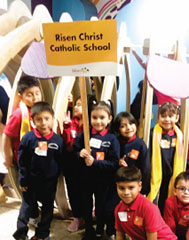 Estudiantes durante uno de los eventos escolares
Estudiantes durante uno de los eventos escolares
Más de 9.1 millones de estudiantes, familias y educadores participarán en la 15.ª Semana Nacional de Opciones Escolares, que se llevará a cabo del domingo 26 de enero al sábado 1 de febrero de 2025. Durante siete días, se celebrarán 27,607 eventos y actividades organizadas de manera independiente en los 50 estados y el Distrito de Columbia. Estas actividades destacan las diversas opciones educativas disponibles para las familias, como escuelas públicas tradicionales, charter, magnet, privadas, en línea, educación en el hogar y otros modelos innovadores.
La edición 2025 de la Semana Nacional de Opciones Escolares llega en un momento de apoyo récord para ampliar las opciones educativas, así como una fuerte demanda de alternativas por parte de las familias.
En los últimos tres años, 24 estados han expandido la diversidad de opciones educativas, permitiendo a las familias elegir cómo y dónde aprenden sus hijos. Estos avances incluyen la inscripción abierta en escuelas públicas, cuentas de ahorro educativo, escuelas charter y magnet, aprendizaje en línea, educación en el hogar y opciones como las microschools. Según una encuesta reciente, más del 60% de los padres en Estados Unidos consideraron cambiar a sus hijos de escuela durante el último año.
Además, 27,541 escuelas de todo el país participarán en la celebración, mientras que organizaciones sin fines de lucro a nivel estatal organizarán 66 eventos principales en 38 estados, como ferias escolares, manifestaciones en capitolios estatales y exhibiciones de talentos estudiantiles.
“Conoce tus Opciones Escolares es una herramienta invaluable para las familias hispanas que buscan información clara sobre las alternativas educativas disponibles para sus hijos”, señaló Krissia Campos Spivey, directora senior de Conoce tus Opciones Escolares. “Durante la Semana Nacional de Opciones Escolares, queremos asegurarnos de que más familias descubran estas opciones y se sientan capacitadas para elegir la educación que mejor satisfaga las necesidades de sus hijos para el ciclo escolar 2025-2026.”
NSCAF ofrece recursos gratuitos y accesibles a través de sus programas Navigate School Choice (myschoolchoice.com) y Conoce tus Opciones Escolares (opcionesescolares.com), disponibles en inglés y español.
Desde su primera edición en 2012, con solo 150 eventos, la Semana Nacional de Opciones Escolares ha crecido de manera exponencial gracias a su enfoque inclusivo y positivo.
 Left: Vacúnate contra el COVID-19
Left: Vacúnate contra el COVID-19
Por Rico Paul Vallejos
¿Lo viste? Yo no. Quién sabe si vino el chupacabra este Halloween, no todos lo ven, pero siempre hay alguien que lo ve, siempre hay avistamientos. Veremos qué reportes surgen en las siguientes semanas. (Si no lo leíste, mira el artículo del mes pasado en el que cuento cómo comenzaron los avistamientos del chupacabra.)
Yo me vacuné, por las dudas.
No, que yo sepa no hay reportes de que el chupacabra, al morderte, te pase alguna enfermedad. ¡Pero quién sabe! Hay tanta especulación sobre esa pobre criatura mítica que, por las dudas, y también por la estación (otoño), yo aproveché y ya me vacuné.
Las dos vacunas que se recomiendan son la de la influenza y la de COVID-19, ambas con nuevas formulaciones para esta temporada. Yo recibí una en cada brazo, y no tuve ningún problema. Según los Centros para el Control y la Prevención de Enfermedades (CDC), la temporada de influenza 2023-2024 ya comenzó y por eso se actualizó la composición de la vacuna.
La vacuna contra el COVID-19
Sabemos que tenemos que mantenernos al día con la vacuna contra el COVID-19, porque siguen surgiendo variantes, y también porque los CDC recomiendan las vacunas actualizadas contra el COVID-19 para 2023-2024 de Pfizer-BioNTech, Moderna, o Novavax para evitar enfermarse gravemente a causa del COVID-19.
Como hay tantas opiniones sobre la vacuna, como redactor periodístico decidí investigar un poco el tema. Aprendí que el proceso de desarrollo y aprobación de las vacunas es muy completo.
Después de todo, las vacunas tienen una larga historia de éxito en la protección de personas y comunidades contra las enfermedades infecciosas. La vacunación ha mejorado la calidad de vida de mucha gente, y se han eliminado enfermedades graves como la viruela. A medida que avanza la tecnología de las vacunas, los investigadores pueden desarrollar vacunas mejores y más seguras.
El Centro de Evaluación e Investigación Biológica (CBER) de la Administración de Alimentos y Medicamentos de Estados Unidos (FDA) es responsable de regular el uso de las vacunas en todo el país.
Las fases generales del desarrollo de una vacuna son:
• Investigación y descubrimiento
• Prueba de concepto
• Prueba de la vacuna
• El proceso de fabricación
• Aprobación de la vacuna
• Recomendación del uso de la vacuna
• Control de la seguridad tras la aprobación
Thanksgiving
Me dan mucha confianza los equipos de profesionales médicos y científicos que trabajan en las varias fases del desarrollo y aprobación de las vacunas.
Entonces, por los avances médicos de técnicas de inmunización, y el pronto desarrollo de vacunas que nos ayudan a mejorar nuestra inmunidad a las nuevas variantes, estoy agradecido.
Doy gracias, y sugiero que en las próximas fiestas de Acción de Gracias, Thanksgiving, todos mostremos nuestro agradecimiento llegando a la mesa ya debidamente vacunados.
Todos te agradeceríamos eso. Muchas gracias.
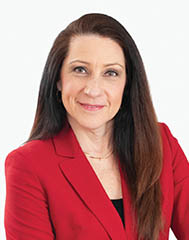 Left: Entrepreneur Marci Malzahn
Left: Entrepreneur Marci Malzahn
By Marcia Malzahn
When we hear the news about the economy, the increased crime, and about America as a nation walking away from God, we get discouraged. We question if our prayers are worth it because we don’t see immediate results. But today I want to encourage you to not give up on America! The Bible tells us in Ephesians 6:18 to “Pray at all times and on every occasion in the power of the Holy Spirit. Stay alert and be persistent in your prayers for all Christians everywhere.” America is a nation founded by Christians and there are still millions of believers in this country.
Watching your beloved country go down the tube is very disheartening. But the Lord revealed something very important to me recently. Our prayers do have an impact. Let me share the story of Jonah. The Book of Jonah is the shortest book in the Bible, but the story is very powerful.
Jonah received a message from the Lord to “Get up and go to the great city of Nineveh! Announce my judgment against it because I have seen how wicked its people are,” (Jonah 1:2). But Jonah didn’t want to go because he feared the people in that evil city. So, he went the opposite way, bought a ticket, and got on a boat going to Tarshish. While on the boat, God sent a terrible storm, and the sailors were terrified. They prayed to their gods to calm the storm, but they didn’t answer. They soon found out that Jonah had disobeyed his God and that’s why the storm happened. Jonah asked them to throw him overboard and the storm would be gone.
So, they did. As soon as they threw Jonah into the sea, the storm calmed down. The sailors were amazed at God’s power and vowed to serve Him going forward. As Jonah sank into the bottom of the sea, God sent a huge fish that swallowed Jonah and kept him inside for three days and three nights. During this time Jonah repented and God made the fish to spit him out.
Then the Lord asked Jonah a second time to go to Nineveh with His message. This time Jonah obeyed the Lord’s command and went to Nineveh. Once he arrived and shared God’s message that said: “Forty days from now Nineveh will be destroyed!” The people of Nineveh believed God’s message, and from the greatest to the least, they decided to go without food and wear sackcloth to show their sorrow”, (Jonah 3:3-5).
And when the king heard the message, he issued a decree to the city: “No one, not even the animals, may eat or drink anything at all. Everyone is required to wear sackcloth and pray earnestly to God. Everyone must turn from their evil ways and stop all their violence. Who can tell? Perhaps even yet God will have pity on us and hold back his fierce anger from destroying us,” (Jonah 3: 7-9).
As everyone repented and prayed, a miracle happened. “When God saw that they had put a stop to their evil ways, he had mercy on them and didn’t carry out the destruction he had threatened” (Jonah 3:10). Interestingly, when Jonah saw God’s mercy on this evil city, he was upset because he wanted them to be destroyed. They deserved it. But God challenged Jonah and told him he could not question God’s mercy. “Nineveh has more than 120,000 people living in spiritual darkness, not to mention all the animals. Shouldn’t I feel sorry for such a great city?” (Jonah 4:11).
What a beautiful story of God’s mercy, forgiveness, and second chances. I learned five lessons from this story:
1) Disobedience: We each have a special calling and when we disobey God’s command or run away from Him, we pay the consequences of our disobedience. Storms come to our life because of our own fault. We bring it to ourselves and, unfortunately, those around us also suffer the consequences.
2) Repentance: The moment we repent from our hearts, God forgives us and gives a second chance to obey His command. Jonah didn’t get out of his troubles and walked away. He had to fulfil his unique mission. We must repent and stop sinning.
3) Forgiveness: No matter how evil people and an entire country are, if everyone repents and seeks God’s forgiveness with humility, God will forgive us. He will even stop His judgment from destroying our entire country. This revelation gave me hope. Let’s not give up on America. Let’s repent as a nation from having walked away from God. We took Him out of our schools and allowed evil to destroy our families. Along with repentance comes fervent prayer for our nation and for one another. Prayer for God to forgive us and to spare us from destruction. Sometimes destruction is not only physical but spiritual, which is worse because it has eternal consequences.
4) Love: God cares. He cares for each person in the entire world. He does not want anyone to perish, which is precisely why He sent His only Son, Jesus, to die for all our sins. But we must repent and accept the gift of salvation.
5) Witness: When we obey God, others will see His power and will believe too. We are to be examples of God’s mercy and love for humanity.
As we celebrate the United States’ Independence this month, I hope the story of Jonah will inspire and encourage you to pray for America and for all its citizens.
Happy Independence Day!
 Left: Entrepreneur Marci Malzahn
Left: Entrepreneur Marci Malzahn
By Marcia Malzahn
When we hear the news about the economy, the increased crime, and about America as a nation walking away from God, we get discouraged. We question if our prayers are worth it because we don’t see immediate results. But today I want to encourage you to not give up on America! The Bible tells us in Ephesians 6:18 to “Pray at all times and on every occasion in the power of the Holy Spirit. Stay alert and be persistent in your prayers for all Christians everywhere.” America is a nation founded by Christians and there are still millions of believers in this country.
Watching your beloved country go down the tube is very disheartening. But the Lord revealed something very important to me recently. Our prayers do have an impact. Let me share the story of Jonah. The Book of Jonah is the shortest book in the Bible, but the story is very powerful.
Jonah received a message from the Lord to “Get up and go to the great city of Nineveh! Announce my judgment against it because I have seen how wicked its people are,” (Jonah 1:2). But Jonah didn’t want to go because he feared the people in that evil city. So, he went the opposite way, bought a ticket, and got on a boat going to Tarshish. While on the boat, God sent a terrible storm, and the sailors were terrified. They prayed to their gods to calm the storm, but they didn’t answer. They soon found out that Jonah had disobeyed his God and that’s why the storm happened. Jonah asked them to throw him overboard and the storm would be gone.
So, they did. As soon as they threw Jonah into the sea, the storm calmed down. The sailors were amazed at God’s power and vowed to serve Him going forward. As Jonah sank into the bottom of the sea, God sent a huge fish that swallowed Jonah and kept him inside for three days and three nights. During this time Jonah repented and God made the fish to spit him out.
Then the Lord asked Jonah a second time to go to Nineveh with His message. This time Jonah obeyed the Lord’s command and went to Nineveh. Once he arrived and shared God’s message that said: “Forty days from now Nineveh will be destroyed!” The people of Nineveh believed God’s message, and from the greatest to the least, they decided to go without food and wear sackcloth to show their sorrow”, (Jonah 3:3-5).
And when the king heard the message, he issued a decree to the city: “No one, not even the animals, may eat or drink anything at all. Everyone is required to wear sackcloth and pray earnestly to God. Everyone must turn from their evil ways and stop all their violence. Who can tell? Perhaps even yet God will have pity on us and hold back his fierce anger from destroying us,” (Jonah 3: 7-9).
As everyone repented and prayed, a miracle happened. “When God saw that they had put a stop to their evil ways, he had mercy on them and didn’t carry out the destruction he had threatened” (Jonah 3:10). Interestingly, when Jonah saw God’s mercy on this evil city, he was upset because he wanted them to be destroyed. They deserved it. But God challenged Jonah and told him he could not question God’s mercy. “Nineveh has more than 120,000 people living in spiritual darkness, not to mention all the animals. Shouldn’t I feel sorry for such a great city?” (Jonah 4:11).
What a beautiful story of God’s mercy, forgiveness, and second chances. I learned five lessons from this story:
1) Disobedience: We each have a special calling and when we disobey God’s command or run away from Him, we pay the consequences of our disobedience. Storms come to our life because of our own fault. We bring it to ourselves and, unfortunately, those around us also suffer the consequences.
2) Repentance: The moment we repent from our hearts, God forgives us and gives a second chance to obey His command. Jonah didn’t get out of his troubles and walked away. He had to fulfil his unique mission. We must repent and stop sinning.
3) Forgiveness: No matter how evil people and an entire country are, if everyone repents and seeks God’s forgiveness with humility, God will forgive us. He will even stop His judgment from destroying our entire country. This revelation gave me hope. Let’s not give up on America. Let’s repent as a nation from having walked away from God. We took Him out of our schools and allowed evil to destroy our families. Along with repentance comes fervent prayer for our nation and for one another. Prayer for God to forgive us and to spare us from destruction. Sometimes destruction is not only physical but spiritual, which is worse because it has eternal consequences.
4) Love: God cares. He cares for each person in the entire world. He does not want anyone to perish, which is precisely why He sent His only Son, Jesus, to die for all our sins. But we must repent and accept the gift of salvation.
5) Witness: When we obey God, others will see His power and will believe too. We are to be examples of God’s mercy and love for humanity.
As we celebrate the United States’ Independence this month, I hope the story of Jonah will inspire and encourage you to pray for America and for all its citizens.
Happy Independence Day!
 Left: Entrepreneur Marci Malzahn
Left: Entrepreneur Marci Malzahn
By Marcia Malzahn
I believe that leadership and parenthood are similar in many ways. I used to joke that if you are a parent, then you can be a good leader because employees are just like kids. They want your time, your attention, and they fight amongst themselves just like siblings do. They want toys and gifts, and certain employees are demanding just like little kids are before they discover that the world actually does not revolve around them. It takes a lot of courage, love, and patience to be a parent. I believe it’s the same for leaders.
Let’s look at several ways in which leadership and parenthood are similar:
Leadership and parenthood require patience.
From the moment a baby is born, parents must be patient with their new daughter or son. With sleepless nights, parents are tired and even the little things can diminish their patience. In a traditional family setting, ideally, the mother does certain things such as nursing the baby, while the father can help with other tasks such as cooking or washing the countless bottles! Parents must also be patient with themselves and with each other as they adjust to the new family member. As the family grows, more adjusting must happen in order to keep the peace in the family.
In the workplace, leaders must be patient with each employee as they get familiar with their jobs. And as the team grows, the leader must learn to lead and manage each employee as individuals. Leaders learn quickly that they can’t manage every person the same way as what works with one person may not work with another. It is the leader’s responsibility to adjust their leadership style to each person they lead. At the same time, leaders must be patient with themselves as they grow within their own job and develop their leadership talent.
Love and care are critical in any relationship.
A newborn needs and yearns to be loved and accepted from day one. The best parents are not afraid to tell their children with words how much they love each child. Children and even adults need to know that they are loved by their parents more than anyone else in the world. Children raised in a single-parent home, unfortunately, miss hearing those words from the other parent who is absent. However, one parent can make up for that gap in love when doing so with intentionality.
As children grow up and go to work, they still (as human beings) need to know that the boss cares for them—at the personal level and not only as producers in the workplace. Leaders need to learn how to display their care for each person the same way that parents discover how each child likes to be loved, recognized, and cared for. Again, it’s on the leader to find out and get to know each employee.
Mentoring and guidance equip the youth for success.
As a child grows up, parents have an amazing opportunity to mentor and guide their child through childhood, teenage years, and young adulthood. There is no human being that does not need guidance during their growing years and even as adults later. And although many parents do their best and their child goes another way, you must never stop mentoring your children, so they can never say, “you never told me” or “you didn’t warn me.”
In the workplace, leaders naturally play the role of mentor and provide guidance to their employees. Everyone needs a mentor who cares about their success in the various aspects of life. So many successful people owe at least part of their success to a person who mentored them during their careers or got them through difficult times in their personal life.
I encourage you to always do your best as a parent and as a leader if you happen to have these two incredible opportunities to influence others in your life. Ensure you are the most influential person in your child’s life while you can. And to those of you reading who are fathers, I wish you the best and a happy Father’s Day! For those of you who no longer have your earthly father, I encourage you to remember him on Father’s Day.
 Left: Entrepreneur Marci Malzahn
Left: Entrepreneur Marci Malzahn
By Marcia Malzahn
One day a year to honor and celebrate moms around the world is not enough. As a mother myself, what I appreciate the most about my children is when they connect with me. Staying in touch with mom is one of the biggest blessings that children can do for them.
Unfortunately, many people have lost their mom or never met their mom. Also, celebrating Mother’s Day with your mom when your relationship is not in a good place can be difficult. In that case, there are still ways you can honor your mother. But if you are fortunate to still have your mother and have a good relationship with her, what are you doing to honor her on Mother’s Day? More importantly, what are you doing to honor your mother every day? Below are some ideas that you can do to honor and celebrate your mother:
Spend quality time.
The most sought-after gift by all humans is your loved ones’ time. The
special quality time spent with a loved one goes way beyond any material
gifts given to them. On this Mother’s Day, spend time with your mom
doing something she enjoys. Sometimes that means simply going out to
coffee or visiting her at home.
Tell her you love her.
Often, we assume that our loved ones know we love them, and we don’t
express it in words. Never assume they know. The people we love need to
know and we must tell them with words. There should be no doubt of our
love for others – especially the woman who gave birth to you, your mom.
Give her a card.
Something as simple as a Mother’s Day card or a handwritten note to your
mom wishing her happy Mother’s Day is appreciated. You remembered her special day. Cards are expensive these days, so if you don’t want to spend
money on a card, handwrite one. She will treasure it the same as when
you were a small child when you were learning to write.
Do an act of service.
As our parents get older, what they could do before and what they did for
you is now harder to do. Cooking, cleaning the house, making the bed,
doing laundry, driving you to places, taking you to the doctor, and many
other activities, are now a challenge for them. Now it’s your turn to return
the favor and do all of those or certain activities for your parents. It is
common for women to outlive men so your mom may be now a widow, or
was always a single mom, or has been divorced for many years. She needs
your help!
Talk with your mom.
It is easy to spend time with someone and not really have a conversation.
That is okay sometimes. But people also need time to converse and have
heart to heart conversations. Unfortunately, many people don’t have that
type of relationship with their mothers. In those instances, you can make
an effort to simply listen to her stories. That is honoring your mother.
If your mom lives far away from you, a virtual visit always works and a
surprise visit in person will go beyond any other gift she receives!
Take her on a special vacation.
If you can afford to take your mom on a vacation as a special gift to her, you may have a great opportunity to create wonderful memories. You may not have the time or the money for a vacation but you may be able to do a day trip to a free place and create memorable moments too.
I hope these ideas inspire you to honor your mother in a special way on Mother’s Day. If your mom has passed away, you can still honor her memory. I leave you with this Scripture: Exodus 20:12 (NLT) “Honor your father and mother. Then you will live a long, full life in the land the Lord your God is giving you.”
Marcia is an inspirational keynote speaker and published author of five books: A daily devotional – Devotions for Working Women, The Fire Within – to help you find your purpose, friendship poems in The Friendship Book, also in Spanish El Libro de la Amistad (poemas de Amistad), and Bring YOUR Shoes to help emerging leaders with tools on how to lead. In her latest grandma baby book, Inside Your Mama’s Tummy, Marcia inspires grandparents to form a bond with their grandchildren.
You can contact Marcia for speaking engagements through her website at https://crowning-achievements.com/ or email her at mmalzahn@crowningachievements. com. Marcia Malzahn is also president and founder of Malzahn Strategic a management consulting firm for community financial institutions.
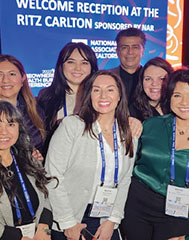 Left: 2023 NAHREP
Homeownership & Wealth Building Conference in Washington, D.C.
Left: 2023 NAHREP
Homeownership & Wealth Building Conference in Washington, D.C.
By Rico Vallejos
NAHREP Twin Cities en la conferencia nacional
Nuestro grupo local de la Asociación Nacional de Profesionales Inmobiliarios Hispanos, NAHREP Twin Cities, estuvo bien representado en la Conferencia 2023 NAHREP Homeownership & Wealth Building en Washington DC el mes pasado.
NAHREP y el Hispanic Wealth Project (HWP) han desarrollado NAHREP 10, diez disciplinas para vivir una vida plena y exitosa, con el fin de desarrollar y mantener la prosperidad generacional. A través de capacitaciones gratuitas, los Instructores Certificados NAHREP 10 animan a familias latinas a establecer y alcanzar objetivos financieros realistas, usando como guía las diez disciplinas.
Rico Paul Vallejos es el primer Instructor Certificado NAHREP 10 en Minnesota y está disponible para presentar NAHREP 10 en inglés o español en nuestras comunidades. Se le puede contactar por email a rico@vallejos.net.
NAHREP Twin Cities at National Conference
Our local chapter of the National Association of Hispanic Real Estate Professionals, NAHREP Twin Cities, was well represented at the 2023 NAHREP Homeownership & Wealth Building Conference in Washington DC last month.
NAHREP and the Hispanic Wealth Project have developed the NAHREP 10, a set of wealth disciplines developed around building and sustaining generational wealth. Through training provided free of charge, NAHREP 10 Certified Trainers encourage Latino families to establish and work toward realistic financial goals, using the 10 disciplines as a guide.
Rico Paul Vallejos is the first NAHREP 10 Certified Trainer in Minnesota and is available to present the NAHREP 10 in English or Spanish in our communities. He can be reached at rico@vallejos.net.
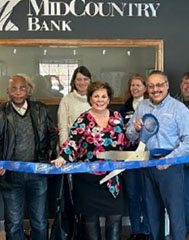 Left: MidCountry Bank and MidCountry Insurance join the River Heights Chamber of Commerce
Left: MidCountry Bank and MidCountry Insurance join the River Heights Chamber of Commerce
By Claud Santiago
MidCountry Bank and MidCountry Insurance enjoyed a ribbon cutting celebration for joining the River Heights Chamber of Commerce. Latino American Today publisher, Rick Aguilar, joined chamber, business and community members for the celebration. A fun networking time was had by all.
“MidCountry is proud to be involved and support local area Chambers of Commerce. As a relationship-focused organization, our goals are similar to the goals of the Chambers: developing and deepening local business relationships.”
– Enrique Vazquez Branch Manager and Bilingual Banker at MidCountry Bank.
 Left: Marcia Malzahn, president and founder of Malzahn Strategic
Left: Marcia Malzahn, president and founder of Malzahn Strategic
By Marcia Malzahn
When talking with leaders around the nation about the current situation we live in, I am reminded that life is uncertain, but God is certain. Planning with uncertainty being the only thing that is for certain is extremely difficult. But when we look at everything from the spiritual perspective trusting that God will help us along the way, planning becomes doable. In fact, planning is our responsibility.
Planning is a must for leaders to succeed, not only in their own careers but also for the companies they lead. As you get going in the New Year, it is easy to forget the excitement you felt at the beginning because busyness takes over. But I encourage you to plan in the midst of uncertainty to the best of your ability. Then stay the course you set out to do for these next twelve months.
Below are some reminders from the book of wisdom – the Bible – that tells us how to plan during uncertain times:
Do plan if you want to succeed. Good planning and hard work lead to prosperity, but hasty shortcuts lead to poverty. (Proverbs 21:5)
God has good plans for you. For I know the plans I have for you,” says the Lord. “They are plans for good and not for disaster, to give you a future and a hope. In those days when you pray, I will listen. If you look for me wholeheartedly, you will find me. (Jeremiah 29:11-13)
Trust God not money. Teach those who are rich in this world not to be proud and not to trust in their money, which is so unreliable. Their trust should be in God, who richly gives us all we need for our enjoyment. 1 Timothy 6:17
Ask God for wisdom. If you need wisdom – if you want to know what God wants you do to – ask him, and he will gladly tell you. He will not resent you asking. (James 1:5)
Planning brings you honor and respect. My child, don’t lose sight of good planning and insight. Hang on to them, for they fill you with life and bring you honor and respect. (Proverbs 3:21-22)
As you can see, it is in God’s will for us to plan so we can have certainty in our lives. Lack of planning brings uncertainty and fear. Planning brings peace, certainty, security, honor, and respect. If you are a planner, those who watch you will see you as a wise person. Then you’ll have an opportunity to share your wisdom and where it comes from. Proverbs 2:11 says, “Wise planning will watch over you. Understanding will keep you safe.”
By planning all aspects of your life, you take control of your life and responsibility for your actions. But it also means you choose to give that control to God and let Him guide you. With God as part of your planning, you can’t go wrong because you have God’s will for you as your plan. And even though the enemy may try to change and confuse those plans, the Lord will give you wisdom “and you will know how to find the right course of action every time” (Proverbs 2:9).
I hope these scriptures from the Bible encourage you to plan, seek wisdom, and trust God in your journey. Remember, life is uncertain, but God is certain. He is always there for you and ready to help you. All you have to do is reach out and ask for help.
 Left: Marcia Malzahn, president and founder of Malzahn Strategic
Left: Marcia Malzahn, president and founder of Malzahn Strategic
By Marcia Malzahn
The end of a year and the start of a new one gives us the opportunity to reflect in our lives and everything that happened in the past twelve months. As you begin your journey into 2023, I encourage you to reflect on these questions:
1. How can I serve God in new ways in 2023?
2. How can I help others in the New Year?
3. Am I using all my talents to help others? If not, how can I change that?
4. Are there relationships that I need to work on reconciling?
5. Are there areas in my life that I need to do better at?
6. Am I allowing God to help me and guide me in every area of my life?
Answering these questions helped me to be intentional about everything that I will do in the New Year. As I reflected on the first three questions, part of my calling, which is to minister to women, rekindled in my heart. Therefore, I started asking God to open new opportunities for me to speak at women’s ministries, prayer groups, and retreats where I can share about my personal journey with God and inspire women in their own walk with God.
Each year comes with new hopes and expectations. Every year brings surprises, sad life events, and joyful moments as well. I encourage you to “Always be full of joy in the Lord. I say it again – rejoice! Let everyone see that you are considerate in all you do. Remember, the Lord is coming soon. Don’t worry about anything; instead, pray about everything. Tell God what you need, and thank him for all he has done.” Philippians 4:19 (NLT)
I wish you the best as you step into the New Year 2023!
 Left: Marcia Malzahn, president and founder of Malzahn Strategic
Left: Marcia Malzahn, president and founder of Malzahn Strategic
By Marcia Malzahn
This Christmas, I encourage you to give your loved ones the gift of your time. The ROI of your time will be the biggest gift you receive this season! As you invest your time in others’ lives, will you expect a return on your investment? Or will you expect nothing in return?
Investors invest their money in business ventures hoping it will produce a positive return on their investment. Otherwise, they would not do it and many businesses may not exist if no one invested in them at startup. Investors know their expectations for their Return on Investment (ROI). But what if that investment is your time, an intangible yet your most valuable asset? Should you expect a return on your time too? I do and I encourage you to expect a return as well.
Let me explain. While the ROI on your time may never be a financial return, your ROI will always be something. At the least, you will feel like you helped someone – even if that person never even says “thank you” to you. At the most, you will see the fruit of your investment of time by how you were able to impact that person’s life. And sometimes the return on your investment will be in the spiritual realm. You won’t see it here, but you will see it when you go to heaven.
Below are some examples of how you can give the gift of your time:
• Spend time with children: Whether you spend time with your own kids, grandkids, or relatives, or volunteer at a nonprofit to spend time with children, this is always a good investment of your time. When you give children of your time, you are giving them special attention and they feel valued and loved.
• Listen to a widow or widower: People who have recently lost a spouse need special attention and love, especially during the holidays. Often, we don’t know what to say to someone who’s lost a loved one, not realizing that what they need is not for us to say anything. They just need us to listen to them as they process their grief.
• Spend time with your parents: If you’re blessed to still have your parents alive, make the effort to call them, visit them, or do a virtual call if they live away. The special time you spend together will help you create memories that will last a lifetime. If you no longer have your parents, encourage others to connect or reconnect with theirs as we never know if there will be a “next time.”
• Nurture your friendships: Time spent with dear friends rejuvenates you and increases your happiness. Sharing laughter and sometimes tears create a special bond that deepens your relationship.
• Share the Gospel: As a follower of Jesus, I invest my time sharing the Gospel of hope with my friends who may not know how to incorporate Jesus in their everyday life.
• Spend time with God: God, your Father, yearns for your time. God rejoices when you spend time with Him, simply worshiping Him, reading the Bible, or bringing your prayer requests for others to Him.
I hope these ideas inspire you to give of your time this Christmas season. Your gift of time will get you the biggest return on your investment you’ve ever imagined – whether it’s here on earth or in eternity later.
 Marcia Malzahn, president and founder of Malzahn Strategic
Marcia Malzahn, president and founder of Malzahn Strategic
Talent Management continues to be at top concern for leaders; therefore, we are devoting this month and last month to address ten talent management best practices. In Part 1 we defined what Talent Management involves, the important components, and shared the first five best practices. In this article, we address the next five best practices as follows:
6. Establish and Communicate Succession Plans for All Key Positions
It is imperative for your leadership to identify successors to take over the key positions in the company. You need to identify an “immediate successor” and a “planned successor” to have a complete plan. The immediate successor to a specific position could be several employees in the event of a tragedy or sudden departure. The planned successor must be a person who has the skills, talent, and experience to take over the duties of the person leaving. Once you identify the successors, tell them! Often emerging leaders leave a company because nobody told them they were being considered for key positions in the company. Communication is key to the success of succession plans.
7. Provide Leadership and Management Training for Emerging Leaders
Once you identified and communicated to the potential successors that they have an opportunity to leadership positions, provide them with leadership and management training. Choose the appropriate course for them to attend and ensure you budget for their training. There are also leadership books that can prepare emerging leaders to take over leadership positions. They need to know that you support their learning activities and that it’s okay to not have all the credentials just yet. Give them time to grow and mature so they can succeed at their first supervisory job and grow from there.
8. Continued Leadership Development for Experienced Leaders
One key to the continued success of a leadership team is to continue to develop your leadership team members. Often their training does not happen because they themselves are too busy helping the upcoming leaders. But leaders at all levels must continue to develop their own leadership talent. There is nothing like experience; however, even experienced, matured leaders need help in new situations. Ensure you budget for higher leadership training and send your senior executives. They will come back refreshed and encouraged to continue leading the organization.
9. Implement Cross-Training throughout the Entire Organization
The best way to avoid “control freaks” in your company is by cross training everyone in something else. When there is an established culture where every employee is trained first in their own job and then cross-trained to back up another position, the company will experience higher employee retention. Employees appreciate when the company invests in their education and training. To elevate the importance of ongoing training, always keep your customers top of mind. Can they be serviced regardless of who is on vacation or out of the office? If the answer is yes, you have a well-trained staff.
10. Pay Incentive Compensation Plans and Bonuses Based on Performance
Organizations want to please their employees and ensure they feel appreciated. However, there is now a spirit of entitlement where employees forget that a “bonus” is simply that—a bonus pay based on their efforts beyond the call of duty. Communication is the key to ensure employees understand on one hand that they are valued, and on the other hand, that they are paid to do a specific job. They should not expect a bonus for doing their job. The bonus is based on merit, their own performance, and also based on the company as a whole meeting its goals.
I hope these ten top talent management best practices help you in your development of your Talent Management Program. Attracting the right talent and then taking care of your top talent is key to the future success of your organization. November is the month of thanksgiving. I am thankful for this publication, Latino American Today, that allows me to share about these important topics.
Happy Thanksgiving to all my readers!
 Marcia Malzahn, president and founder of Malzahn Strategic
Marcia Malzahn, president and founder of Malzahn Strategic
Talent Management continues to be at top concern for leaders; therefore, this month we address ten talent management best practices. Let’s start by defining what talent management involves. We often hear that “talent is the most important asset in our organization.” But are you taking the necessary steps to attract the right talent, and then educate, encourage, and maintain your top talent?
Talent Management is the umbrella that covers all aspects of taking care
of your employees – your talent. Talent Management includes the
following components:
• Strategies to attract the right talent
• Education and training tools for all staff
• Established career paths
• Personal and professional development opportunities
• Mentoring relationships
• Leadership development plans, and
• Culture training based on your organization’s core values.
In this two-part article, are ten talent management best practices that can help you enhance your Talent Management Program at your organization. We will unfold the above-mentioned components in future articles. For now, we will focus on the first five best practices in Part I of this article:
1. Updated Job Descriptions and Role Clarity
The very first step to formalize your Talent Management Program is to create and update job descriptions for all positions in the organization. In the “Position Purpose” ensure you clarify the role of the position, so everyone understands their job clearly. Include the organization’s core values so employees can identify if their personal core values align with the company’s. Having updated and clearly defined job descriptions for all positions is a strategy to attract the right talent.
2. Current Organizational Design
With the current turnover ratios that companies experience these days, you could update your Organizational Chart daily. However, that is not necessary. Ideally, you first create an Organizational Design only based on functions. Then you create the Org Chart with the employees’ names that occupy each position. The most important questions to answer are: Does our current Organizational Design support our current business model? What changes do we need to make to ensure it supports the future needs of the business? Update the Org Chart at least quarterly and ensure it’s available to all staff.
3. Formal Performance Review Process
The lack of a formal performance review process results in complete lack of accountability at all levels of an organization. There are plenty of software solutions that automate the entire process and save all the documentation electronically. Managers no longer need to complete review forms by hand although, unfortunately, many still want to do it “the old way” or not do them at all. Yes, the process takes time, but it is foundational to retaining your top talent and getting rid of the wrong talent in your company.
The best approach has three simple steps: 1) Employee provides input into their own performance for the past twelve months (at least one week prior to formal meeting); 2) Employee and manager meet to discuss opportunities to grow and recognize accomplishments; 3) Employee takes ownership of his/her own growth and provides manager with a plan to improve, grow, learn, etc. for the next year. Ensure the compensation and salary communication takes place in a separate meeting. Doing so will avoid the employee to want to get to the salary conversation right away.
4. 90-Day Check-In with New Hires and “Stay Interviews” Ongoing
Attracting and then retaining new talent is an ongoing challenge for most companies today. It is therefore important to always conduct a 90-day check-in interview to ensure the new employees integrate into your company’s culture and perform their jobs as agreed. It is also crucial to stay in touch with your existing staff and one way to do so is to conduct “stay interviews.” The purpose of these interviews is to discover any issues or challenges employees may have. Many communication issues take care of themselves through these informal meetings with your current team members.
5. Provide Culture Training Ongoing
Your company has an established culture. Can you define it in words? Does your culture reflect your core values? Do your employees know and can recite your core values? These are important questions to ask your leadership team. The first step to provide culture training is to ensure you define your top 3-5 core values and share them consistently with the entire staff. Reward those who exhibit and live out your company’s core values to encourage others to do the same. Your culture reflects how you do things “your company’s way.” You need to continually enhance your culture and protect it from bad influences once you achieve the culture you aspire to have in your organization.
We will address the next five best practices in Part 2 of this article next month. I hope these five will get you started in enhancing your Talent Management Program at your organization.
Marcia is an inspirational keynote speaker and published author of five books: A daily devotional – Devotions for Working Women, The Fire Within – to help you find your purpose, friendship poems in The Friendship Book, also in Spanish El Libro de la Amistad (poemas de Amistad), and Bring YOUR Shoes to help emerging leaders with tools on how to lead. In her latest book, Inside Your Mama’s Tummy, Marcia inspires grandparents to form a bond with their grandchildren.
You can contact Marcia for speaking engagements through her website at https://crowning-achievements.com/ or email her at mmalzahn@crowning-achievements.com. Marcia Malzahn is also president and founder of Malzahn Strategic a management consulting firm for community financial institutions.
 Marcia Malzahn, president and founder of Malzahn Strategic
Marcia Malzahn, president and founder of Malzahn Strategic
By Marcia Malzahn
Many successful workers aspire to leadership; yet they forget that to be treated like a leader, you must act like one. What does that mean? It means leaders behave in a certain way to, above all, earn the respect of their employees. And to do that, they must first earn their employees’ trust. Employees need to know their leader has their best interest at heart. They want to feel valued and appreciated for their work and their unique contributions to the organization.
Often companies promote their superstar performers to leadership, and they consequently fail miserably at leading others. Why? Because what made them successful at their jobs may not work in a leadership position. Why? Because the leadership traits are different from specific traits or talents needed for the various jobs that made the superstars successful in the first place. While there are certain characteristics that transfer well from a high performer to a leader, the key talent required to lead is the “ability to influence others – naturally.” That is what the talent of leadership is all about. Let’s examine seven behaviors that make leaders successful:
Be humble – ask for help. It’s not about you.
Humility is the first trait I observe when I coach new leaders. It takes humility to ask for help and, especially, to recognize that it’s not about you. It’s all about your employees! When you focus on your employees first, then the goals of the organization are accomplished. You achieve success together.
Be coachable
Leaders who are not coachable are not true leaders. You cannot expect your employees to receive criticism well or be taught anything new if you, as their leader, don’t set the example. Coachable (or trainable) people are those “capable of being trained.” If you can be trained or coached, now you can learn how to do things better – including how treat your employees better. It takes humility to accept that you need coaching – especially as a new leader.
Keep learning.
Now that you humbly accept coaching, you open yourself to learn new ways to lead others. You learn that each person you lead is unique and that you cannot treat everyone the same. You must be “fair to all” which means to treat each person differently based on their needs. This may be a new concept for you as many people feel that everyone should be treated “equally.” But doing that would actually be unfair to most. For example,
if an employee needs flexibility in their schedule and requests to work
7:30 a.m. to 3 p.m. You as the leader can approve the request and
“to be fair to everyone” you decide to change everyone’s schedule to the new one. You will upset employees and they’ll say that’s not fair to them as they don’t need that schedule. Therefore, treating everyone “equally” doesn’t work. Leaders need to treat employees differently based on their unique needs and personalities.
Seek a mentor and mentor others
In addition to needing a coach, you may also need a mentor – someone who’s been in leadership for a long time and who can share their wisdom with you. Again, it takes humility to seek a mentor in whom you can confide your feelings of inadequacy or questions about your own ability to lead others. An experienced mentor shares his/her experiences which help you grow into your leadership position. At the same time, take the initiative to mentor others coming after you.
Be confident.
As you apply what you learned from your coach and mentor, your self-confidence as a leader increases. Similarly, you may discover that leading others is, indeed, not for you – and that is okay. Often, strong performers – whether a top salesperson or engineer – fail as leading others because their very drive that makes them successful in their trade cannot be transferred to their employees. Again, it takes humility to accept that leadership may not be for you. Once you make the change, you experience freedom and the success you felt before you took on the new role in leadership.
Communicate
As mentioned at the beginning, employees want to feel valued and appreciated for their individual contributions. Often leaders do appreciate their employees, but they never tell them. They assume they know. I encourage you to communicate with your employees and tell them “I appreciate you” and “You’re valuable.” Those few words go a long way and result in increased loyalty. Humans need to hear the words to sink into their hearts. Remember, you need to be sincere and authentic when you communicate to your employees.
Take initiative to lead.
Lastly, remember, if you want to be treated like a leader, you must act like one. Leaders take the initiative to lead. One of those initiatives is to hire smarter people than you. When you do so, trust your employees they will do the job you hired them to do. As a leader, build your team and also be part of it by behaving like a leader.
I hope adopting these behaviors help you grow in your leadership journey.
Marcia is an inspirational keynote speaker and published author of five books: A daily devotional – Devotions for Working Women, The Fire Within – to help you find your purpose, friendship poems in The Friendship Book, also in Spanish El Libro de la Amistad (poemas de Amistad), and Bring YOUR Shoes to help emerging leaders with tools on how to lead. In her latest book, Inside Your Mama’s Tummy, Marcia inspires grandparents to form a bond with their grandchildren.
You can contact Marcia for speaking engagements through her website at https://crowning-achievements.com/ or email her at mmalzahn@crowning-achievements.com. Marcia Malzahn is also president and founder of Malzahn Strategic a management consulting firm for community financial institutions.
 Marcia Malzahn, president and founder of Malzahn Strategic
Marcia Malzahn, president and founder of Malzahn Strategic
By Marcia Malzahn
My list of people to pray for continues to grow. There is so much pain, despair, hopelessness, and sickness around us. But I don’t lose hope in God’s promises. Jesus said that we will have troubles in this world. But He also encouraged us to have faith in Him because He has “overcome the world.”
Often when a loved one is sick or is in any kind of need, I worry. Then I pray… and continue to worry. I pray some more and continue to worry. It’s easy to pray and it’s easy to worry. My goal, however, is to “pray and release.” Why is that so diffi cult? Our human nature has the tendency to worry. Our spirit tends to pray and release. What does that mean?
It means that when we pray, we need to leave the burden at the cross, at the feet of Jesus. We release the worry, the person, the issue, the circumstance, and trust God. It means it’s now in God’s hands. We then continue to pray but without the worry because we have the assurance that God will take care of the issue and of us.
The word “release” means to “free from confi nement, bondage, obligation, pain, etc.; to let go.” It also means “to free from anything that restrains or fastens.” In other words, when we release our burdens to God, we are also released from the bondage of the worry or pain we may be carrying. Therefore, when we pray for others, not only God listens to our prayers, but when we also release the burden, we free ourselves from the weight of those burdens on us.
I will leave you today with these encouraging Scriptures:
John 16:33 (NLT) “Here on earth you will have many trials and sorrows. But take heart, because I have overcome the world.”
1 Thessalonians 5:16-18 (NLT) "Always be joyful. Never stop praying. Be thankful in all circumstances, for this is God’s will for you who belong to Christ Jesus."
James 5:16 (NLT) "Confess your sins to each other and pray for each other so that you may be healed. The earnest prayer of a righteous person has great power and produces wonderful results."
As you pray for others, I encourage you to release the worry and leave the burden at the feet of Jesus. Pray and release!
Marcia is an inspirational keynote speaker and published author of five books: A daily devotional – Devotions for Working Women, The Fire Within – to help you find your purpose, friendship poems in The Friendship Book, also in Spanish El Libro de la Amistad (poemas de Amistad), and Bring YOUR Shoes to help emerging leaders with tools on how to lead. In her latest book, Inside Your Mama’s Tummy, Marcia inspires grandparents to form a bond with their grandchildren.
You can contact Marcia for speaking engagements through her website at https://crowning-achievements.com/ or email her at mmalzahn@crowning-achievements.com. Marcia Malzahn is also president and founder of Malzahn Strategic a management consulting firm for community financial institutions.
 Marcia Malzahn, president and founder of Malzahn Strategic
Marcia Malzahn, president and founder of Malzahn Strategic
By Marcia Malzahn
When pondering on what to write to celebrate Independence Day, I debated whether to write about freedom or independence. I decided to focus on “true freedom and how to achieve it.”
Freedom is valuable and it has a cost. Independence is something countries fight for and it’s a personal desire of each individual to experience. Let’s start by defining these important words. Freedom (noun) is “the state of being free or at liberty rather than in confinement or under physical restraint. The exemption from external control, interference, or regulation, the power to determine action without restraint. Personal liberty, as opposed to bondage or slavery.” As a nation it is “political or national independence” (from Dictionary.com).
The word independence means “freedom from the control, influence, support, aid, or the like, of others.” So, does freedom and independence mean the same thing? In a way, yes. In a way, no. Let’s study this concept from the Bible’s perspective.
God created us in His image which means we each have a spirit. It also means that we each have the power to choose which represents an inherent freedom and independence from being under someone else’s control. God tells us in Deuteronomy 30:19, “Today I have given you the choice between life and death, between blessings and curses. Now I call on heaven and earth to witness the choice you make. Oh, that you would choose life, so that you and your descendants might live!
Although God gives us the freedom to choose, He clearly tells us what to choose – choose life so that you and your descendants might live! But the life we are to choose is not necessarily physical life – it’s spiritual life which can only be chosen when we choose to follow Jesus Christ. That is eternal life that never ends and that goes beyond our lives on earth.
This 4th of July we celebrate our country’s independence. While I hope our country continues to be free in a time when our freedoms are continually threatened, I hope you find and choose true freedom. If you have never accepted Jesus in your heart, today is your day! I will leave you with the invitation:
Romans 10:5-13 (NLT) Salvation Is for Everyone
For Moses writes that the law’s way of making a person right with God requires obedience to all of its commands. But faith’s way of getting right with God says, “Don’t say in your heart, ‘Who will go up to heaven?’ (to bring Christ down to earth). And don’t say, ‘Who will go down to the place of the dead?’ (to bring Christ back to life again).” In fact, it says, “The message is very close at hand; it is on your lips and in your heart.”
And that message is the very message about faith that we preach: If you openly declare that Jesus is Lord and believe in your heart that God raised him from the dead, you will be saved. For it is by believing in your heart that you are made right with God, and it is by openly declaring your faith that you are saved. As the Scriptures tell us, “Anyone who trusts in him will never be disgraced.” Jew and Gentile are the same in this respect. They have the same Lord, who gives generously to all who call on him. For “Everyone who calls on the name of the Lord will be saved.”
Happy Independence Day!
Marcia is an inspirational keynote speaker and published author of five books: A daily devotional – Devotions for Working Women, The Fire Within – to help you find your purpose, friendship poems in The Friendship Book, also in Spanish El Libro de la Amistad (poemas de Amistad), and Bring YOUR Shoes to help emerging leaders with tools on how to lead. In her latest book, Inside Your Mama’s Tummy, Marcia inspires grandparents to form a bond with their grandchildren.
You can contact Marcia for speaking engagements through her website at https://crowning-achievements.com/ or email her at mmalzahn@crowning-achievements.com. Marcia Malzahn is also president and founder of Malzahn Strategic a management consulting firm for community financial institutions.
 Marcia Malzahn, president and founder of Malzahn Strategic
Marcia Malzahn, president and founder of Malzahn Strategic
By Marcia Malzahn
It takes practice to learn how to present your own promotion. Organizations post their job openings all the time. But how do you know when you’re ready for a promotion? How do you present your resume and have the conversation with your boss? There are several ways you can present a new job opportunity that includes yourself as the ideal candidate or apply for a higher-level job that results in a promotion. Below are a few ideas to help you take a chance and be ready when those doors open for you.
As a life-long learner, seek new opportunities to learn new skills.
Become a lifelong learner and seek opportunities to learn new skills—consistently. This includes a move to a different job to acquire new experience. The StrengthsFinder 2.0 assessment explains that “learners thrive in the journey of learning.” Learners don’t just learn to be the “know it all” in the room. They learn because they are passionate about the act of learning. They also enjoy sharing their new acquired knowledge with others and inspire learning to those around them.
Identify a need within your organization.
The first step in presenting your own promotion to your manager is to identify a real need in your company. Look around and find gaps. Find what’s missing in your department or any other area of the organization and ask yourself if you may be interested in pursuing such an opportunity. If the answer is no, then propose the idea to someone in that area to improve their department or process. Or help them create a position with the purpose of improving the organization. Doing so, will give you visibility within your organization which can help you get promoted later.
Create Job Description with what you believe would be the duties.
If you are interested in pursuing the proposed job, then move to the next step which is to create a Job Description for the position. Describe the primary functions of the job as best you can and conduct some research on the responsibilities as well as pay scale.
An example of when I created a job description was when I was expecting my second child. I saw a need for a Customer Service Representative in the Treasury Management department. As a next step, I created the draft of the Job Description, presented it to my boss, and told him “I’m your perfect candidate.” He was pleased that I had the idea, went through the work to create the Job Description, and that I had the courage to present myself for my own promotion. Guess what? I got promoted!
Update your Resume to match the job you’re proposing
One way to be ready when doors open is to always update your resume every time you get a new responsibility in your current job. In the event you find yourself looking for a job unexpectedly, your resume is ready. It is also a good idea to update your LinkedIn profile with new job functions that may be significant when looking for other opportunities.
Present the idea to your immediate boss
As I shared in my April column "How to Increase Your Visibility in Your Organization without Self-Promoting," when the institution I worked for decided to be the first to offer online banking, I jumped to the opportunity to present an idea to my boss in Private Banking. I was going to sell this new product to all Private Banking clients of the bank.
There was a need for an expert to sell this new product. I then created the job description for the proposed position, updated my resume, and presented the idea to my manager. She in turn presented it to the senior leadership and they approved the new position. I got a promotion and had the most fun I’ve ever had in a banking job! The job included visiting Private Banking clients at their homes and offices to sign them up on online banking and taught them how to pay their bills. To this day, I still have friendships formed with my clients from almost 30 years ago!
Develop relationships with other department leaders so they know your skills when opportunities open up
One of the best strategies I practiced during my banking career was to develop relationships with other department leaders. It is not only a great opportunity to create new friendships in the workplace, but it allows the department heads of those areas to get to know you.
Taking the step to ask for a promotion or apply for a job that is above you to move up in your career takes courage. I hope these strategies on how to present your own promotion inspired you take the initiative to go for it!
Marcia is an inspirational keynote speaker and published author of five books: A daily devotional – Devotions for Working Women, The Fire Within – to help you find your purpose, friendship poems in The Friendship Book, also in Spanish El Libro de la Amistad (poemas de Amistad), and Bring YOUR Shoes to help emerging leaders with tools on how to lead. In her latest book, Inside Your Mama’s Tummy, Marcia inspires grandparents to form a bond with their grandchildren.
You can contact Marcia for speaking engagements through her website at https://crowning-achievements.com/ or email her at mmalzahn@crowning-achievements.com. Marcia Malzahn is also president and founder of Malzahn Strategic a management consulting firm for community financial institutions.
 Marcia Malzahn, president and founder of Malzahn Strategic
Marcia Malzahn, president and founder of Malzahn Strategic
By Marcia Malzahn
Emerging leaders need visibility. This month I’ll share how to increase your visibility in your organization without self-promoting. Promoting products is easy when you believe in the product and you’re a natural salesperson. But what do you do when you are the product? There is a fine line between promoting yourself as the right job candidate and self-promoting where others notice. Also, what do you do when you don’t enjoy selling?
The key is to increase your visibility in a positive way and with the right approach. To start, you must believe in yourself. If you don’t believe in yourself and have the self-confidence to know that you are valuable, no one will. Below are some strategies you can implement to be noticed in your organization without others thinking you’re self-promoting.
Raise money for a cause your organization supports. Most organizations want to be involved in their communities. Therefore, they have many events they support which gives you a variety of opportunities to get involved. As I shared in my column last month, How to Lead When You’re Not in Leadership, I took the initiative to lead a fundraising event for the Juvenile Diabetes Foundation and I won the contest for the most money raised. This event gave me visibility in the organization and an opportunity to meet the owners of the institution.
Be active in social media by posting and commenting on articles related to your industry. Social media has its pros and cons. It takes time to post and be involved. But at the same time, if you do it right and post educational and informative content, people will react positively. LinkedIn is the preferred social media platform if you want to increase your professional visibility as well as your organization’s visibility. Ensure you are familiar with your organization’s social media policies, so you know how to be involved correctly.
Become the expert at a new product. When I was at the first bank I worked at, the online banking product came out and our bank was the first one in the Twin Cities to offer it. I saw an amazing opportunity to become an expert on the product. I approached my manager with the idea of the job, wrote the job description, and updated my resume to present myself as the best candidate for the position. As a result, they approved the new position, and I became the “online banking expert” at the bank. When people talked about online banking, my name was always brought up. New products are an excellent opportunity to obtain expertise and lead the way.
Participate in networking opportunities where you will meet your company’s senior leadership. Not everybody likes networking. But networking is a necessary activity if you want to meet other professionals and future advocates to help you grow in your career. You can find opportunities to network outside your organization with individuals in your field. There are also internal company networking events that you must take advantage of and attend as much as possible.
It is in these more relaxed gatherings that you meet senior leaders and they get to know you. Many of the conversations revolve around family and special interests you may share with others. Take these opportunities to expand your network of connections as well as to create lifetime friendships along the way.
Be authentic and be genuinely interested in getting to know your coworkers. As you work with peers and coworkers in the office (or virtually), you have a chance to genuinely care about others. People know when you are not sincere in your approach or your intentions. Therefore, make the most of these opportunities and get to know the people you work with, not because you have to, but because you want to. You will see the results –people will see you as an authentic leader.
I hope these strategies provided ideas on how to increase your visibility in your organization without self-promoting.
Marcia is an inspirational keynote speaker and published author of five books: A daily devotional – Devotions for Working Women, The Fire Within – to help you find your purpose, friendship poems in The Friendship Book, also in Spanish El Libro de la Amistad (poemas de Amistad), and Bring YOUR Shoes to help emerging leaders with tools on how to lead. In her latest book, Inside Your Mama’s Tummy, Marcia inspires grandparents to form a bond with their grandchildren.
You can contact Marcia for speaking engagements through her website at https://crowning-achievements.com/ or email her at mmalzahn@crowning-achievements.com. Marcia Malzahn is also president and founder of Malzahn Strategic a management consulting firm for community financial institutions.
 Marcia Malzahn, president and founder of Malzahn Strategic
Marcia Malzahn, president and founder of Malzahn Strategic
By Marcia Malzahn
The question of how to lead when you’re not in a leadership position is common for emerging leaders. Where do you start? In what ways can you show that you have leadership ability to those who can promote you? This month, I share five ways you can lead when you are not in a leadership position yet. I have personally applied these strategies and they worked in my leadership journey.
Volunteer to lead a community event for your organization.
When I was at the first institution I worked at, I saw an opportunity to lead a company-wide effort. The bank had a contest to raise the most money for the Juvenile Diabetes Foundation Walk for the Cure. The purpose was to encourage employees to get engaged in a friendly competition while raising funds for this worthy cause.
I decided to enter the contest and planned a great strategy – Ask the top executives and owners of the bank to contribute. I made appointments with each one and guess what? They all said yes and contributed. In addition, of course, I asked all my friends and family too. The result? I won the contest! The prize was not only recognition in the company’s newsletter, but also dinner with the owners of the bank. It was a fun experience that allowed me to show my leadership talent while raising the most money for the JDF.
Chair an internal committee
Companies have countless opportunities to join internal committees. But not everyone raises their hand to lead and chair a committee because it usually means additional work with no extra pay. However, chairing an internal committee is an amazing opportunity to lead and display your leadership ability to those in higher leadership positions.
Again, before I was in a leadership position, I took an opportunity to chair an internal bank committee to plan the annual employee event. I worked with employees from all over the organization and got to know new people. In the end, all the additional work and time was worth it. The party was a success and I made lifetime friendships along the way. In addition, the committee got recognition and a big thank you from the top leadership.
Present to senior leadership or Board of Directors
Every time you see an opportunity to present a new initiative, a project, or even a monthly report to the senior leadership and/or to the Board of Directors, take it! You will probably be a nervous wreck at first but if you prepare and do your homework, it will be a worthwhile effort. Everyone needs to present at one time or another during your career. Therefore, it’s crucially important to learn how to present well – especially in front of leadership.
You can practice presenting to your immediate team on any topic within the monthly staff meeting. In addition to presentation skills, you will also learn to use tools such as PowerPoint and the projector in the conference room. It’s incredible how many people don’t know how to use the A/V equipment in the conference rooms and waste countless hours figuring it out before meetings.
Serve on the Board of Directors for a nonprofit
I got my very first leadership role as a bank branch manager mainly because I volunteered to lead a nonprofit Board for a financial women’s association. The association formally trained me on how to conduct Board meetings, how to implement the Robert’s Rules of Order, and how to lead volunteers.
Leading volunteers sometimes can prove to be harder than leading employees because it’s harder to fire volunteers who are not performing in their roles. When you lead a nonprofit Board or Committee, you are not only displaying leadership ability but also your heart to serve without expecting financial compensation in return. The nonprofit organization is grateful for your leadership, time, and effort. You get the experience and the fulfillment to participate in a good cause to help others. It’s a win-win!
Take the initiative to start something
One cannot ever get to a leadership position without first taking the initiative to do something. You must act first and take the initiative to lead, to ask for the job, and to seek opportunities. Remember, you are in charge of your own career. And if you want to lead others, you must recognize that leadership is a big responsibility.
If you question how to lead when you’re not in leadership, I hope these strategies help you answer that question. If you take action on these strategies, I guarantee you doors will open for you. You will then need to take the initiative to go through those doors of opportunities.
Are you ready to lead?
Marcia is an inspirational keynote speaker and published author of five books: A daily devotional – Devotions for Working Women, The Fire Within – to help you find your purpose, friendship poems in The Friendship Book, also in Spanish El Libro de la Amistad (poemas de Amistad), and Bring YOUR Shoes to help emerging leaders with tools on how to lead. In her latest book, Inside Your Mama’s Tummy, Marcia inspires grandparents to form a bond with their grandchildren.
You can contact Marcia for speaking engagements through her website at https://crowning-achievements.com/ or email her at mmalzahn@crowning-achievements.com. Marcia Malzahn is also president and founder of Malzahn Strategic a management consulting firm for community financial institutions.
 Marcia Malzahn, president and founder of Malzahn Strategic
Marcia Malzahn, president and founder of Malzahn Strategic
By Marcia Malzahn
Living through the COVID-19 Pandemic created a “Plan-Reschedule-Repeat” cycle which affected both our personal lives as well as our work life. As a leader, it is imperative to be flexible. Last month we discussed the word Resilience which means “the ability of a person to adjust to or recover readily from illness, adversity, or major life changes.” This month I want to emphasize the trait of being flexible. Dictionary.com defines the word “flexible” as “capable of being bent, usually without breaking, susceptible of modification or adaptation, adaptable.”.
These two concepts may seem similar, but they are different traits – and leaders must possess both. You can be flexible with your schedule and don’t mind last-minute changes to your plans. At the same time, your ability to recover from a major life event may be low and, therefore, you are not a very resilient individual.
I am a planner. Sometimes people ask me, “How do you accomplish so much?” My response has always been: “Because I plan everything. If you don’t plan, nothing gets done.” This is a positive trait. However, I am also not an impromptu type of person. Changed plans and last-minute activities cause me stress. Over the years and as I matured, I learned several ways to improve my flexibility trait.
Below are five tips that helped me to be more flexible in my personal life as well as in the workplace as a leader. I hope they help you too.
Schedule open time. If you plan “open time” then you are still planning but you are leaving a window of time where you can be flexible and practice being impromptu. If nothing happens, then the unused open time at work allows you to work on projects! Unused open time at home provides an opportunity to rest or catch up on whatever you want.
Know your priorities in life. My daughter loves to do impromptu activities and when she was in college, she would often call me on a Saturday to spend time with me. Saturdays is my “writing day” and, as you can imagine, I had my day planned so when she asked me to go to the beach or the mall, I had to stop to ask myself these questions: “What’s more important: to spend quality time with my daughter or write?” and “How many moms would love to have their college daughters wanting to spend quality time with them?” The answer to these questions was easy. I’m going to go out with my daughter! Knowing your priorities in life helps you be flexible.
Change your attitude. Even when you plan your day, you can have an open attitude for the possibility that meetings can change, events rescheduled, and vacations cancelled – all because someone got sick. If we implement the “Plan-Reschedule-Repeat” mentality, we simply admit this is our new reality and move forward.
Flexibility opens doors to new opportunities. During the first year of the Pandemic, professional speakers had most in-person events cancelled. Because I was ready to speak virtually having taught webinars for the past four years, new opportunities opened to me. I was able to present virtually nationwide and even one international event in the Philippines. Technology allows us to work and interact easier than ever. Being flexible is crucial to take advantage of these opportunities when they present themselves.
Be intentionally flexible. As a planner, it is hard to be intentionally flexible and “go with the flow.” Practicing flexibility with cancelled flights is by far my biggest challenge – especially when I am traveling by myself. I have learned through countless experiences to not stress out too much, bring something to work on or read, and ensure I have food to last me for the duration of the delay. One strategy I now use is that I only travel to places where direct flights are an option. I avoid stops as much as possible.
Leaders are flexible. Some leaders are more flexible than others, but you can always improve in your flexibility trait. I hope these tips and adopting the “Plan-Reschedule-Repeat” mentality help you in your journey to becoming a more flexible person – both at home and at work.
Marcia is an inspirational keynote speaker and published author of five books: A daily devotional – Devotions for Working Women, The Fire Within – to help you find your purpose, friendship poems in The Friendship Book, also in Spanish El Libro de la Amistad (poemas de Amistad), and Bring YOUR Shoes to help emerging leaders with tools on how to lead. In her latest book, Inside Your Mama’s Tummy, Marcia inspires grandparents to form a bond with their grandchildren.
You can contact Marcia for speaking engagements through her website at https://crowning-achievements.com/ or email her at mmalzahn@crowning-achievements.com. Marcia Malzahn is also president and founder of Malzahn Strategic a management consulting firm for community financial institutions.
 Marcia Malzahn, president and founder of Malzahn Strategic
Marcia Malzahn, president and founder of Malzahn Strategic
By Marcia Malzahn
Leaders must possess many qualities to succeed, but the one quality that has surfaced to the top is resilience. The best leaders are resilient, no doubt. Without resilience, today’s leaders will not survive. The word “resilience” means “the ability of a person to adjust to or recover readily from illness, adversity, or major life changes.” And, for an organization, it means “the ability of a system or organization to respond to or recover readily from a crisis or disruptive process.”
After living through a global pandemic for two years, we have a “new normal.” And it’s called uncertainty. The old saying that “the only thing that is certain is change” could now be re-written to say, “the only thing that is certain – or uncertain – is change.” What does this all mean?
Whenever there is change in our lives, we must adapt – and quickly – both at the personal level as well as the business level. As a leader, you are responsible for leading yourself and others through difficult times. This means you need to make decisions with little information available which could change tomorrow. This means that you don’t know how the markets will perform, if your employees will stay loyal to you and your company, or if your customers will continue to choose you to do business with. But be of good cheer, in uncertainty and in difficult times, there are always opportunities to improve personally and at the corporate level. And you, as the leader, must find them – both in your personal life as well as for the company you lead.
Below are some encouraging tips to help you stay focused on the opportunities the New Year brings:
Grow Your Emotional Intelligence Quotient. If you’ve never taken an E.Q. assessment, I encourage you to do so this year. You will discover behaviors that you can change to improve your E.Q. Emotional Intelligence addresses two key areas: 1) Personal Awareness of your own emotions:
recognizing what emotions you’re feeling, and why, and managing your emotions. 2) Social Awareness – the emotions of others: recognizing what emotions the other person is feeling and adjusting your behavior to improve your relationships.
Pursue New Business Opportunities. Pause and reflect on your existing business and brainstorm with your leadership team for new business opportunities. Differentiate the ideas versus the real growth opportunities. Prepare, research, and prioritize the real opportunities and pursue one during next year.
Enlarge Your Network. Leaders know people and are natural connectors of people. Leaders have a large network of friends and business colleagues. Whether you are an introvert (you draw your energy from being alone) or an extrovert (you draw your energy from others) doesn’t matter. You can network one-on-one or in a small group. For example, you can expand your professional network on LinkedIn by sending people you’re interested in connecting a simple, friendly invite. Most people are willing to accept your invitation.
Be Kind and Respectful of Others. Our country is divided in so many levels that we don’t know what to say because regardless of what we say on sensitive issues, we may offend someone. People are walking around wounded and scared of sharing their opinion. Let’s be kind to one another and remember that respect and kindness go a long way in building relationships.
Increase Resiliency. Equally important is to continue increasing your own resiliency as a leader. Uncertainty will continue in almost every area of our lives. Strengthening your faith will help you stay strong and stand on a solid foundation. Then the rest of the world can change but you’ll still be standing.
I hope these tips will help you start your year with a positive mindset that will carry you through 2022. I wish you all the best and that you become even a more resilient leader yet.
Happy New Year!
Marcia is a professional keynote speaker and published author of four books: a daily devotional – Devotions for Working Women, The Fire Within – to help you find your purpose, friendship poems in The Friendship Book, also in Spanish El Libro de la Amistad (poemas de Amistad), and Bring YOUR Shoes to help emerging leaders with tools on how to lead.
You can contact Marcia for speaking engagements through her website at https://crowning-achievements.com/ or email her at mmalzahn@crowning-achievements.com. Marcia Malzahn is also president and founder of Malzahn Strategic a management consulting firm for community financial institutions.
 Marcia Malzahn, president and founder of Malzahn Strategic
Marcia Malzahn, president and founder of Malzahn Strategic
By Marcia Malzahn
The Bible tells us in Proverbs 17:6 that “Grandchildren are the crowning glory of the aged; parents are the pride of their children.” And I can attest this promise to be true in my life. What a reward our grandchildren are to all of us who raised children!
Being a parent is hard work! And as our children are growing up and we are amid the business of work and home, we may not see the fruit of our labor manifested. But years later, when our children become parents, we now as grandparents realize the reward of our investment for all those years of sacrifice.
I have always been a full-time working mother and when my kids were little, I didn’t have the flexibility to spend as much time with them as I would have liked to. Now thirty years later, God is blessing me with the opportunity to spend time with my grandson. My husband joined my business in 2020 and now we truly enjoy each moment, each day that we get to spend with our grandson. He is now 2 years and 9 months, and guess what? Our second grandson just arrived as I write this article! What an amazing blessing in our lives. Each grandchild has a special piece of my heart and I’m overflowing with joy!
Becoming a grandma inspired me to write a new book and today I want to take this opportunity to introduce to you my fifth book! Inside Your Mama’s Tummy: Your Journey Until You Arrived!
I was inspired during my daughter’s first pregnancy to write my first children’s book. In this book, grandma writes letters to her first grandchild of the extraordinary journey inside mama’s tummy. The sex or race of the baby is never revealed so grandparents from any part of the world can read this book to their grandchildren. I use the fun analogy of comparing the baby’s weight and length to fruits and vegetables to provide a visual of how quickly the babies grow inside the womb. I also introduce “Dog” as the main character throughout the story playing with a fruit or vegetable to create a point of reference for the children to see how they grew inside.
This is an educational and inspirational book, and it includes Bible scriptures with promises about how uniquely and wonderfully made each human being is. The book ends when the baby arrives and includes a space for you to write the baby’s name, birthdate, and a photo.
If you are a grandparent, an expectant mother, or have friends who are grandmas, this is the perfect gift for them and for you. The book will be available in Amazon soon, but you can pre-order by contacting Marcia directly below.
I hope you have a wonderful Thanksgiving surrounded by all your loved ones and especially by your grandchildren if you have them.
Happy Thanksgiving!
Marcia is a professional keynote speaker and published author of four books: a daily devotional – Devotions for Working Women, The Fire Within – to help you find your purpose, friendship poems in The Friendship Book, also in Spanish El Libro de la Amistad (poemas de Amistad), and Bring YOUR Shoes to help emerging leaders with tools on how to lead.
You can contact Marcia for speaking engagements through her website at https://crowning-achievements.com/ or email her at mmalzahn@crowning-achievements.com. Marcia Malzahn is also president and founder of Malzahn Strategic a management consulting firm for community financial institutions.
 Marcia Malzahn, president and founder of Malzahn Strategic
Marcia Malzahn, president and founder of Malzahn Strategic
By Marcia Malzahn
Leaders must be decisive and leading during uncertain times is difficult. The only constant we have these days is uncertainty in every aspect of our lives. Leadership is about influencing others and sharing a vision others choose to embrace. When the leader’s vision is not clear, confusion sets in. When the vision continually changes, people get discouraged. So, what are leaders to do when uncertainty results in a potential change in the vision of the company? For example, a restaurant owner may have the vision to “be the best local restaurant in our city that locals and visitors choose.” The owner’s desire and vision are to also expand to five other cities within the next five years.
The pandemic changed all those plans. And now as we live through the lasting effects of the pandemic, this visionary leader now needs to adjust the expansion plans or even put them on hold altogether. However, the log-term vision does not necessarily have to change. The vision can remain the same, but the desire (and vision) to expand to five cities in the next five years is simply one Strategic Objective and the timeline can be extended or put on hold until the uncertainty subsides.
At the same time, this leader could be experiencing uncertainty at home with kids going to back to school this fall. The countless decisions that parents must make as their kids re-enter school creates additional stress. Leaders who are also parents must also be decisive in the home.
Below are some strategies for leaders to deal with uncertainty at work:
• Stick to your long-term vision and put Strategic Objectives on hold
if necessary.
• Make decisions with the information you have at the time.
• If you make the wrong decision, accept the mistake, and communicate the reasons why you made certain decisions.
• Constant communication with your team is crucial during
uncertain times.
• Be flexible and pivot as needed based on circumstances but don’t lose sight of your long-term goals.
Below are some strategies for leaders to deal with uncertainty at home:
• Involve your spouse in making decisions for your children. If you are single, reach out to other parents who are in similar situations.
• Ask for help. You don’t have to go through these uncertain times alone.
• Ask the school and teachers lots of questions so you are clear of the options for your children.
• Again, if you make a mistake, acknowledge the mistake and change direction. Communication with your children is also key to getting through uncertain times.
• Remember each child learns differently. Listen to your children!They will tell you what’s working and what’s not working with them.
I hope these strategies help you navigate the uncertain times we’re living in at work and at home. Most importantly, remember to pray and ask God for direction in your life. We started this article by stating that the one constant these days is uncertainty. But the other constant is God. He never changes and is always there ready to help you. I will leave you with this promise from the Bible to encourage you to get through these difficult times. It’s called the “Effective Prayer.”
Matthew 7:7 (NLT)
“Keep on asking, and you will receive what you ask for. Keep on seeking, and you will find. Keep on knocking, and the door will be opened to you.”
Marcia is a professional keynote speaker and published author of four books: a daily devotional – Devotions for Working Women, The Fire Within – to help you find your purpose, friendship poems in The Friendship Book, also in Spanish El Libro de la Amistad (poemas de Amistad), and Bring YOUR Shoes to help emerging leaders with tools on how to lead.
You can contact Marcia for speaking engagements through her website at https://crowning-achievements.com/ or email her at mmalzahn@crowning-achievements.com. Marcia Malzahn is also president and founder of Malzahn Strategic a management consulting firm for community financial institutions.
 Marcia Malzahn, president and founder of Malzahn Strategic
Marcia Malzahn, president and founder of Malzahn Strategic
By Marcia Malzahn
It’s time for children to back to school… back to normal? Not necessarily. Life as we knew it is no longer the reality. This summer represents probably one of the most special summers we’ve had in a long time. Why? Because after surviving the global Pandemic, riots across America, and massive world uncertainty, we realized how important it is to be with our family. Back to the basics—the family unit!
Now that most workers across the globe had a taste of working from home, the majority does not want to go back to the office. The main reason found from surveys is the flexibility and the time gained from not traveling back and forth to the office. For many people, their priorities changed. Instead of focusing solely on their careers, some workers—especially parents of young children—shifted their priority to raising their children. In fact, home schooling increased significantly in America after the Pandemic. Most importantly, many of us also realized that our days on earth are counted. We simply do not know how many more days we have to live. Therefore, we must live our lives as if today was our last day on this planet.
So what do you do when you know your days are numbered? You make each day count! Instead of focusing on all the negative reasons of why we’re not going back to “normal,” let’s focus on what to do to make our days count going forward:
Tell the people you love that you love them! Even if we think they already know. Why do we think that it’s awkward to tell them? Human beings need to hear and be reminded that they are loved. The words “I love you” are powerful and they penetrate the heart. They bring hope.
Spend quality time with those you love. Time is our most valuable possession, and nothing tells another person that you care than spending quality time with them. Set aside time with those you love.
Serve others. Again, when we spend our time serving others in whatever capacity you are able to do based on your talents and skills, we are telling others that they matter to us.
Spend time with God, your Father. Being a Christian is not a religion. It’s having a relationship with God, the Father, Jesus, God’s Son, and the Holy Spirit—the revealer God gave us to communicate with Him. Don’t be afraid to pursue a love relationship with your creator. He is right there waiting for you to reach out so He can pour out His love on you and bring you blessings. As summer comes to an end and we enter the new season, I encourage you to be aware of your days and make the best of each one.
Happy summer!
Marcia is a professional keynote speaker and published author of four books: a daily devotional – Devotions for Working Women, The Fire Within – to help you find your purpose, friendship poems in The Friendship Book, also in Spanish El Libro de la Amistad (poemas de Amistad), and Bring YOUR Shoes to help emerging leaders with tools on how to lead.
You can contact Marcia for speaking engagements through her website at https://crowning-achievements.com/ or email her at mmalzahn@crowning-achievements.com. Marcia Malzahn is also president and founder of Malzahn Strategic a management consulting firm for community financial institutions.
 Minneapolis City Council Candidate for Ward 5
Minneapolis City Council Candidate for Ward 5
By Victor Martinez
The economy is coming back across America. But here in Ward 5, that doesn’t necessarily mean business will boom. For years, we’ve had too few employers on the Northside and therefore too few jobs that pay a living wage.
I want our city to encourage businesses to move to the Northside and I want our citizens to have jobs that pay them better wages. The two go hand in hand. If we activate West Broadway 100%, and use every storefront available, we can have a vibrant economy right here in our community.
So do you want a living wage here in Ward 5? Then please help me bring businesses to our community and make sure we can all prosper.
As the Pastor of New Generation Church, leadership is baked into everything I do. I spend time counseling my parishioners through the issues they deal with every day. Helping to restore and guide families through difficult life issues has been such a privilege. I lead services weekly, working to inspire my congregation to serve the world around them.
In my neighborhood, I serve as an informal block leader. My neighbors are always knocking on my door to get help with livability issues. I have built so many relationships on my block, even with neighbors that initially seemed difficult.
I have worked for an identity theft company for 13 years, leading our national sales team for over a decade.
I have been a National Director for an international local non-profit. I mobilized our team to host large outreach events all over the nation.
I have extensive experience working with the Minneapolis Neighborhood Revitalization Program (NRP), and I have seen firsthand how it has helped stabilize North Minneapolis residents and empower them in incredible ways. I helped lead the charge at the Northside Residential Redevelopment Council (NRRC) to not only stabilize Minneapolis’s largest community organization but helped us build our 1st ever headquarters in our 40 pulse years of existence. We vetted and approved new development on the northside on a regular basis, making sure that it was sustainable and beneficial long term to its residence.
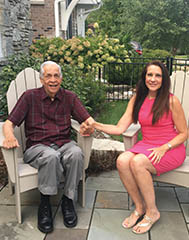 Marci Malzahn with her father Dr. Orlando Flores Ponce
Marci Malzahn with her father Dr. Orlando Flores Ponce
By Marcia Malzahn
Last month I dedicated this article to all the moms. This month I want to honor our dads since we celebrate Father’s Day in June. Summer is upon us and it’s a time to get together with family. This year will be a special year to gather since many people haven’t met with family in over a year due to the Pandemic. To honor dads, I thought it would be a great idea to send you off on a mission so you can answer this question: What do you know about your grandfather, great grandfather, or your great-great grandfather? I only know a little bit about my grandfathers and nothing about the previous generations. In the next few weeks, I encourage you to learn something about all of them. You will be amazed at what you will find out.
When I started writing my first book fifteen years ago and told my dad about it, he told me for the first time that my grandpa was also an author and that he had published about fifteen books in Nicaragua! I never knew that until then. And just a few weeks ago I found out that my mother’s ancestors (both paternal and maternal) went to Nicaragua from Andalucia, Spain. I didn’t know that either.
I never had grandfathers because my mom’s dad passed away when she was born so my mom never had a dad. My father’s dad passed away when I was born so I never met him either. Now that my husband is a grandfather, I see how much I missed as a child from never having grandfathers in my life. But I’m glad I’ve had my dad.
If your dad is no longer with you, I encourage you to honor his memory and do something this month that he would have enjoyed doing with you. If you still have your dad, reach out and spend quality time with him this month. If your dad lives far away and it’s not possible to see each other in person, then maybe you can meet virtually as we have been doing. The point is to reach out intentionally and to appreciate your dad.
My dad is now 94 and he lives in Nicaragua with my mom, so I don’t see him often, but we talk almost every day and right now I’m helping him publish his first book! It is a collection of paintings, some of which he’s painted in the last year, and thoughts that he likes from various authors. My dad is a composer and an attorney, and he has been successful at both the artistic side as well as in his profession. He just recently took on painting! I am proud of my dad!
Lastly, if you’ve never had a father or if your dad has been absent in your life, you have your heavenly Father who will always love you and be there for you…He is the “Father to the fatherless…” (Psalm 68:5).
To all of you who are fathers, thank you for all your hard work. Thank you for loving your family and for working hard to get ahead so your children can have bigger opportunities and a better future. Happy Father’s Day!
Marcia is a professional keynote speaker and published author of four books: a daily devotional – Devotions for Working Women, The Fire Within – to help you find your purpose, friendship poems in The Friendship Book, also in Spanish El Libro de la Amistad (poemas de Amistad), and Bring YOUR Shoes to help emerging leaders with tools on how to lead.
You can contact Marcia for speaking engagements through her website at https://crowning-achievements.com/ or email her at mmalzahn@crowning-achievements.com. Marcia Malzahn is also president and founder of Malzahn Strategic a management consulting firm for community financial institutions.
 By Marci Malzahn
By Marci Malzahn
Years before the COVID-19 Pandemic started, I learned ten strategies to work from home efficiently that may help you too. Seven years ago, I left my twenty-three-year banking career to start my own consulting business, pursue my professional speaking career, and continue writing books. But it took me years to get used to working from home by myself.
If you were one of the millions of workers who found themselves working from home, you had no preparation time and probably went through a difficult period of adjustment—especially if you had small children at home. Though my children are grown, my husband and I started watching our grandson weekly so, in a way, we were also forced to adjust our schedule. Regardless of your situation, these strategies may help you become more effective at what you do.
1) Get organized: Organization starts in your mind and it takes practice to become better organized. Choosing the right method or system is crucial to help you stay on track.
2) Make lists: Write everything down—from ideas and thoughts about specific projects to the detailed tasks that must be done daily. That way the tasks will not only get done but you will have the satisfaction of crossing them off your list.
3) Create checklists: If you find yourself repeating certain tasks, create a checklist template where you list all the detailed steps for that process. For example, I created checklists for speaking events, onboarding consulting clients, and publishing books.
4) Make decisions: Whether you are working for yourself or in a job, you need to be assertive and make decisions timely and effectively with the information you have at hand. Regardless of where you are working from, if you are in a leadership position, your employees expect you to continue making decisions as if you were onsite.
5) Prepare mentally to be alone: Due to the Pandemic, almost the entire world was forced to work from home without proper planning. As a result, many workers were not ready to handle the emotional part of working remotely. Take the initiative to reach out to your co-workers and business colleagues, continue your sales efforts, and talk to friends too.
6) Find efficiencies: We talk about finding efficiencies at work but we need to implement efficiencies in your homelife as well. For example, do laundry during business hours, order groceries online, and cook several meals at a time and freeze some for later.
7) Stay focused and avoid interruptions: Even when you work alone, the cell phone and emails will be your main distractor. Sometimes you will need to turn off your cell phone and email notifications too.
8) Use technology: Conduct virtual meetings when possible. Now that everyone is used to virtual meetings, take advantage of this incredible efficiency this change brought to us. Schedule virtual meetings that don’t need to be necessarily done in person. Reserve the in-person meetings for special occasions. If your job requires traveling, choose your trips wisely and use technology when appropriate.
9) Time blocking: It is important to intentionally block chunks of time to work on specific projects. Doing so will help you avoid interruptions.
10) Schedule breaks and an “end of day” time: Your body and mind need breaks to help you stay productive. It is also important to know that even though your office is in the home, you have an end time to transition from work to home life.
I hope these strategies will help you work from home efficiently and effectively so you can work successfully from wherever you are. Mothers around the world who have had to work from home are struggling to balance the work from their job and the home while taking care of small children. I want to thank all the mothers who make daily sacrifices for their families. Your efforts will produce fruit and your sacrifices will pay off. Happy Mother’s Day!
Marcia is a professional keynote speaker and published author of four books: a daily devotional – Devotions for Working Women, The Fire Within – to help you find your purpose, friendship poems in The Friendship Book, also in Spanish El Libro de la Amistad (poemas de Amistad), and Bring YOUR Shoes to help emerging leaders with tools on how to lead.
You can contact Marcia for speaking engagements through her website at https://crowning-achievements.com/ or email her at mmalzahn@crowning-achievements.com. Marcia Malzahn is also president and founder of Malzahn Strategic a management consulting firm for community financial institutions.
 By Marci Malzahn
By Marci Malzahn
We made it one year through the Pandemic and we’re still here. I want to extend my deepest condolences to those of you who lost a loved one during the past twelve months. This month, I encourage you to continue your journey, continue the fight, and stay strong in your faith. Never give up believing in God!
Below is one of the daily devotionals from my book Devotions for Working Women: A Daily Inspiration to Live a Successful and Balanced Life that I thought it would be appropriate for this month’s message:
All Things Are Possible If You Believe
Mark 9:23 (NKJV)
Jesus said to him, “If you can believe, all things are possible to him who believes.”
A man brought his child possessed with an evil spirit to the disciples and they were not able to cast it out. At that point, the child’s father, disappointed, told Jesus, “Do something if you can.” Then Jesus replied, “If you can believe, all things are possible to him who believes.” After that, the child’s father said something that moved Jesus. He said, “Lord, I believe; help my unbelief!” The New Living Translation says it this way, “I do believe, but help me not to doubt!” (v. 24).
So often our spirit is willing and wants to believe, we really want to have faith, but our mind is going the other way, trying to rationalize everything and letting in doubt. The human mind is not capable of understanding the things of God. We need to put those thoughts down, believe with all our hearts, and ask God to help us believe. He is so merciful He even helps us believe when He knows we are trying our best and sincerely want to. Proverbs 3:5-6 (NLT) say, “Trust in the Lord with all your heart; do not depend on your own understanding. Seek his will in all you do, and he will direct your paths.”
Don’t stop believing for what is in your heart. Seek God with all your heart, mind, and soul, and He will help you. Remember, all things are possible to those who believe.
Marcia is a professional keynote speaker and published author of four books: a daily devotional – Devotions for Working Women, The Fire Within – to help you find your purpose, friendship poems in The Friendship Book, also in Spanish El Libro de la Amistad (poemas de Amistad), and Bring YOUR Shoes to help emerging leaders with tools on how to lead.
You can contact Marcia for speaking engagements through her website at https://crowning-achievements.com/ or email her at mmalzahn@crowning-achievements.com. Marcia Malzahn is also president and founder of Malzahn Strategic a management consulting firm for community financial institutions.
 By Marci Malzahn
By Marci Malzahn
Knowing the nine competencies your successors must possess is crucially important for the continued success of your organization—especially if you are in senior leadership. At some point in your leadership journey, you will encounter the task of choosing your successor.
So how do you choose your successor? Leadership transition is happening across America as the “legacy workers” exit the workplace into retirement. And the biggest challenge your organization may face is that several of the top leaders are leaving at the same time! Often top leaders look for emerging leaders who possess same characteristics as they do, and some may focus more on the specific technical skills to do the job. However, I encourage you to look for the nine competencies your successors must possess to succeed you first and then train them on the specific technical skills if needed. As they say, “they have big shoes to fill,” and you want to help them be successful.
1. Vision: Successors must possess a sense of vision of where they want to take the organization, division, department, or team. Without vision they will not have the passion or enthusiasm to lead.
2. Leadership Ability: They must be able to influence others and inspire others to follow them as their leader. Some people have the natural talent to lead; others need to work at it. But everyone can become a better leader.
3. Ethics and Integrity: These qualities are the foundation to any leader in any company. If you find a successor who possesses these character traits, you’re already ahead of the game.
4. Big Picture: They need the ability to zoom out and see the big picture as well as zoom in and see the details that can turn opportunities into a competitive advantage for the organization.
5. Communication: Successors must have the ability to communicate up, down, and across the organization. The best communicators are also connectors of people which drives results.
6. Personality: The successor’s personality must fit the job their filling. There is no right or wrong personality but there is the right or wrong personality for a particular job, and we all recognize that.
7. Presentation and Eloquence: Successors need to be able to present confidently to various audiences—from the Board of Directors to the entry level staff members. They must communicate and present with eloquence yet be humble in the way they communicate.
8. Resilient: Being able to not only embrace change but also to create change as the customers’ needs change benefits and impacts all stakeholders.
9. Strategic: Successors must be strategic thinkers to recognize when the right opportunities present themselves and how to execute on the new opportunities successfully. They also need to be strategic on selecting the right team members to execute on the company’s vision.
No one is replaceable as individuals because we are all unique human beings. But you can replace yourself with someone who will take the organization to the next level and feel good about it. Excellent leaders choose excellent successors. And you should be proud to leave the organization in better hands than when you were there without taking away your own valuable contributions throughout the years.
Once you have selected a successor who possesses the eight competencies above, you can then assess the next level of requirements that include education, management experience, technical expertise, and negotiation skills, among others. There are several excellent training opportunities you can send your emerging leaders and/or successors to such as the Dale Carnegie Leadership Institute. You can also give them books such as my latest book, Bring YOUR Shoes: A Fresh Perspective for Leaders with Big Shoes to Fill to help them grow as leaders.
I wish you the best on your quest for your successors! I assure you if you focus on the nine competencies your successors must possess first, the rest of the journey will be easier.
Marcia Malzahn is president and founder of Malzahn Strategic a community financial institution consultancy focused on strategic planning, enterprise risk management, treasury management, and talent management. Marcia is a professional keynote speaker and published author of four books.
You can contact Marcia for speaking engagements through her website at https://crowning-achievements.com/ or email her at mmalzahn@crowning-achievements.com You can purchase Marcia’s books at Malzahn Publishing or Amazon.
 By Marci Malzahn
By Marci Malzahn
Dear Friends,
We are living in troubled times where confusion, uncertainty, and chaos has become the normal. The New Year typically brings new expectations, excitement, and most importantly, a renewed sense of hope. A hope that this year “things will be better.” This year “I hope to get this or that done.” This year “I’ll get my dream job” and this year I will “travel to my dream places” and so on.
But I don’t hope for any of those things... My hope is not in a man nor woman, a president, a country, or a government. My hope is solely in God, my Father. He has rescued me from a deadly earthquake when I was six years old, protected me through a two-year revolution when I was 12-13 years old, gave my family favor during exile in Dominican Republic, protected my family again from a destructive hurricane when I was still 13, and gave us the opportunity to come to America—the land of opportunity and hope! America is still the land of opportunity. But sadly, I don’t consider America to be the land of hope anymore… I am witnessing the same violence, terrorism, and lack of peace as my country of origin, Nicaragua. Things that “only happen in those countries” are now happening right here in our backyard. Therefore, I choose to put my trust and hope in the Lord.
Do you want to help the poor? Feed them and clothe them. But also bring them the Gospel of truth where true hope is found.
Do you want to help a person suffering from depression and suicidal thoughts? Give them love, a listening ear, and share the Good News of the Gospel which is their only hope to live in freedom.
Do you want to help the sick? Pray for them, spend time with them, and bring them hope by sharing about the healing power of God’s forgiveness. Spiritual healing is eternal. Physical healing is temporary.
Hope sustains us to get through tribulations. Faith in God gives us freedom. Believing in the true message of Salvation reconciles us with our Father. Prayer gets us closer to God and allows us to experience Him. Love God and love others.
Therefore, for 2021, I hope for unity, restoration, reconciliation, forgiveness, honesty, truthfulness, healing, and peace among the people. I encourage you to put your hope in Jesus—the only ONE who gave His life so you can have eternal life.
I will leave you with one of the poems I wrote in The Friendship Book:
Believe in your friends.
Pray for your friends.
Love your friends.
Hope with your friends.
That is what friendship is about.
Marcia Malzahn is president and founder of Malzahn Strategic a community financial institution consultancy focused on strategic planning, enterprise risk management, treasury management, and talent management. Marcia is a professional keynote speaker and published author of four books.
You can contact Marcia for speaking engagements through her website at https://crowning-achievements.com/ or email her at mmalzahn@crowning-achievements.com You can purchase Marcia’s books at Malzahn Publishing or Amazon.
 By Marci Malzahn
By Marci Malzahn
As we entered the new decade—2020—we were looking forward to new adventures in our lives, new jobs, new places to visit around the world, celebrating big accomplishments and special birthdays with our loved ones. But all our dreams and plans for 2020 were shuttered in a matter of days. We now have a choice to make: We feel sorry for ourselves pondering on everything we lost this year. Or we choose to see the positive experiences and lessons learned throughout this year as we lived through the COVID-19 Pandemic, the riots in many of our cities, and an unforgettable presidential election process.
Let’s choose to see the positive and reflect on everything we learned this year. Below are the top 10 lessons we learned together in 2020:
Resiliency. One of the biggest lessons we learned is to be resilient. Businesses had to change the old way of doing things from one day to the next. Employees had to learn to work from home with the pets and children around and without having the proper equipment or office setup. As we continue to live through the Pandemic, we are now more prepared to pivot on a moment’s notice. If something doesn’t work out, that’s ok, we move to the next option. This new or polished skill of resiliency will serve us well for the rest of our lives.
Creativity. We had to become more creative at everything we do on a daily basis—from how we buy groceries to how we stock food in our houses—especially how to creatively buy more toilet paper! Event planners created new ways to do their conferences using various systems. Speakers had to adapt to whatever system the event planners had to offer and attendees had to learn to “unmute.”
Compassion. As we observed how the world changed around us and how much suffering people were facing, most of us felt compassion for strangers. This global Pandemic opened our eyes to the see the entire world as one humanity. This virus attacked everyone and is not respecter of persons regardless of background, age, political views, religion, or culture. Yes, there are specific groups of people who are more vulnerable to dying but the virus doesn’t know that. It attacked wherever there was an open door to move into.
Empathy. We became more empathetic for people who are more vulnerable to the virus or if they live with a person who is at higher risk. We empathized with parents of young children who had to work while trying to help their children with schoolwork.
Resourceful. Companies took their retired computers from the closets and put them to work again. These systems may not be the fastest, but they worked okay for employees to be able to continue serving customers from home. At the personal level, many people made masks not only for their own families but gave them away to others in need.
Technology. Everyone had to up their game using technology. People who refused to use technology now were forced to do their banking on their phones, call their grandchildren on FaceTime, Google Duo, WhatsApp, or Zoom. Businesses that were waiting on the edges to upgrade systems or use new technologies were forced to invest in technology now or be out of business completely. Digital payments are now the new way of paying each other or purchasing goods. Also, because of technology, several vaccines are coming out in a record time to help humanity fight and end this Pandemic.
Generosity. Even though nonprofit organizations that help people were not able to meet in person to raise funds, they used creativity, technology, and resourcefulness to attract donors to their causes. People became more generous in the effort to help other human beings in need.
Efficiency. Businesses became more efficient in their processes. What before took twenty steps to complete, now may only take ten steps. Unnecessary steps and approvals had to be removed from the process in order to expedite service to customers and simply to survive as a business. Business leaders had to trust their employees and empower them with more authority to complete tasks while still complying with regulations that apply to their industries.
Prioritize. We learned to prioritize our activities based on importance and risk exposure. We chose to continue some commitments and drop the less important ones. What’s most important in our lives surfaced to the top of the list. All the other superficial activities went by the wayside.
Faith. Most importantly, this year was a time to seek God—for some people for the first time in their lives. Despite the terrible circumstances we all went through this year, God has always been there waiting for us to ask for help and to invite Him into our lives. Faith is what sustains us through tribulations.
So, you see, in the midst of a global Pandemic we can come out ahead. Yes, we lost a lot and some of us lost loved ones to the disease which is the highest price to pay. Yet we can still move forward and learn lessons that will carry us through the rest of our lives. From all the lessons we learned listed above, the most important to remember is faith. I will leave you with this Scripture that sums it all up:
John 16:33 (KJV)
These things I have spoken unto you, that in me ye might have peace. In the world ye shall have tribulation: but be of good cheer; I have overcome the world.
Be of Good Cheer. Merry Christmas and Happy New Year!
Marcia Malzahn is president and founder of Malzahn Strategic a community financial institution consultancy focused on strategic planning, enterprise risk management, treasury management, and talent management. Marcia is a professional keynote speaker and published author of four books.
You can contact Marcia for speaking engagements through her website at https://crowning-achievements.com/ or email her at mmalzahn@crowning-achievements.com You can purchase Marcia’s books at Malzahn Publishing or Amazon.
 Painting by Isa Tyler, Poneloya Beach, Nicaragua
Painting by Isa Tyler, Poneloya Beach, Nicaragua
By Marci Malzahn
During the past six months our world is no longer what it used to be. Everything has changed—from the way we work, how kids go to school, sports, to the way we act in terms of safety and social gatherings. But I have good news for you! God has not changed. The world will continue to change and we will need to continue to adapt but God and His love for us never changes—ever! The Bible reminds us of this promise on Hebrews 13:8 that “Jesus Christ is the same yesterday, today, and forever.”
The Bible also tells us on Matthew 7:24-27 to:
Build on a Solid Foundation
“Anyone who listens to my teaching and follows it is wise, like a person who builds a house on solid rock. Though the rain comes in torrents and the floodwaters rise and the winds beat against that house, it won’t collapse because it is built on bedrock. But anyone who hears my teaching and doesn’t obey it is foolish, like a person who builds a house on sand. When the rains and floods come and the winds beat against that house, it will collapse with a mighty crash.”
We can easily insert the word “Pandemic” in the verse above as the “floodwaters” and the “rains” and the “floods” and the “winds” all represent life disasters that can destroy our lives. When calamity comes—and it will because we live in the world—we must be ready by standing firm on our foundation, by being anchored in God and His promises.
As you continue adjusting to a new work environment, your kids’ school schedules, and “your new normal,” I encourage you to not give up on believing. Stay strong through these difficult times because God is right there with you every step of the way. Reach out to others who may need help and encouragement. Reach out for help if you’re feeling lonely or isolated. This is the time to walk together with others too and not try to survive the storm by yourself.
God is my anchor and my rock. And I’m standing firm on this foundation. I encourage you to do the same. I will leave you with this poem from one of my books The Friendship Book: Because You Matter to Me to brighten up your month:
Friends are gifts from heaven and they all come in different seasons of our lives. Some come in the spring during our childhood. Some join us in the summer during our teen years. Others find us in the fall in our mature years. Yet others join our journey during our winter. But they are all important and significant in our lives. Hopefully we keep our friendships and walk all the seasons together as we walk our path of life.
Marcia Malzahn is president and founder of Malzahn Strategic a community financial institution consultancy focused on strategic planning, enterprise risk management, treasury management, and talent management. Marcia is a professional keynote speaker and published author of four books.
You can contact Marcia for speaking engagements through her website at https://crowning-achievements.com/ or email her at mmalzahn@crowning-achievements.com You can purchase Marcia’s books at Malzahn Publishing or Amazon.

With distance learning plans rolling out across the country due to the coronavirus, Comcast today announced a new program for cities, schools, and nonprofits to connect large numbers of low-income K-12 students to the Internet at home. The “Internet Essentials Partnership Program” is designed to help accelerate Internet adoption at a critical time. In nearly ten years, Internet Essentials has become the nation’s largest and most successful low-income Internet adoption program and has connected millions of people to the Internet. It offers households low-cost, broadband Internet service for $9.95/month, the option to purchase a heavily subsidized computer, and multiple options for digital literacy training. Comcast also announced today it is giving all Internet Essentials customers its innovative xFi platform, which enables parents to control and manage their children’s WiFi connected devices
The new “Internet Essentials Partnership Program” (IEPP) enables cities, schools, and nonprofits to collaborate to help fund and connect large numbers of K-12 students with broadband Internet service and devices like laptops and tablets. Since the start of the COVID-19 pandemic, the program has already signed up more than 70 schools across the country, including seven here in the Twin Cities. Comcast continues to offer new Internet Essentials customers two months of free Internet access if they sign up before the end of 2020. Comcast also continues to forgive any back debt due so more families can apply.
All Internet Essentials customers now have free access to Comcast’s innovative xFi platform, which enables parents to control and manage their family’s WiFi connected devices, set safe browsing modes so children can only access age-appropriate content, and pause devices for dinner or bedtime.
Comcast announced plans to convene a series of virtual national and regional summits this fall to help tackle the challenges of broadband adoption.
For more information, please see the attached press release or go to www.comcastcorporation.com. Thanks, as always for your interest and partnership, and please feel free to reach out with any related questions.
 Protect Yourself
Protect Yourself
By Minnesota Department of Health
The federal government has issued some new guidance on the use of cloth face coverings to help slow the spread of COVID-19. CDC recommends wearing cloth face coverings in public settings where other social distancing measures are difficult to maintain (e.g., grocery stores and pharmacies).
Here are a few important things to keep in mind:
• Masks or cloth face coverings can help with preventing your germs from infecting others – especially in situations where you may spread the virus without symptoms.
• Wearing a mask does not protect you from others who may spread the virus. So, whether or not you wear a mask, you still need to wash your hands frequently, cover your cough, and practice social distancing by keeping at least 6 feet of space between people.
• People who are sick should still stay home. Wearing a mask does not mean people who a sick should go out into the community. If you are sick and need to go to the doctor, call your health care
provider before going in and wear a mask to the clinic.
• Don’t buy or wear surgical or N95 masks. These supplies are in high need in health care facilities to protect health care workers.
• Cloth face coverings should not be placed on young children under age 2, anyone who has trouble breathing, or is unconscious, incapacitated or otherwise unable to remove the mask without assistance.
Symptoms of COVID-19
People with COVID-19 have had mild to severe respiratory illness with symptoms of:
• fever
• cough
• shortness of breath
Some patients have had other symptoms including muscle aches, headache, sore throat, diarrhea, or loss of taste or smell. These symptoms may appear 2-14 days after exposure.
 Left: Rosa Tock, Executive Director
Minnesota Council on Latino Affairs
Left: Rosa Tock, Executive Director
Minnesota Council on Latino Affairs
In these trying times the Minnesota Council on Latino Affairs (MCLA) remains steadfast in its commitment to providing a voice for the Latino community and will continue to assist the governor, state agencies, legislature, and our community partners to ensure the health and safety of all Minnesotans.
Our staff has been in contact with various state agencies and the legislature to offer and compile information on the impact of this emergency to Latino communities. Additionally, we have been supportive of community partners who provide vital services to our constituents in their outreach efforts. MCLA’s team is complying with social distance and working remotely as much as possible, until further notice based on guidance by the state of Minnesota. However, our staff remains accessible to the public as we diligently work to serve our community.
We have launched a new page on our website that is intended to provide resources and information to the community. It is our intent to provide translated materials in Spanish as quickly as possible. We anticipate providing weekly updates so please visit it frequently. Please visit:
https://mn.gov/mcla/community/resources---recursos-covid-19.jspMCLA’s legislative priorities will adapt to the most emergent and necessary priorities as identified by community and our governmental stakeholders during this emergency.
As this emergency unfolds, and in order to ensure that public health measures impact all cultural communities, MCLA strongly recommends that:
• Official statements and resources from the state be made available in
multiple languages
• Emergency measures are reviewed with an equity lens
• Essential programs and services are made available to all of us who live in
Minnesota
In the meantime, to reinforce the advice from public health officials regarding what we can all do to help suppress the spread of the Covid-19, we continue to stress: stay home, call your doctor before going to a clinic or an emergency room, practice social distancing, and keep all surfaces clean, including regularly washing your hands, and avoid touching your eyes and face.
For more information and updates from the state on COVID-19 please visit the following websites:
Minnesota Department of Health: information in English
https://www.health.state.mn.us/diseases/coronavirus/index.html
COVID-19 Hotlines:
Health questions:
651-201-3920 or 1-800-657-3903
7 a.m. to 7 p.m.
Schools and child care questions:
651-297-1304 or 1-800-657-3504
7 a.m. to 7 p.m.
 La Semana Nacional de Elección de Escuela
La Semana Nacional de Elección de Escuela
El empoderamiento de los padres y la ayuda a los niños a cumplir sus sueños.
La Elección de escuela significa el darles a los padres de familia el acceso a las mejores opciones educativas K-12 para sus hijos. Estas opciones no únicamente incluyen escuelas tradicionales públicas, escuelas públicas charters, escuelas públicas magnet, si no también escuelas privadas, academias en línea y estudios desde casa.
Cada niño merece una educación efectiva, que los rete y que a su vez los motive. Los estudiantes de hoy son los líderes del mañana, por lo tanto, los niños deben de tener la oportunidad de lograr su propio sueño Americano.
Muchos estudios confirman, que cuando los padres son empoderados a elegir el ambiente educacional para sus hijos este funciona de manera optima, los estudiantes tienen más posibilidades de ser exitosos y los mas importante, graduarse de high school. Cada niño es único, y los estudiantes se desarrollan mejor cuando sus necesidades individuales han sido empatadas con el ambiente educativo.
Sobre la Semana Nacional de Elección de Escuela (NSCW)
En la Semana Nacional de Elección de Escuela (NSCW por sus siglas en Inglés) que se lleva acabo cada enero se destaca la importancia de las opciones de educación para los niños. Durante la NSCW, escuelas, grupos de estudios en casa, organizaciones e individuos realizan decenas de miles de eventos independientes.
Estas festividades buscan el incrementar el conocimiento público sobre las diferentes opciones educativas (K-12) disponibles para los niños y sus familias, y al mismo tiempo el hacer destacar los beneficios de la elección de escuela. NSCW reconoce todas las opciones K-12, las cuales incluyen las escuelas públicas tradicionales, las escuelas públicas charters, las escuelas públicas magnet, las escuelas privadas, las academias en línea y la realización de los estudios desde casa.
En 2011 se comenzó este esfuerzo, en la actualidad la NSCW es el evento anual de oportunidades educativas mas grande del mundo.
En los últimos siete años mas de 58,000 eventos de NCSW han sido organizados a lo largo del país y alrededor del mundo. NSCW es un esfuerzo para el concienciación publico, no partidista, apolítico, independiente. Por lo tanto no estamos asociados con ningún esfuerzo legislativo o de cabildeo.
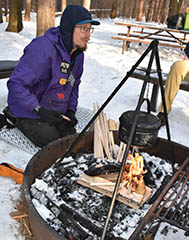 Pictured left: Warming up by the fire
Pictured left: Warming up by the fire
Wayne Boerner has a little secret he’d like to share with anyone who enjoys camping, but likes to get away from all the other people that one sometimes finds at popular campgrounds.
Try it in winter.
“Whoa!” you might say. “Camping in winter in the cold and the snow? I’ll freeze my butt off!”
Not if you take time to learn how to do it, says Boerner, an avid winter camper and manager at William O’Brien State Park. And the rewards are many, from accomplishing something that might seem beyond reach, to experiencing nature in a new and different way. On top of all that, there are no mosquitoes, ticks, or poison ivy!
“I love winter,” says Boerner, “The solitude, the serene settings, the views, the animals – it’s a totally different perspective. It slows life down a little. And places that are heavily used in summer are quiet in winter.”
So what do you need to do and know to enjoy winter camping? The most important thing is to plan for how you’re going to stay warm. That means dressing in layers, says J.R. Hunte, an outdoor skills instructor who teaches classes in winter camping at the Bloomington REI. Start with a tight-fitting base layer made of something like merino wool or a synthetic fiber, then a heavier layer such as fleece or an insulating jacket, and over that a waterproof shell to keep you dry. Long johns and water-resistant pants will keep your bottom half warm. Cotton should be avoided because it holds onto moisture and sweat, and when your clothes get damp, you get cold. Make sure you have good insulated boots and a couple layers of socks to keep your feet warm, as well as good mittens or gloves.
State parks are a good place to get started, with 25 offering some winter camping (including William O’Brien and Afton state parks in the metro region). If there’s no snow in the forecast, you can probably get by with a regular three-season tent, because a tent is more about keeping you dry than keeping you warm. In snowy conditions, a winter tent is needed to bear the weight of the snow. Boerner sometimes just digs out a rectangular area in the snow big enough for a sleeping bag, spreading one end of a tarp on the bottom under his sleeping pads and bags, then pulling the other end of the tarp over the hole after he crawls in for a cozy sleeping chamber.
In summer camping, a good sleeping pad provides cushion against the hard ground; in winter, pads are necessary to prevent one from losing too much heat to the snow under your sleeping bag. Hunte recommends doubling up pads for more insulation. A good sleeping bag rated for cold weather also is important. Down bags are lightweight and provide excellent insulation, but they can be costly and if they get wet lose their insulation value. A synthetic bag with a liner can work fine. Some people put one bag inside another for extra insulating power. Hunte says it’s a good idea to build a big fire and get warmed up before crawling into your bag at night. He also recommends eating a snack such as a granola bar before retiring and taking a couple plastic water bottles filled with hot water into your bag with you.
Boerner sees an average of about 500 campers each winter at O’Brien, just north of Stillwater. About 70 percent of those stay in a trailer or RV or some type of hard shelter, while the other 30 percent stay in tents, sleep outside, or build a quinzhee by piling up snow and digging out a small cave to sleep in.
Both Boerner and Hunte recommend easing into winter camping. Try an overnight outside in your backyard to see how your equipment works. Reserve a camper cabin or a yurt at one of the Minnesota state parks that offers them.
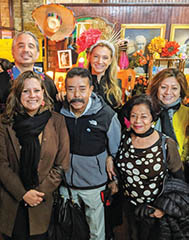 Pictured left: Enjoying the opening reception at the festival
Pictured left: Enjoying the opening reception at the festival
By Claud Santiago and Rick Aguilar
Cine Latino, the region’s only showcase of Latin American and Ibero cinema, featured a rich tapestry of narrative and documentary films from across the globe from some of the world’s most acclaimed and up-and-coming Spanish- and Portuguese-language filmmakers. Cine Latino was enriched by the presence of visiting filmmakers and community events, featuring Ibero and Latin food and music. MSP Film Society developed Cine Latino in collaboration with members of the diverse Spanish-speaking communities in Minnesota, and curates the annual series of films from countries with rich filmmaking histories and cutting-edge film industries in collaboration with Argentinian guest artistic director Hebe Tabachnik.
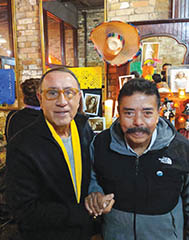
Rick Aguilar with Don Manuel Manrique Zapata, the grandson of Mexican revolutionary legend Emiliano Zapata who coined the phrase “Viva Zapata!”
Don Manuel was a guest from Mexico as part of the film, The Last Zapatistas, Forgotten Heroes. I was able to visit with Don Manuel...an amazing conversation!
More relevant now than ever, and firm in the MSP Film Society’s belief of the unique power of cinema to invigorate, inspire and help to change the world one film at a time, this year’s Cine Latino’s Focus was dedicated to “Cinema with a Conscience”, a wide-ranging selection of films that highlight social, political, environmental justice and activism.

The next time you see a wild turkey, offer a silent thank you to the state of Missouri. Yes, Missouri. Also, consider a quiet thanks to the Department of Natural Resource wildlife specialists who trapped, moved, and ultimately helped reintroduce the once overhunted birds to the state.
The success story started with a trade, said Lindsey Mesinger, a wildlife research biologist with the DNR. In the early 1970s, the DNR traded a flock of its home grown ruffed grouse for 29 turkeys from Missouri. The Missouri-born birds were released in Houston County in southeastern Minnesota.
Not long after the Missouri swap, the wild turkey population “took off pretty quickly,” Mesinger said. By the late 1970s, Minnesota held its first turkey hunt. Today there are no restrictions on the number of turkey hunting permits that are issued; the wild turkey population numbers well more than 70,000. The birds live in nearly every part of the state, aided by Minnesota’s warmer winters.
They were also aided with transport in the early days by people like Bob Tangen, who is a retired assistant wildlife area manager at Whitewater State Park. The original Missouri flock flourished quite well in Houston County, and to speed up that process of expansion, DNR staff trapped the birds with nets and moved them up to 50 miles to a new habitat. In the winter months from 1976 to 1978, Tangen and Gary Nelson, a turkey biologist, captured 20 to 25 turkeys at a time with a rocket net. They located a turkey flock and put corn down to attract the birds. The men waited nearby in a blind. For two or three days they corn fed the turkeys.
Then one day as the birds enjoyed their corn feast with all heads down, pecking away, a rocket launched which draped a large net over the flock. Tangen and Nelson then threw blankets on the terrified birds, to calm them, and then pulled them from the net and placed the turkeys in crates. The birds were outfitted with a tiny beeping backpack with an antenna that tracked their movement.
Tangen said he grew pretty fond of turkeys over time, but added that winter weather conditions could be “brutal” at times. Waiting for turkeys in a blind when it was 10 degrees below zero presented challenges. “When you’re young, you can do that work,” he said.
Now when Tangen sees turkeys in the wild, he is reminded that the stories of their resurgence in Minnesota is a true wildlife success story. For years wildlife specialists presumed the birds only thrived in oak forests where they fed on acorns. With the exception of northeastern Minnesota where winters are still severe, turkeys will go almost anywhere they can find food. Males can weigh up to 30 pounds, hens weigh about 10 to 12 pounds, Tangen said.
Since turkeys are the largest game bird in the U.S., it makes you wonder if hunting turkeys poses any challenge at all since the targets are huge and fly infrequently. Lindsey Mesinger hunts turkeys, and said that they have a few defenses like running fast. Their coloring acts like an effective defensive camouflage, and they tend to avoid people. Wild turkey season occurs twice each year in the spring and fall. The 2019 wild turkey hunt season ended Oct. 27.
The birds roost in trees at night, and display a style of social behavior when gathered as a group, Mesinger said. When she hunts in the morning hours before the sun rises, she enjoys the vocalization from treetops.
That the birds are back is a clear success story, Mesinger said, and shows good wildlife conservation and stewardship. Many partnering turkey advocates aided in their return, including members of the National Wild Turkey Federation who helped transport the flocks to new habitats.

By Marci Malzahn
On a gloomy winter day in 1996, I found myself in a large, dark, rectangular office. My desk was at one end of the office, and way at the other end was the window to the Crystal Court of the IDS building downtown Minneapolis, Minnesota. I sat at my desk as the new branch manager of a bank. And the desk was empty. There was nothing in the drawers. And I had no one to help me start my new job as a first-time manager.
While I was very appreciative that my boss believed in me and gave me this tremendous opportunity to lead people for the first time in my career, the feeling of inadequacy kicked in and I felt the anxiety rising within me. I thought to myself: Don’t panic. Be humble. It’s okay not to know everything. You are here to learn and to lead. The downtown office of this bank had been without a manager for three months. The employees were directionless, scared, and confused. My job was to pick up the pieces and lead them into the future.
I had three things against me: I was young and female with no supervisory experience. I was only twenty-nine years old, and I was the only female among thirty-three male branch managers in this bank. But I had two things going for me: First, I had formed excellent relationships with other leaders in the organization that I knew would be willing to help me. Second, I wasn’t afraid to ask questions. It took humility and courage to admit that I didn’t know everything to do this job. So I made a list of all those people and started calling.
This job as a first-time manager was the hardest job I had encountered up to that point in my career. Compared to my boss and the president of the bank, I had “big shoes to fill.” But I made a decision from the start, instead of trying to fill someone else’s big shoes, I was going to be myself and fill my own shoes, or better yet bring MY shoes! I knew I had talent and the team I inherited also had talent, so together we could make a good team and move forward.
If you find yourself in a similar situation, my new book Bring YOUR Shoes: A Fresh Perspective for Leaders with Big Shoes to Fill may just be what you’re looking for to help you succeed in your first-time supervisor or manager role. I wish someone had put this book as a gift to me in one of those empty desk drawers. But now you get everything that I have learned in my twenty-plus years as a leader and the wisdom of the leaders I interviewed in this book. As I previously shared, it took humility and courage to admit I didn’t know everything and to ask lots of questions. It also took self-confidence to “bring my shoes.” I hope this book inspires you to do the same as a new leader. I encourage you to avoid comparing yourself to others, and to Bring YOUR Shoes.
Marci Malzahn is president and founder of Malzahn Strategic a community financial institution consultancy focused on strategic planning, enterprise risk management, cash management, and talent management. Marci is also a professional speaker and published author of four books. You can contact Marci for speaking engagements through her website at www.marciamalzahn.com or email her at marcia@marciamalzahn.com. You can purchase Marci’s books at Malzahn Publishing.com or Amazon.
More about book Bring YOUR Shoes: A Fresh Perspective for Leaders with Big Shoes to Fill: At the beginning of a leadership journey, it is important to bring the right tools, methods, and mind-set to conquer the leadership mountains you’ve chosen to climb. Most importantly, you need a guide. Bring YOUR Shoes is that guide.
A series of self-discovery exercises help new leaders learn your abilities, skills, gifts, and personality type. By knowing yourself, you’ll better discover the unique traits in the people you lead. This combination of talents is the foundation for success in a new leadership position.
Bring YOUR Shoes teaches how to lead from a fresh perspective—by maximizing your talents and the talents of those you lead. Whether you lead a small team or a multinational organization, Bring YOUR Shoes will help you conquer your mountain.
 Los padres no tienen que ser
expertos en todo pero sí deben
estar dispuestos a ayudar
Los padres no tienen que ser
expertos en todo pero sí deben
estar dispuestos a ayudar
Hay muchas cosas que los padres pueden hacer para ayudar a sus hijos en su regreso a la escuela, como reemplazar la mochila vieja o comprarles los útiles que necesitan. Pero hay algo que pueden hacer que es más importante y no siempre cuesta dinero: ayudarlos con la tarea.
Hay muchas cosas que los padres pueden hacer para ayudar a sus hijos en su regreso a la escuela, como reemplazar la mochila vieja o comprarles los útiles que necesitan. Pero hay algo que pueden hacer que es más importante y no siempre cuesta dinero: ayudarlos con la tarea.
• Hablar con los hijos sobre la tarea. Es importante que los niños entien- dan la importancia de hacer la tarea y el impacto positivo que puede tener en sus calificaciones. Además de repasar y practicar lo que aprendieron en clase, la tarea los ayuda a prepararse para las lecciones del día siguiente y desarrollar la disciplina que necesitan para su éxito académico.
• Reunirse con los maestros. Cuando se trata de la tarea, los maestros pueden tener exigencias distintas. Por lo tanto es importante hablar con ellos para conocer sus expectativas. Por ejemplo, algunos maestros quieren que los padres revisen cuidadosamente la tarea de sus hijos, mientras que otros prefieren que sólo controlen que la hicieron. Además, el maestro puede contestar preguntas como cuánto tiempo debe pasar el estudiante haciendo la tarea y qué hacer si tiene dificultades o si le resulta demasiado fácil.
• Fijar un horario para hacer la tarea. El mejor momento para hacer la tarea es el que mejor funciona con las actividades del estudiante y la disponibilidad de sus papás. Puede ser antes o después de jugar, ver televisión, cenar o de hacer alguna actividad extracurricular. Lo importante es que la hora sea constante y que no sea la última actividad del día, cuando el niño esté cansado y con sueño.
• Escoger un lugar cómodo y eliminar las distracciones. Para fomentar la concentración es importante encontrar un lugar en la casa que tenga buena iluminación donde el niño pueda sentarse y hacer la tarea sin distracciones. Puede ser la mesa de la cocina, un escritorio o su propia habitación, siempre y cuando no haya distracciones como televisores prendidos o aparatos electrónicos a mano, a menos de que sean esenciales para hacer la tarea.
• Proveer los recursos necesarios. Los padres no tienen que ser expertos en todas las materias para ayudar a sus hijos con la tarea. Sin embargo, pueden proveerles los recursos que necesitan, incluyendo lápices, plumas, borradores y papel para escribir.
También pueden llevar a sus hijos a la biblioteca o navegar el Internet con ellos para encontrar recursos que ayuden con la tarea. GobiernoUSA. gov, por ejemplo, tiene una sección de niños con información práctica sobre varios temas. Por su parte, el Departamento de Educación cuenta con una serie de folletos para ayudar a los hijos con la tarea de matemáticas, ciencias, lectura y comprensión.
Para aprender más sobre temas relacionados a la educación se recomienda consultar GobiernoUSA.gov, el portal oficial del Gobierno de los Estados Unidos en español, que forma parte de la Administración de Servicios Generales (GSA) de EE. UU. Fuente: GobiernoUSA.gov
Photo: (c) Getty Images, Jupiter Images
By Craig Peters
There’s no place like home to start and finish a season.
The Vikings on Wednesday released their 2019 regular-season schedule, a slate that will kick off at noon (CT) Sept. 8 against the Falcons at U.S. Bank Stadium.
This will be the third consecutive season for Minnesota to open at home. The Vikings defeated the Saints in 2017 and the 49ers in 2018 to start each campaign with positive momentum.
The regular-season finale will involve the Vikings hosting the … wait for it … Bears for the fourth consecutive season, fifth time in Head Coach Mike Zimmer’s six seasons, and sixth time this decade.
A new twist this season, however, is that the Dec. 29 contest will be preceded by the Vikings hosting the Packers on ESPN’s Monday Night Football, making this the first time for Minnesota to close with back-to-back home games since 2008. That edition of the Border Battle is one of five that is scheduled to air in prime time. The others are against Washington (Oct. 24 on NFL Network’s Thursday Night Football), at Dallas (Nov. 10 on NBC’s Sunday Night Football), at Seattle (Dec. 2 on Monday Night Football) and at the Los Angeles Chargers (Dec. 15 on Sunday Night Football).
“We’ve got five prime-time games this year, so we’re going to have to do a great job in all those,” Zimmer said during an interview with Vikings.com’s Mike Wobschall. “We’ve got a Monday night at home against Green Bay, so that will be another fun one.”
The Vikings and Packers also will meet in Week 2 at Lambeau Field, renewing the rivalry 364 days after a furious comeback by Minnesota ended in a 29-all tie.
Oakland will visit Minnesota in Week 3, and the Vikings will travel to Chicago to challenge the Bears and New York to face the Giants in consecutive weeks before hosting the Eagles in Week 6.
2019 Minnesota Vikings Schedule
Regular Season
Week 1 | Sunday, Sept. 8 | NOON | vs. Atlanta Falcons | FOX | KFAN/KTLKPreseason
Preseason Week 1 | Friday, Aug. 9 | 7:00 PM CT | at New Orleans Saints | FOX 9 | KFAN/KTLK Pictured left: Scholarship recipient Peter Schik, St. Paul, Como Park High School
Pictured left: Scholarship recipient Peter Schik, St. Paul, Como Park High School
Comcast is proud to honor some of the best and brightest high school graduates in the Twin Cities with a 2019 Leaders and Achievers Scholarship Award. Comcast Leaders and Achievers are students who have been selected for their outstanding community service, academic performance, and leadership skills.
Each $2,500 award, funded by the Comcast NBCUniversal Foundation, is a one-time scholarship to be used toward undergraduate education-related expenses.
This year’s Leaders and Achievers Scholarship Twin Cities recipients include:
Abiola Adegeye, Brooklyn Park – Champlin Park High School
Samira Adan, Minneapolis – Roosevelt High School**
Suad Adan, Minneapolis – Roosevelt High School
Dana Corbin, Minneapolis – DeLaSalle High school**
John Robinson, Minneapolis – Washburn High School
Joquan Williams, South St. Paul – Humboldt High School
Chinmay Sahu, Woodbury – Stillwater Area High School**
Nectaree Thao, St. Paul – Highland Park High School**
Yia Kou Xiong, St. Paul – Washington Technology Magnet School
Yanai Sun, Coon Rapids – Coon Rapids High School
Yusanat Tway, St. Paul – Humboldt High School
Briana Clifton, Coon Rapids – Coon Rapids High School**
Camryn Franke, North St. Paul – Washington Technology Magnet School**
Hannah Frazer, St. Paul – Math and Science Academy**
Peter Schik, St. Paul – Como Park High School**
Shannon Brault, Richfield – Richfield High School**
Theresia Kramer, Crystal – Chesterton Academy**
Astrid Liden, Eden Prairie – Minnetonka High School
Joseph Kase, St. Paul – St. Paul Academy & Summit School
Madylin Mielke, Inver Grover Heights – St. Croix Lutheran Academy
Since its inception, over $30 million has been awarded to more than 28,000 students through the Comcast Leaders and Achievers Scholarship Program. For more information, go to:
https://corporate.comcast.com/values/community-impact
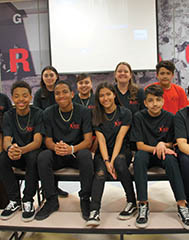 Pictured left: AVID students from Heritage
Pictured left: AVID students from Heritage
By Carrie Ardito
When West St. Paul-Mendota Heights-Eagan Area Schools (District 197) saw graduation rates among all student groups increase in 2018, it was cause to be proud. But when the Latino student graduation rate came in at a 13% increase—a staggering 27% above the four-year state average—it was time to celebrate. “We are fully committed to improving outcomes for our students,” says Superintendent Peter Olson-Skog. “And we are extremely fortunate to have strong Latino families who are actively engaged in their students’ education.”
District 197 provides a wide range of opportunities and support that are ideal for Latino students and their families. ALMAS (Anglos Latinos Motivados A Superarse), a Henry Sibley High School student group founded by Spanish teacher Robert Hanson, is a prime example. According to Hanson, ALMAS was founded with the goal of reducing the high school dropout rate among Latino students. “We believe that for students to succeed we must have strong families, strong schools, and strong students,” Hanson explains. “If we want to improve our graduation rate we have to do something in all three areas.” With that in mind, Hanson started ALMAS, an after-school program that empowers students to become involved in their community while providing their families with access to community resources.
At Garlough Environmental Magnet School, initiatives range from a Native Language Literacy Program and a Spanish Facebook site to a Spanish book backpack program and the addition of hundreds of Spanish books to the school’s library. Xiomara Medina, one of many cultural liaisons and interpreters who work in the district, supports the school’s students and staff.
At Heritage ESTEM Magnet School, 7th and 8th grade students have the opportunity to participate in AVID, a program in the district’s middle schools and high school that is designed to help students develop the skills they need to be successful in college. “AVID has had a significant impact on the school’s culture because it develops our students’ self confidence and self worth,” says Principal Karen Allen. Other Heritage initiatives includes a home visit program operated collaboratively between classroom teachers and EL staff.
From a family perspective, district programs such as Building Bridges and Parent Academy as well as parent-fueled organizations like Padres de Latinos in Action have helped parents and guardians advocate for their children. Carmen Pineda, a cultural liaison with the Early Special Education Program, has been with the Building Bridges program since its inception in 1998. “Our programs have related to parents on a more personal level as partners,” Pineda explains. “The key has been that we have empowered parents through respect, cultural sensitivity, and education.”
Olivia Carillo is a district parent who has participated in a number of district-hosted programs and activities for Latino parents. “The most important challenges are the language and the culture,” she explains. “Through these programs, parents gain tools to support students and become more involved in the school programs.”
The recent increase in graduation rates shines a spotlight on the support Latino students and their families experience throughout their time in District 197 schools and programs. “We have advocates at every level -- teachers who have incorporated strategies they know will work for multilingual students,” explains Andrea Saenz, English Learner and Equity Program Coordinator. “Our programs would not be the same without the committed and passionate staff who are key to their success.”
“The numbers just don’t lie,” says Henry Sibley High School Principal Ron Monson. “When you combine strong, supportive families with school-based resources and opportunities, you are paving the way for student success.”
 Pictured left: Ray Ruiz fishing on a boat in the Mississippi River in Minneapolis
Pictured left: Ray Ruiz fishing on a boat in the Mississippi River in Minneapolis
By Ray Ruiz, Minnesota DNR
If you love angling and want to live in a big city, you couldn’t do any better than the Twin Cities metro region. Bright lights, big fish – we’ve got it all.
That status is largely the result of the region’s quantity and quality of water, which provides a wide variety of angling opportunities. For starters, three of the state’s major rivers converge in the metro region: the Minnesota, Mississippi and the St. Croix. Flowing through the heart of the region, the Mississippi’s northern reaches are well-known as a top-notch bass fishery. Then there’s Pool 2, the area between the dams at St. Paul and Hastings. A few decades ago, it was so polluted that bullheads could barely survive. Now it’s recognized as a world-class year-round catch-and-release fishery for walleye and sauger -- thanks largely to state and local efforts to clean up the river. The St. Croix offers anglers the chance to hook Minnesota’s largest and longest lived fish, the lake sturgeon (both catch-and-release and harvest seasons), along with plenty of smaller fish. All three rivers provide excellent opportunities for catfish, with state records having been pulled from the metro Mississippi and St. Croix.
Numerous smaller rivers and streams flow through the region as well, including the Rum, the Crow and the Vermillion, a designated trout stream with a reputation for harboring lunker brown trout. Check out Rambling River Park in Farmington, where the Vermillion gets stocked with rainbow trout.
The Twin Cities region also features a number of consistently productive large lakes. Waconia, Minnetonka, Prior, Independence and Medicine in the west metro area, along with White Bear, Bald Eagle, Forest, Marine and Coon Lakes in the east metro area all are reliable for yielding up bass, panfish, pike and walleye.
Smaller lakes also abound. Clear Lake in Washington County, for instance, holds good populations of walleye northern pike and hybrid muskies. West of the Mississippi, the Minneapolis Chain of Lakes provides good walleye fishing, especially on Cedar and Harriet, which are regularly stocked. Both lakes are good for shorefishing.
While catching fish oneself is pleasing, watching kids do it can be even more rewarding. The DNR’s FiN program (Fishing in the Neighborhood) stocks catchable size fish in more than 60 smaller bodies of water around the region -- an excellent choice for getting some big grins and squeals of excitement from young anglers (www.MNDNR.gov/FiN). Consistent producers for shorefishing include Wolfe Lake in St. Louis Park, Centennial Lake in Edina, Smith Lake in Bloomington, Powderhorn in south Minneapolis. Nearly any lake with a fishing pier is likely to be filled with hungry little bluegills. The metro region just offers an abundance of angling potential like no other urban area. No matter where you live in the Twin Cities, there’s good fishing nearby. All you need is a license and some tackle.
If you’re under 16 (or fishing in a state park), you don’t even need a license. And if you go to one of the growing number of state and regional parks that offer free loaner tackle, all you need is some bait -- and a desire to enjoy some of the best fun in town.
For more information on where to fish in the metro region, visit www.mndnr.gov.
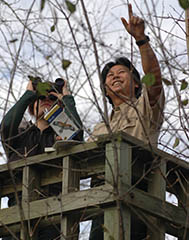 Pictured left: Bird watching at Fort Snelling Park
Pictured left: Bird watching at Fort Snelling Park
By Deborah Locke
DNR Information Officer
When Alex Watson walks through a state park, he can tell what’s going on over the next hill because of audio cues he hears from birds.
“The calls are packed with meaning,” he said. The identification from bird calls and songs came with practice and time starting in 2001. Back then Watson noticed the birds at his family’s bird feeder and then picked up his dad’s bird watching guide.
The moment arrived. Watson, a DNR regional naturalist out of New Ulm, said that the book and bird feeding activity sparked an awareness that our planet is shared with a huge population of diverse creatures. In that moment, a lifelong interest took root.
Hundreds of bird species nest in or pass through Minnesota state parks. Free “Birding Kits” can be borrowed at many parks and include a bird guide, checklist and binoculars. Also, many park naturalists conduct bird-related programs like “Birding for Beginners” on May 4 at Fort Snelling State Park, “Spring Bird Migration” on May 4 at Mille Lacs Kathio State Park, or “Kids, Birds and Binoculars” on May 11 at Interstate State Park. Most programs are free but some require advance registration, so check the park website.
Over the years and after becoming familiar with hundreds of birds, Watson said he’s learned about migration, population changes, adaption to environmental changes, and the significance of calls within the same species. All beginners need to start this fascinating pastime is a set of eyes and the desire to learn. Park websites offer a bird check list at many parks, so you have a heads up on which species are common, uncommon, or rarely seen.
At Afton State Park near Hastings, for example, ring-billed gulls, the American kestrels, warbling vireos and northern rough-winged swallows are common.
When you’re new to birding, Watson suggests small goals at first, like learning the sight and sound of five new birds in a summer. Most people already know a robin from a hawk from a crow, but Minnesota is home to 246 nesting bird species. Add the number of birds that simply pass through the state, and the total rises to 317.
Bird guidebooks also serve beginning birders well, and the state park Birding Kits offer a bird guide. Watson recommends the Peterson Field Guide to Birds, but added that the best bird book is the one tailored to your interests. The Peterson guides give detailed accounts of the parts of the bird from crown to tail feathers, wing details, field marks and more.
Another tool? A bird feeder or bird bath. Both will bring birds to your property where you can learn to identify them by sight and sound. You can find a good recording of bird calls on the Audubon Guide to North American Birds website (www.audubon.org/field-guide/bird) Look up “common loon,” for example, for examples of loon flight calls, wails, yodels, hoots and duets. Then find your way to a state park for a look. Birders feel a special satisfaction when they finally locate a target species, Watson said. Sometimes travel is involved after research, then the search for the bird based on a knowledge base, then hearing or seeing the bird.
“The experience brings closure and it is a good feeling,” Watson said. “It’s like winning the lottery. You get a happy feeling of accomplishment, as with any hobby. You see what you’ve never seen.”
Birds still deliver the “wow” factor to Watson, and he need not travel far at all to reach it. In February he heard a pair of gray horned owls outside his bedroom window late at night. They hooted in a courtship exchange on a windless winter night under a full moon.
“I never saw the birds, and knew that somewhere out there was a male calling a female who responded. They were getting ready to build a nest and lay eggs and raise their young. Bird behavior is so varied and often so spectacular that it pulls you away from your usual grind. Birds can fill you with wonder and wow moments on a weekly basis.”
For a list of state parks with bird checklists, go to mndnr.gov/parkfinder. To see which parks have Birding Kits, go to https://www.dnr.state.mn.us/state_parks/loaner.html. See the “Birds of Minnesota” list from the Minnesota DNR at https://www.dnr.state.mn.us/birds/index.html. For a list of bird-related events at Minnesota state parks, go to https://www.dnr.state.mn.us/state_parks/birding.html. Most bird programs are free, but registration may be required. Call the park before you go. A daily vehicle pass to a Minnesota state park is $7, or $35 for an annual pass which gives year-round access to all of Minnesota’s 66 state parks.
 Pictured left: Award-winning director Alfonso Cuarón
Pictured left: Award-winning director Alfonso Cuarón
A Mexican director has won the Oscar for Best Directing five times in the past six year. This year’s Oscar winner for Best Director Alfonso Cuarón for the amazing film Roma. The star of Roma, Yalitza Aparicio became the first indigenous woman to be nominated for an Oscar and the second Mexican woman nominee.
The “three amigos” and Oscar winning-directors Alfonso Cuarón, Guillermo Del Toro, and Alejandro González Iñárritu, are proving Mexico to be where the talent’s at.
• 2013: Alfonso Cuarón - Gravity
• 2014: Alejandro González Iñárritu - Birdman or (The Unexpected Virtue of Ignorance)
• 2015: Alejandro González Iñárritu - The Revenant
• 2016: Damien Chazelle - La La Land
• 2017: Guillermo Del Toro - The Shape of Water
• 2018: Alfonso Cuarón - Roma

Article by The Catholic Spirit
In 2017, Lorena Trejo heard a radio spot pitching Catholic schools on a secular Spanish radio station. It piqued her interest, and she reached to out the source, the Catholic Schools Center of Excellence, which focuses on Catholic elementary school excellence and advancement in the Archdiocese of St. Paul and Minneapolis. Now her two children attend St. John the Baptist Catholic School in Savage.
The Edina-based CSCOE is hoping to reach more families like the Trejos by expanding its outreach to the Latino Catholic community with a new satellite office in a popular Latino shopping center along Lake Street in Minneapolis.
Leading the office is Maricruz Hernandez, CSCOE Latino enrollment coordinator. It was her voice Trejo heard on the air, and she helped Trejo connect with St. John the Baptist and secure tuition assistance.
Hernandez has been on a mission to close the gap between the vast number of young Latino Catholics and the small Latino presence in Catholic schools. After enrolling her children at Community of Saints Regional Catholic School in West St. Paul, Hernandez connected with CSCOE first as a volunteer. Then, in 2017, she took the newly established enrollment coordinator position and helped 54 families enroll nearly 100 students for the 2018-2019 school year -— a 9 percent increase in Latino Catholic student enrollment at the 79 Catholic elementary schools in the archdiocese.
After her successful first year, CSCOE opened a satellite office for Latino enrollment Jan. 4 at Plaza Mexico, 417 E. Lake Street. It received a blessing from Father James Peterson, parochial administrator of Immaculate Conception in Columbia Heights who previously ministered for three years in Venezuela.
CSCOE chose to locate its satellite office in Plaza Mexico on Lake Street to be in the middle of a Latino community. The office is situated overlooking a food court, and a banner promoting Catholic schools hangs over the railing for guests to see.
“It’s almost like Our Lady of Guadalupe: She could have gone and appeared to the rich, but she went where the poor were because she wanted to raise [up] those people,” Hernandez said. “So if you want to reach Latinos, you need to be where Latinos are.”
In order to staff the new office site, Hernandez moved from part-time to full-time hours, and CSCOE added three part-time employees to help. Staff members visit parishes and Latino communities to meet potential Catholic school families. Their work includes going to festivals and street fairs to meet Latino Catholics, Hernandez said. After connecting with families, they help them find the right school and secure financial assistance, which CSCOE leaders say is the largest perceived obstacle for Latino families seeking Catholic education.
“Most of them, at least with anyone who came from another country, have the idea that it’s very, very expensive,” Hernandez said. “It’s only for the rich, and so they won’t even step in one [Catholic] school just because they don’t feel that it’s possible for their family.”
A 2015 Boston College report showed that nationally more than half of Catholics under 18 are Latino but only 17 percent attend a Catholic school.
The Latinos population in Minnesota has increased by nearly 20 percent from 2010 through 2018, according to the U.S. Census Bureau. Seventy-one percent of them are Catholic.
With its expanded efforts, CSCOE’s Latino enrollment office has a goal of 300 new Latino students for the next school year.
 By Marci Malzahn
By Marci Malzahn
Remember when you were seventeen or eighteen years old and the “old people” were asking you the same questions wherever you went? The questions were, “Where are you going to college? What will you major on? Some of you were sure of what to do and had already decided on a major and a college. And some of you had absolutely no idea! Well, guess what? Now you’re the “old people” and you’re doing the same thing to your kids and your kids’ friends. The pressure is on and for some kids these questions can be extremely stressful.
I have mentored several teenagers and young adults and I have found that the ones who have several interests and also have the talent to do many things well, have the hardest time deciding what to major on. I also have encountered other teens who are simply not interested in going to college. And that should be okay too. There is another option that we may be forgetting about—the trade careers.
I had a great conversation with an electrician at a gathering and he shared that they’re desperately looking for younger workers to replace the Baby Boomers who are retiring quickly. Another time I needed to have the repair person come to my home to look at the furnace and I asked the question of succession in his field and he expressed the same concern—there are no young people taking over these types of jobs. So, I did a little research to find out what these jobs are and where kids can obtain an education or certification that doesn’t require a four-year commitment of time and money.
When I was on the board of Big Brothers Big Sisters of the Greater Twin Cities, I had a meeting with the leadership of the Minneapolis Technical College and the same subject came up. They want to train kids but there are not many students in the pipeline. We were there to partner with them and provide an alternative to the “Littles” to gain education and a life skill so they could become self-sustainable individuals even when they don’t attain a four-year degree. The message was, “It is okay. There are other alternatives where you can make an honest and good living without a college degree.” If you have a son or daughter or are mentoring a youth, I encourage you to keep these options in mind if he or she is not interested in attending a formal four-year degree college.
Below are some trade jobs that are great careers and the country needs desperately as the older generation retires:
• Carpenters
• Electricians
• Plumbers
• Computer Hardware Technician
• HVAC Technician
• Sound Technicians
• Low Voltage Technicians
• Construction Managers
• Aircraft mechanic
• Brick Mason
• Industrial Machinery Mechanic
• Automotive Mechanic
• Auto Body Repairer
In addition, there are other trade jobs the younger generation can have that are not physical labor as the ones listed above, such as:
• Dental Hygienist
• Web Developer
• Fashion Designer
• Film or Video Editor
• Engineering Technician
• Diagnostic Medical Sonographer
As I did some research on these jobs, I found this great resource that may help young adults get some guidance regarding these types of careers: https://www.trade-schools.net/articles/trade-school-jobs.asp America needs tradesmen and women to take over the generation leaving these jobs. As you start the New Year, I encourage you to provide these options to the youth you are mentoring or that come in contact with so they get excited about these opportunities. We need these jobs filled!
Happy New Year!
Marci Malzahn is president and founder of Malzahn Strategic (www.malzahnstrategic.com), a community financial institution consultancy focused on strategic planning, enterprise risk management, cash management, and talent management. Marci is also a professional speaker and published author of three books. You can contact Marci for speaking engagements through her website at www.marciamalzahn.com or email her at marcia@marciamalzahn.com. You can purchase Marci’s books at www.Amazon.com.
 By Harland Hiemstra, Minnesota DNR
By Harland Hiemstra, Minnesota DNR
Linda Radimecky holds the key to another world, one that’s accessible only part of the year. Her key has a history that spans thousands of years and two continents. If you’re interested, she’d be happy to share.
“Snowshoes give us a way to explore a whole different world,” she says. “They allow us to reach places we couldn’t get to in non-winter seasons.”
Take a cattail marsh, for instance. In July, it’s wet and boggy and filled with the hungry hum of mosquitoes. But on a crisp day in January when everything’s buried in snow, you can get out into it and look for tracks to see what’s been stirring. There’s a lot more going on than you might think.
“It’s peaceful and silent,” says Radimecky, who works as a naturalist at Afton State Park near Hastings. “I feel like I’m more in tune with nature and the quiet of winter when I get out on snowshoes.”
Historians believe snowshoes were “invented” somewhere between 4,000 and 6,000 years ago, when prehistoric inhabitants of central Asia strapped pieces of wood and leather to their feet to imitate the way some animals could walk on top of deep snow. It’s a function of what physicists call “flotation.” When the weight of an animal (or person) is spread out over a larger footprint, it floats on top of deep snow, rather than sinking in.
The snowshoe concept spread out from Asia along two different tracks. One track travelled west into Scandinavia, with the pieces of wood strapped to feet growing long and skinny, ultimately turning into skis. The other track took an eastward course, crossing the Bering Strait into North America, where the snowshoe as we know it was created.
Different groups of Native Americans developed different types and styles of snowshoes, depending on their needs. But all the designs relied on a frame made of bent wood (usually from an ash tree), with thin strips of animal hide laced together crosswise and diagonally to hold it together and provide the flotation. The snowshoe played a critical role in the lives of many Native Americans. It was to winter what the canoe was to summer: a mode of transportation and an instrument of necessity for survival.
In 1972, two brothers from Washington state came up with a new approach to snowshoe design, using a lightweight aluminum frame and plastic decking to create the “Western” snowshoe that is most common today. A basic pair can be bought for about $70 and up. Traditional wooden snowshoes are still popular with some, but they tend to be more expensive; some people buy kits from which they build their own. Rentals also are available at many Minnesota state parks.
Learning to use modern snowshoes has less of a learning curve than with the longer wooden ones. Some people say it’s not much different from walking – except that you have big pieces of metal and plastic strapped to your feet. Don’t be surprised if you fall a few times on your first snowshoeing foray. Snowshoeing provides a good winter workout, Radimecky says. The extra weight on your feet and the slightly wider stance required for walking on snowshoes may result in a little stiffness the next day, but getting out into the peace and quiet of a winter day makes it all worthwhile.
A Native American quote from the Canadian First Nations, passed down over the generations, noted that some people try to avoid the snow, whereas “the Indian always looked for the best way to walk on it and live in harmony with nature.” It’s an approach that makes perfect sense to Radimecky.
“If we’re going to be in Minnesota in the winter, let’s embrace it,” she says. “Let’s get out into nature and look for animal tracks and see what’s going on. It’s a lot better than being trapped indoors.”
Want to try snowshoeing?
Go to www.mndnr.gov and type “snowshoeing” into the search bar. You’ll be taken to a page that identifies all of the Minnesota State Parks that rent snowshoes to the public for a mere $6 per day. You’ll also see a list of special state park events focused on helping you learn about this increasingly popular winter activity. A few parks offer special classes where you can build your own snowshoes from a kit.
 Above: A bat cluster from the inside of Mystery Cave in far southeastern MN
Above: A bat cluster from the inside of Mystery Cave in far southeastern MN
By Deborah Locke, DNR Information Officer
White nose syndrome (WNS) has already killed thousands of Minnesota bats, a fact lost on most people. Why should they care? After all, folk lore and popular culture suggests that bats are scary.
Minnesota DNR researchers, scientists, naturalists and park managers have a different view on the small creatures. Some staff members really like bats and teach about them; others are doing their best to protect them from the disease. State parks are home to two large bat colonies that hibernate during the winter months at Mystery Cave at Forestville/Mystery Cave State Park, and at the mine at Lake Vermilion-Sudan Underground State Parks. Ninety percent of the bat population at the Sudan mine has died, and 70 percent of the bat population at Mystery Cave has died, said Gerda Nordquist, a DNR specialist whose team monitors the state bat population. Overall, between five and six million bats have died from WNS, she said.
Since 2009, the DNR has worked with University of Minnesota scientists, other state, federal and tribal agencies and local group to fight the disease now reported in 10 Minnesota counties. There are eight bat species in Minnesota, and four of those species are vulnerable to WNS.
The declined population impacts humans in that fewer bats means more flying bugs. Bats prey on flying insects like mosquitoes, moths and biting flies. A pregnant bat will eat enough insects to equal its weight, Nordquist said. More biting insects creates problems for humans as well as for agricultural crops that become susceptible to insect infestations without bats to keep the bugs in line.
Bob Storlie, Mystery Cave manager, has noticed the sharp decline in the winter bat population. “Our bats have no resistance since with a fungus, they can’t develop an immunity, just resistance,” he said. The fungus, which originated in Europe, flourishes in cool environments. The fungus attaches to a bat which awakes from hibernation and becomes active. That activity causes the bat to burn too much fat and they starve. WNS also compromises a bat’s immune system.
Meanwhile, as WNS continues its onslaught on bats, so does popular culture and myth. “Folklore has bats sucking blood,” Storlie said. North American bats don’t suck blood, nor do they fly into people’s hair. Nor are they blind. In fact, bats have a lot going for them.
“How cool is it that they hang upside down, they are the only mammal that flies, and they use echolocation to find food and fly around without hitting obstacles,” said James Pointer, mine interpretive supervisor at Sudan Underground Mine. He teaches “Batty About Bats” programs designed to show the public why bats are important and non-threatening. Movies and stories depict bats as scary. Plus they are active at night, which means people never see them really well.
“When people learn more about bats and see the great impact they have on our environment and well-being, it eases their fears,” he said. During his presentation to mine visitors, Pointer explains that bats have specialized diets depending on their species. Little Brown Bats eat a variety of insects, with mosquitoes making up only 20 percent of their diet, and Big Brown bats focus on beetles. He added that if you buy a bat toy or decoration, they’re usually black. However, most bats are brown in color. When Pointer’s children were young, he read “Stellaluna” to them, a story about a bat and birds and how they are both similar and different.
To ensure that future generations of children have the chance to read and learn about bats, the DNR continues to monitor the health of bats. Winter and summer monitoring takes place, and the DNR continues to assist with research projects designed to track WNS growth as well as find a cure. During one data-collective visit to Mystery Cave, Bob Storlie watched as Gerda Nordquist used a tip to swab a bat. He gets questions from cave visitors about bats, he said, some who are curious and others who show fear.
“Education is the best thing,” he said. “Some may have a fear of bats, but once they understand the value of the creatures, they start thinking more positively.”
The Minnesota DNR needs your help to watch for unusual winter bat behavior. We also want to know about any summer bat colonies. You can send bat information to the Online Bat Observation Report: www.mndnr.gov/reportbats, or contact the MNDNR Minnesota Biological Survey bat specialist:
Gerda Nordquist at 651-259-5124, gerda.nordquist@state.mn.us Left: A fall hike in Father Hennepin State Park
Left: A fall hike in Father Hennepin State Park
To celebrate the season, Explore Minnesota, the state’s tourism promotion office, and Minnesota State Parks and Trails have teamed up to provide a weekly fall color report starting this Thursday, Sept. 13. From scenic drives to hiking, biking, fall festivals and more, Explore Minnesota and Minnesota State Parks and Trails offer trip-planning tips via email, mobile phone and social media to encourage travelers to get out and enjoy the state’s most colorful time of year.
“Scenic road trips, harvest season, festivals and outdoor recreation make fall the second-biggest travel season. Minnesota is a top destination to experience the fall colors at parks and trails across the state,” said Explore Minnesota director John Edman. “With weekly statewide fall color reports, we’re able to help travelers make the most of this special season.”
State park staff throughout Minnesota assess the status of the trees, wildflowers and grasses in their area and update the online Fall Color Finder at mndnr.gov/fallcolor every Wednesday through the end of October. This popular tool (viewed nearly a half million times in 2017) includes a color-coded map showing the approximate percentage of leaves that have changed color as well as a slideshow of recent photos taken by park staff and visitors.
“Don’t waste time indoors,” said Erika Rivers, director of the Parks and Trails Division at the Minnesota DNR. “Grab your camera and get out hiking, biking or paddling before the short but spectacular fall color show is over at Minnesota state parks and trails.”
Minnesota State Parks and communities statewide have planned activities to coincide with peak fall color, such as the Harvest Festival and Lantern-Lit Hike at Itasca State Park (Sept. 22), Leaf Days celebration at Maplewood State Park (Sept. 29-30 and Oct. 6-7), and hundreds of festivals, fairs, food and heritage events all season long. More fall events can be found on the Minnesota State Parks and Trails calendar and at exploreminnesota.com/events.
Photography: Douglas Anderson
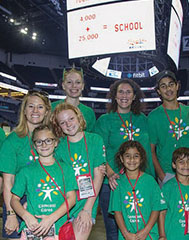 Left: Comcast Team lead by Stacey Nelson-Kumar
Left: Comcast Team lead by Stacey Nelson-Kumar
Greater Twin Cities United Way teams up with Minnesota Timberwolves, Lynx, 4,000 volunteers to pack 25,000 backpacks with school supplies for kids in need
According to the 2016 American Community Survey, each year, more than 100,000 students in our community go back to school without essential supplies they need to learn. As a result, Greater Twin Cities United Way (GTCUW), the Minnesota Timberwolves and Minnesota Lynx hosted Action Day to support kids in need in partnership with the Minnesota Twins, St. Paul Saints, United FC, Vikings and Wild on Aug. 9 at Target Center.
Action Day is an annual volunteer event created by GTCUW that brings the community together to take action in solving a critical need by filling backpacks with supplies to help local kids get ready for a new school year. GTCUW’s goal is to bring together more than 4,000 volunteers to pack 25,000 backpacks for children in need — doubling the effort and impact compared to last year. Backpacks assembled at the event will be distributed to more than 50 metro area nonprofits that will donate them to kids in need.
 By Deborah Locke, MN DNR Information Officer
By Deborah Locke, MN DNR Information Officer
When you look into a clear night sky away from the lights of a city, how much do you recognize? With a flat surface to look from, minimal equipment and a clear night, you can learn the basics of astronomy and eventually may even take pictures of the night sky.
Since the early 1990s, Travis Novitsky, manager of Grand Portage State Park in the northeastern corner of Minnesota, has captured the night sky through the lens of his camera. On a 2018 spring night when the Milky Way was at its most brilliant, he stood on a dock at a public boat access in the Grand Portage State Forest. A bull moose came to the edge of the water, 20 feet away.
“It made my heart race,” he said. “But the moose never sensed enough of me to get spooked.” Another memorable moment, this in 2014: Novitsky was at what’s now Lake Vermilion-Soudan Underground Mine State Park in search of the northern lights which “danced” across the sky. From several points on the lake, he heard loons calling back and forth over the remarkably still water. The impact of the sound and light was “ethereal,” he said.
The newly opened park on Lake Vermilion is ideal for northern light gazing from the fishing pier on Armstrong Bay, Travis said. A flat location in clear weather at the right time of the year offers spectacular night sky images, and you don’t need a degree in astronomy to appreciate them.What you do need is to get away from urban lighting. Novitsky works at Grand Portage State Park which is a stone’s throw from Canada. You, however, only need to travel as far north as Hinckley to see the night sky at its finest. He knows of northern light seekers who drive from Iowa and Illinois to Duluth to see what Lake Superior skies have to offer.
For the best time to go, know what you want to see, Novitsky said. The Milky Way is especially clear from March through September or October. Any meadow or farm field that offers flat, open space works; looking over a lake can be ideal. For the Milky Way, you’d look south to see its core, with the northern lights you’d look, well, north. There’s a misconception that the northern lights can only be seen in the winter months, but that is not true, Novitsky said.“You can see them any time of the year,” he said, especially near the winter and summer solstice. What you see depends on the presence of solar flares, a phenomenon that ebbs and flows. The solar cycle fluctuates every eight to 10 years, with periods of maximum and minimum viewing. Northern lights were at their peak in about 2012-15, he said. For a heads up on space conditions, he goes to the spaceweather.com website which can predict weather in space two or three days ahead.
Novitsky started sky watching at about age 10. He liked being outside at night, noting the constellations and lightning from thunderstorms. In 2004 he started taking photos of the night sky and worked up to a Nikon D750 camera and Nikon 14-24 mm f/2.8 lens which are ideal for night photography.
Know this, however. The tools used to know the night sky better are as simple as your own eyes, or binoculars or a telescope. “Learn Astronomy in 10 Easy Lessons,” the online Sky At Night magazine states that eyes and binoculars could keep you busy for a lifetime of star gazing. Eyes detect meteors and meteor showers, the northern lights, comets, entire constellations and the Milky Way.
Binoculars bring much more into focus: moon craters, double and multiple stars, globular star clusters, nebulae and galaxies. The writer instructs the novice on how to locate the Plough constellation in the north that is visible year-round, and how Plough is a start point to other areas of interest. You should go to the darkest place you can find without artificial light, dress for the night weather, and bring a chair and binoculars.
Another good source: Sky At Night’s “Star-Hopping Guide: Find Your Way Around the Skies.” The article shows how to find Plough and then Polaris and also recommends bringing a chair along, as well as a flask of tea and biscuits (it is the BBC, after all). The writer promises that the night sky viewer will find “an amazing mixture of space, time, history, science and world cultures. It leads you off on all sorts of paths and you’ll learn things that will amaze others. Not to mention the basic reason – you’ll know what you’re looking at.”
If you eventually advance to photography, Novitsky recommends Lake Superior as a first destination. Also, use a head lamp rather than fumble with a hand held flashlight. Invest in a quality tripod. He often gets great shots in the early evening but the best ones are taken between midnight and 2 a.m. In addition, he always tells a family member where he is shooting at night, as a safety precaution. For more remote locations, someone accompanies him.
With time, you’ll learn your way around the night sky from any point in the world.
You can see night sky photography by Travis Novitsky at travisnovitsky.com.
 By Harland Hiemstra, Department of Natural Resource Information Officer
By Harland Hiemstra, Department of Natural Resource Information Officer
It’s the dreaded mid-summer whine no parent wants to hear, a cross between the sound of a pesky mosquito and a whimpering puppy: “Mom, Dad—I’m bored! What’s there to do?”
Lacking the structure of the school day and tired of playing the same old video games over and over, many a boy and girl begins to feel a bit of the summertime “blahs” by the time July rolls around.
Fortunately, there’s an easy and inexpensive antidote available, and it’s as close as your nearest state park, which for most Minnesotans is no more than a half-hour away. If you’re willing to drive a little farther—say an hour or two—there are even more opportunities. And in addition to having fun, the kids might even get a few lessons about Minnesota’s rich natural history without even realizing it. How’s that for sneaking one over on them?
When the weather turns hot, it’s always nice to be in, on or near the water. Some state parks, like Afton State Park, on the St. Croix River just east of St. Paul, and Fort Snelling State Park near the Twin Cities international airport, provide clean, familyfriendly beaches. Many—including Fort Snelling, Interstate, William O’Brien, Wild River, and Sibley state parks—also offer canoe or kayak rentals,. Or you can check out basic fishing equipment and see what’s biting; you don’t even need a fishing license if the lake or river you’re fishing is completely within the state park.
Numerous I Can Fish! programs for beginners will be offered at state parks in July and August, including three taught in Spanish:
• Sat., July 14, 10 a.m.-noon, Fort Snelling State Park.
• Sat., July 28, 1-3 p.m., William O’Brien State Park.
• Sat., Aug. 25, 1-3 p.m., Fort Snelling State Park.
See the complete I Can Fish! schedule and find registration information at www.mndnr.gov/ican.
Youngsters with a penchant for exploration might like to go on a high-tech treasure hunt, also known as geocaching. Geocaching involves using a handheld GPS device to find hidden containers, in which the Minnesota Department of Natural Resources has stashed collectible cards. In keeping with the theme of this year’s geocaching adventure, the Aquatic Quest, the cards feature 82 different plants and animals that can be found in the state’s lakes, rivers and ponds. GPS units can be borrowed from most state parks, and special Geocaching 101 programs are scheduled throughout the summer to teach people how to use them, including one on July 22 at William O’Brien State Park. Pre-registration may be required for some of the programs, so call ahead.
Young fans of Robin Hood or the Hunger Games books and movies might enjoy the opportunity to learn how to shoot a bow and arrow. DNR’s Archery in the Parks program provides equipment and hands-on instruction for beginners. Programs are scheduled in July at Afton, William O’Brien, Wild River and Whitewater state parks, among others. Participants must be at least 8 years old in order to be able to safely handle a bow.
Kids whose taste in movies turn more towards science fiction such as the latest in the Jurassic Park series might find it interesting to get up close and personal with a few of Minnesota’s real-life creatures. You can meet some of Jurassic Park’s distant relatives such as turtles and snakes during a number of special programs scheduled throughout July at William O’Brien, Sibley and Whitewater state parks. You can learn about bats, another fascinating – and to some people scary—animal at special programs at Whitewater State Park. Other animals specially featured at Whitewater State Park include beavers, owls, and peregrine falcons, which are the world’s fastest birds, capable of traveling at speeds in excess of 200 mph.
And that’s just a sampling. You and your kids can learn about the geologic forces such as volcanic flows and huge glaciers that long ago shaped the state’s landscape, find fossils, look at the planets through a telescope, visit a ghost-town, chase butterflies and even catch some live music this summer at Minnesota state parks. All that for only $35 for a year’s worth of fun and adventure. If you’re not quite sure about it and want to “try before you buy,” you can purchase a $7 day pass. Then, before you leave, turn it in and get the $7 taken off the price of the annual permit. More information on all the opportunities at Minnesota state parks can be found online at www.mndnr.gov/stateparks.
 By Harland Hiemstra, Minnesota DNR
By Harland Hiemstra, Minnesota DNR
With its long, whisker-like barbels and flattened face, the catfish might not be the prettiest fish swimming in Minnesota’s waters. But more and more anglers around the state are finding it an attractive species, both for sport and for the frying pan. “Catfish are hard fighters, and they’re widely considered fine table fare,” says Mario Travaline a fisheries biologist with the Minnesota Department of Natural Resources’ Fishing in the Neighborhood (FiN) program. “Usually, if you can find one, you’ll find several. And they can be fished with simple tackle and a variety of baits.”
Channel catfish weighing 20 pounds or more are not uncommon in some of Minnesota’s large rivers. And 30- to 40-pound flatheads – the other species of catfish in the state -- are well within reasonable expectation on the Minnesota River and elsewhere. The state record for a flathead catfish, caught on the St. Croix River in Washington County, is 70 pounds – about the size of an average 10-year-old child!
While rivers are the best place to fish for big catfish, the DNR also stocks channel catfish in about two dozen lakes around the metro region to provide close-to-home angling opportunities. Just go to mndnr.gov and do a search for “catfish lakes” to pull up an interactive map.
Channel catfish will eat almost anything. Nightcrawlers are commonly used for bait, or you can cut some cheap hot dogs in half, put them in a zip-lock bag along with garlic powder and a package of red or purple gelatin mix, and let it sit overnight. Slip the hot dog on a hook with a weight above, and put it in the water. Channel cats can’t resist.
Flathead catfish are predators and respond best to live bait – a bullhead, white sucker or creek chub works well. Look for areas where faster currents are broken by fallen trees, logs, rocks. May to early June offers some of the best catfish action, and flatheads tend to be more active at night. The season for flatheads runs from April 1 through Nov. 30; channel cats can be caught year-round. You can have a total of five catfish in possession, but only two can be flatheads, with only one bigger than 24 inches.
The 240 miles of the Minnesota River from Granite Falls to Fort Snelling is the best place in the state to catch flatheads, and it’s an excellent choice for channel cats as well. And with four state parks and numerous other public lands along its course, finding a place to launch a boat or fish from shore is easy. Be forewarned, though: once you hook into a big cat, you may be hooked on a new flavor of fun!
 By Deborah Locke, DNR Information Officer
By Deborah Locke, DNR Information Officer
When you sit down to your next meal, notice the fruits and vegetables on the table and think of Minnesota’s many bee species. Yes, bees!
Without them and their ability to pollinate, more than a third of the world’s crops would not grow and 90 percent of flowering plant species would not grow.
Right now honey bees are stressed because of pesticide overuse, diseases and parasites. Fewer bees means less honey which explains the jump in honey prices at the supermarket.
You can make a difference, by growing nectar-abundant plants from April through September at home (tomatoes, clovers) and provide nesting habitats to help bees recover and thrive. See the University of Minnesota “Bee Lab” website (www.beelab.umn.edu) or see “Minnesota’s Pollinators” on the Department of Natural Resources website: mndnr.gov/pollinators.
Most bees build nests on the ground, said Linda Radimecky, an interpretive naturalist at Afton State Park near Hastings. The park, perhaps best known for its proximity to the St. Croix River, also features abundant prairie land. Radimecky has seen bees burrow into their ground nests at the park. Prairie land provides a great food source to bees because various plants bloom in tandem during the growing season. Cone flowers, grasses and other plants cover the fields whereas a corn field or sunflower field produces only one plant and grows once and is harvested.
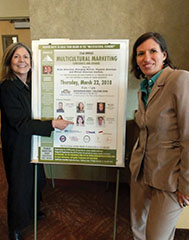 L to R: Pat Arndt and Verónica Jaralambides, Minnesota State Parks and Trails at the Multicultural Marketing Conference
L to R: Pat Arndt and Verónica Jaralambides, Minnesota State Parks and Trails at the Multicultural Marketing Conference
“When you’re out walking and see bees, observe them,” Radimecky said. “There’s a lot we could learn from them and about them.” For example, which bee species—Minnesota has more than 400 bee species—prefer certain flowers and which are generalists? Also, do bees collect nectar randomly throughout daytime hours or in shifts?
A walk through any state park this summer might satisfy your curiosity about bee behavior, or you could create bee-friendly flower beds or gardens at home. A “Parks for Monarchs” program is restoring 520 acres of habitat for monarch butterflies, bees and other native pollinators at seven state parks. Late in 2019, these designated bee and butterfly areas will be on display, as well as exhibits showing the importance of pollinators and how to help support them.
The habitats with interpretive exhibits will be located at Afton, Buffalo River, Fort Snelling, Flandrau, Lake Carlos, Minneopa, Myre-Big Island, Whitewater, Wild River and William O’Brien state parks.
 State parks provide great place to see national bird in the wild
State parks provide great place to see national bird in the wild
By Harland Hiemstra, MN-DNR
It’s a cross between reality TV and something you might see on Animal Planet, a live, as-it-happens close-up on one of America’s most beloved species. And you don’t even have to pay for cable to watch it. Just direct your computer or smartphone to www.mndnr.gov/eaglecam to tune in to what’s become one of Minnesota’s favorite shows.
Since its launch in January 2013, the Minnesota Department of Natural Resources’ EagleCam has provided a live video stream from an active bald eagle nest in St. Paul. Over the past five years, close to a million people from all 50 states and more than 150 countries around the world have watched spellbound as a pair of adult eagles annually nest, lay eggs, hatch them and raise the chicks. In all, 10 young eagles have fledged and flown the nest, all caught on camera.
Part of the bald eagle’s majestic appeal stems from its size and flying talents. An adult female bald eagle can weigh 10 to 15 pounds, with a head-to-tail length of about three feet, and a wingspan stretching six to seven feet or more. Males are about ¾ the size of a female. The birds are powerful flyers, riding thermal updrafts to heights of 10,000 feet and soaring for hours. They can fly at 30 to 40 miles per hour, reaching speeds up to 100 when diving, and sometimes engage in aerobatic stunts, tumbling and twirling through the air as part of courtship rituals.
Bald eagles usually mate for life, using the same nest for many years. Watchers know for sure that the female appearing on the DNR EagleCam has starred in her leading role for the past six seasons, because she has a leg band that identifies her. But this year there’s a new male, leading many watchers to wonder what happened to her partner of years past. Eagles can live 20-25 years in the wild, although 70-80 percent of them don’t make it to the age of five, when they are considered adults and are able to reproduce. Common causes of death include being struck by vehicles, disease, electrocution and lead poisoning.
Bald eagles build bigger nests than any other birds, averaging about 4 or 5 feet in diameter. One bald eagle nest in Florida was measured at nearly 10 feet across, with an estimated weight of more than two tons. The female eagle lays two or three eggs and both parents share incubation duties. The eggs hatch after about 35 days. This year, the first egg in the EagleCam nest was laid on Feb. 19, Presidents’ Day—a fitting birthday for America’s national bird.
Both parents take turns bringing food into the nest, tearing pieces off and feeding them to the hungry eaglets. Common food items seen on the EagleCam include fish from a nearby spring-fed pond and small rodents, such as squirrels and rabbits. An eagle can carry prey weighing up to about one-third of its own body weight, meaning stories about them soaring off with cats and dogs in their talons are unlikely (unless it’s a very small dog or cat). After about 10 to 14 weeks in the nest, the young eagles “fledge,” meaning they’ve grown the feathers they need to fly.
You can watch the egg-laying, the incubation, the hatching and feeding and fledging all for yourself at www.mndnr.gov/eaglecam. The EagleCam and associated technology are paid for and maintained by the DNR’s Nongame Wildlife Program, which is largely supported by voluntary contributions people make at tax time. Line 21 of Minnesota’s income tax form gives people an opportunity to donate to the program, which works to help thousands of species of Minnesota wildlife thrive through habitat restorations, surveys and monitoring, technical guidance, and outreach and education – critters such as bees, butterflies, songbirds, loons, frogs, turtles and bats, as well as eagles. Donations to the Nongame Wildlife program are tax-deductible.
With more bald eagles than any state except Alaska, Minnesota is also a great place to get outdoors and see the magnificent raptors in the wild. Minnesota state parks along major rivers are a great place to look for them. State parks in the Twin Cities area where you have a good chance of seeing eagles include Afton and Fort Snelling. South of St. Paul about an hour, Frontenac State Park near Red Wing offers excellent eagle watching opportunities from bluffs overlooking the Mississippi River. And north of the Cities, Wild River State Park includes an active eagles’ nest near a trail, with likely sightings along the St. Croix River as well.
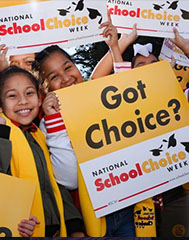 North Star State Parents Encouraged to Look Into Education Options for Children During National School Choice Week
North Star State Parents Encouraged to Look Into Education Options for Children During National School Choice Week
By Claud Santiago
School Choice Week in Minnesota and across America with the goal of raising awareness about the options that parents have for their children’s education.
The Week will feature 452 events and activities across the North Star State, including open house events at schools, school fairs, homeschool information sessions, and other celebrations. In addition, a school fair is planned on Saturday, January 27 at the Lightbox Studio in Minneapolis.
Nationwide, 32,240 events and activities are being organized to raise awareness during National School Choice Week (Jan. 21-27, 2018), and nearly 7 million Americans are expected to participate. It will be the largest series of education-related events and activities in U.S. history.
The Week brings attention to the different education environments that are available for Minnesota’s 1.2 million children. For example, families in Minnesota can choose from traditional public schools, public charter schools, public magnet schools, private schools, online academies, and homeschooling. The state’s public school open enrollment policy is one of the nation’s broadest and most accommodating. The state also offers tuition-free, public online schooling.
The county of Wilkin and the cities of Babbitt, Bird Island, Brooklyn Center, Centerville, Crosslake, Ely, Foley, New Ulm, Northfield, Wadena, St. Paul Park, Linwood, Waterville, New London, Rochester, Thief River Falls, and Woodbury have issued proclamations recognizing School Choice Week in their community.
“National School Choice Week shines a positive spotlight on effective education options for every child. The goal is to raise awareness of all types of education for children. Being a private, non-profit school, we know that many of our parents make a large sacrifice to send their child or children to Academy of Whole Learning. We participate to celebrate that we are an excellent choice in education for students with autism spectrum disorder or related learning differences,” said Paul Gloudemans, admissions at Academy of Whole Learning, a private school serving 58 students in grades K to 12 in Minnetonka, Minnesota.
Celebrated since 2011, National School Choice Week is an independent public awareness effort. The Week is nonpartisan and nonpolitical, and it is not related to any legislative advocacy campaign.
“Minnesota is a national pioneer when it comes to providing educational opportunities for children,” said Andrew Campanella, president of National School Choice Week. “National School Choice Week is a time to celebrate the fact that Minnesota has set a positive national example for school choice, while also letting more parents know about the options they have for their children’s education.”

By Claud Santiago
After another year of bad tests results, community, business and educational leaders should agree that Minnesota schools have grown more segregated and the state’s nation-leading achievement gap has not budged in the past 15 years. In 2002 the federal No Child Left Behind Act led the national campaign for school equity . Since then the number of schools in Minnesota where students of color make up 90 percent or more of enrollment stands at 200, double of what is was in 2002.
Minnesota students saw little progress in test scores this year, according to data released Thursday by the state Department of Education. The state’s wide academic achievement gaps between white students and students of color also remain virtually unchanged, according to the scores.
They come from the Minnesota Comprehensive Assessments, tests in reading, math and science that most students take every year. The percent of students considered proficient in reading statewide ticked up one point to 60 percent, and the math proficiency rate for third- to eighth-graders dropped one point to 61 percent.
Nearly 70 percent of white students passed the tests in both subjects. Black students saw proficiency rates around one-third. Similar gaps exist for American Indian and Hispanic students. Those disparities remained virtually unchanged from last year.
“The progress isn’t fast enough,” said state Education Commissioner Brenda Cassellius. Cassellius said the stagnant scores have convinced her that schools can’t close achievement gaps on their own. She said factors like poverty, homelessness and hunger stall progress.
“Unless we also deal with the great urgency around all these other outside school factors, we won’t be able to move the achievement disparities as quickly as we’d like to,” Cassellius said.
She said schools also need more support services like social workers to connect students to resources outside of school. Minnesota spends less of its education money on student support than any other state.
Test scores in the state’s two largest urban districts mirrored the statewide trend. St. Paul saw small progress in reading and science scores, with flat results in math. Achievement gaps between white students and students of color widened slightly in reading and remained nearly unchanged in math.
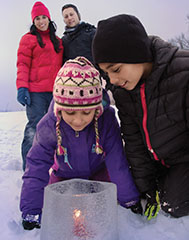 By Deborah Locke, DNR Information Officer
By Deborah Locke, DNR Information Officer
We all know the way candlelight softens an indoor winter evening with a soft glow that warms and illuminates. That indoor glow moves outside in the winter months during candlelight walks held at state parks throughout Minnesota. Hundreds of luminaries will line miles of trail edges, casting a beautiful light while bringing a little mystery and intrigue to your walk.
Let the winter of 2017-18 be the first winter of your new candlelight walk tradition: bundle up the family members (including the dog) and drive to the park at sundown. In the metro area, you may wish to take part in the New Year’s Eve candlelight walk at Fort Snelling State Park from 4 to 8 p.m. on Dec. 31. The trails will be lit, and warming stations along the trail will include a bonfire as well as a chance to toast a marshmallow, your first toasting to a new year.
If you like the idea of luminaries enough to create your own, the “Ice Luminaries 101” demonstration will be held from 10 a.m. to 11 a.m. on Dec. 23, 2017 at Fort Snelling State Park. No registration is needed. If you are attending the park for the first time, know that the Visitor Center is about two miles from the park entrance on Highway 5. Plan for an addition 10 minute drive along the river and through the park. For more information, call the Visitor Center at 612-725-2724.
Or maybe you’ve always wanted to try snowshoeing by the light of the moon. Join others from 6:30 to 8 p.m. on Jan. 1, 2018 at Afton State Park near Hastings for the annual First Night Hike. You can borrow snowshoes from the park office; they are available for both children and adults. Program space is limited, though, so call ahead to register at 651-231-6989. If you would prefer an afternoon to learn how to use snowshoes, check out the “Let’s Snowshoe” event from 10 a.m. to 3 p.m. on Jan. 20, 2018 at William O’Brien State Park. You can borrow or rent the equipment from the park’s Visitor Center and receive instruction on the basic fundamentals of snowshoeing. You can use the park’s older wooden snowshoes for free or rent newer ones for $6. Keep in mind that a base of six inches of snow is needed to snowshoe; if enough snow is not on the ground then, the program will be cancelled. For more information, call 651-433-0500.
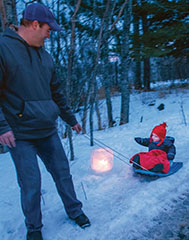 If snowshoeing turns out to be a hit with your family, there are lots of other Minnesota state parks you can explore, many of which rent snowshoes. Some of the parks have groomed snowshoe trails--Flandreau, Fort Snelling, Glendalough, Grand Portage, Itasca, Maplewood, Sibley and Wild River—but you don’t have to stay on the trails. You can snowshoe anywhere in the parks except on trails groomed for skiing or snowmobiling.
If snowshoeing turns out to be a hit with your family, there are lots of other Minnesota state parks you can explore, many of which rent snowshoes. Some of the parks have groomed snowshoe trails--Flandreau, Fort Snelling, Glendalough, Grand Portage, Itasca, Maplewood, Sibley and Wild River—but you don’t have to stay on the trails. You can snowshoe anywhere in the parks except on trails groomed for skiing or snowmobiling.
Want to go faster? Bring your snowmobile for a brisk run down a Minnesota state trail. Minnesota’s trail network includes more than 22,000 miles of groomed snowmobile trails, with more than 21,000 miles maintained by local snowmobile club volunteers. For maps and more information, go to mndnr.gov/snowmobiling.
Maybe sightseeing or photography are hobbies. Parks offer an abundance of photo opportunities, be it lacy tree branches against a bright blue sky or an owl perched on a branch overhead or a frozen waterfall.
Winter offers new ways to play outside. Maybe you’ve never ice fished, or maybe you have always wanted to try cross-country skiing. . Learn more about these and other activities at Winter Trails Day from 11 a.m. to 4 p.m. on Jan 20, 2018 at Fort Snelling State Park. Hosts including the National Park Service, REI, the DNR and the U.S. Forest Service will be on hand to teach and demonstrate winter recreational and sport activities.
For a list of all winter events, go to mndnr.gov/ptcalendar A winter programs and events brochure is available to you from the DNR Information Center. To get a copy, call 651-296-6157 or send an email to info.dnr@state.mn.us. The Info Center is open from 8 a.m. to 4:30 p.m. Monday through Friday.
Keep in mind that weather changes quickly in Minnesota: check the weather forecast and always dress appropriately. A vehicle permit is required to enter Minnesota state parks and recreation areas. The fee is $7 for a one-day permit or $35 for a year-round permit that provides unlimited visits.
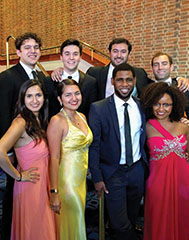 Top Row. L to R: Latino members of Sphinx Virtuosi with Rick Aguilar—Gabriel Cabezas (cello), Robert Switala (viola),
Benjamin Harris (double bass), Thomas Mesa (cello), Marza Wilks (cello), Sheena Gutierrez (violin), Rainel Joubert (violin), and Particia Weitzel (double bass).
Top Row. L to R: Latino members of Sphinx Virtuosi with Rick Aguilar—Gabriel Cabezas (cello), Robert Switala (viola),
Benjamin Harris (double bass), Thomas Mesa (cello), Marza Wilks (cello), Sheena Gutierrez (violin), Rainel Joubert (violin), and Particia Weitzel (double bass).
By Claud Santiago
The Sphinx Virtuosi, one of the nation’s most dynamic professional chamber orchestras, performed at the Ordway Concert Hall in October. Composed of 18 of the nation’s top Black and Latino classical soloists, these alumni of the internationally renowned Sphinx Competition come together each fall as cultural ambassadors to reach new audiences. At once a bridge between minority communities and the classical music establishment, the Sphinx Virtuosi continue to garner critical acclaim during their annual national tours to many of the leading venues around the country.
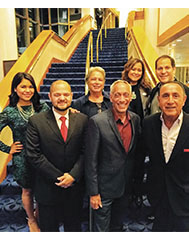
Top row. L to R: Daysi Martinez, Carmen Robles, Yolandita and Herman Colon, Victor Martinez, Tony Jilek-Guidry, and Rick Aguilar
Inspired by Sphinx’s overarching mission, the Sphinx Virtuosi works to advance diversity in classical music while engaging young and new audiences through performances of varied repertoire. Also in October the Ordway Music Theater presented Diavolo / Architecture in Motion. Featuring diverse team of dancers, designers, choreographers, and engineers to create visceral and awe-inspiring works that reveal how we are affected emotionally, physically, and socially by the spaces we inhabit.
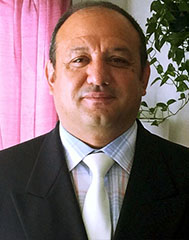 Por Saúl H. Carranza
Por Saúl H. Carranza
Hace poco escuché a un congresista testificar que él fue el primer hijo de Inmigrantes indocumentados en llegar al congreso de los Estados Unidos. Él dijo: “cuando yo era joven no se hablaba de dreamers” pero yo fui un dreamer.” Poder soñar y anticipar el futuro, aunque a veces parezca irrealizable, es una característica distintiva del ser humano. Tres frases famosas del creador de las películas animadas, Walt Disney ilustran esta realidad. El Señor Disney dijo: “Todos tus sueños se pueden hacer realidad, si tienes el valor para perseguirlos. La manera de comenzar es dejar de hablar y comenzar a actuar y si lo puedes soñar lo puedes lograr”.
Muchos jóvenes inmigrantes han contribuido significativamente para engrandecer el país que los ha recibido, su segundo hogar. Al estudiar la historia de la nación encontramos bravos guerreros, ilustres científicos, destacados deportistas, profesionales de éxito y muchísimos hombres y mujeres que han dado lo mejor de sí para que sus destrezas cualidades y educación contribuyan a hacer un mundo mejor para ellos y para todos. La mayoría de migrantes van buscando un mejor futuro para ellos y su familia. Los padres que hemos traido a nuestros hijos a este país lo hemos hecho con la esperanza de darles mejores oportunidades de estudiar y trabajar. Pero cada uno tiene que hacer su mejor esfuerzo.
Un mejor futuro, en la mayoría de las ocasiones, está ligado a esfuerzo y educación. La persona que quiere destacar en un oficio o profesión tiene que pagar el precio de la disciplina y la constancia. Educación es el medio de adquirir conocimientos, es lo que te permite aprender cómo ser útil a los demás, es el conocimiento que te acerca a tu vocación y la profesión que ejerce esa vocación y te abre la puerta a salarios competitivos en ese campo de acción. A través de la educación se obtienen mejores salarios y reconocimiento profesional.
Una de las más tristes realidades contemporánea de muchos jóvenes hispanos es que abandonan la escuela secundaria para unirse a la fuerza laboral o dedicarse a la vagancia. Algunos porque se ilusionan con ganar su primer salario pues deben contribuir a la economía familiar, otros son obligados por embarazos no esperados y otros porque no tienen la disciplina o el apoyo para continuar estudiando. Si estos jóvenes pudieran ver el futuro promisorio que una buena educación les ofrece seguramente lo pensarían más detenidamente antes de dejar la escuela. La falta de educación y de un título les cierra muchas puertas y los confina a bajos salarios o trabajos con mucho esfuerzo físico.
En la Biblia encontramos el ejemplo de jóvenes inmigrantes que en condiciones totalmente adversas pudieron cambiar su futuro y el de la nación en la que vivieron. Jóvenes como José príncipe de Egipto, Moisés el líder, Josué el guerrero, Daniel el gobernador y muchos más que son ejemplo de como un joven puede triunfar y destacar para lograr un futuro mejor. Aprendemos de ellos que tuvieron que educarse, aprender la lengua y costumbres de los países a los que llegaron y que, a la manera del congresista antes mencionado, llegaron a ser gente influyente e inclusive gobernantes del país en el que vivieron.
Salomón fue probablemente el joven más rico y exitoso de su tiempo. Y él, en el libro de proverbios, dio este consejo a los jóvenes. “ Lo que realmente importa es que cada día seas más sabio y que aumentes tus conocimientos, aunque tengas que vender todo lo que poseas. Valoriza el conocimiento, y tu vida tendrá más valor; si haces tuyo el conocimiento, todos te tratarán con respeto” También dijo Porque Jehová da la sabiduría, Y de su boca viene el conocimiento y la inteligencia. El provee de sana sabiduría a los rectos; Es escudo a los que caminan rectamente. Prov. 4:7y 2:6 Aún Jesús de Nazaret, en lo poco que la Biblia menciona de su adolescencia y juventud dice: “Y Jesús crecía en estatura, en sabiduría y en gracia para con Dios y con los hombres”. Lucas 2:52. Cuando tenemos que pensar en el futuro, Dios dice: “Esfuérzate, se valiente, no temas, no desmayes. Jehová tu Dios está contigo a dondequiera que vayas y todos los días de tu vida”.
Una buena educación no es barata, hay que invertir mucho esfuerzo y recursos, pero sus frutos se continúan cosechando toda la vida.
Rev. Saul H Carranza es Pastor de la Iglesia Cristo para todas las Naciones en Crystal MN. Es originario de Guatemala y su misión es servir a la comunidad hispana de Minnesota. Tel. 763 245 2378 pastorcarranza@gmail.com
 By Claud Santiago
By Claud Santiago
Panelists and Attendees discuss the Achievement Gap!
Over 75 attendees participated in the 4th annual Latino Education Achievement Gap Summit presented by Latino American Today. Attendees included Latino youth leaders, educators from private, public and charter schools and political leaders from both the Republican and Democrat parties. Several panels presented data, demographics, case studies and insights about the achievement gap that is one of the worst in the country.
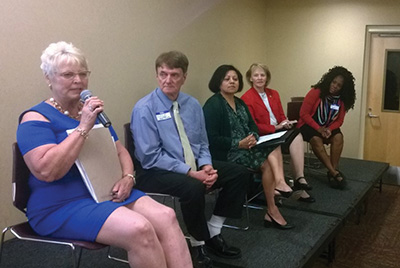 Panel from L to R: Rep. Sondra Erickson, Sen. Chuck Wiger, Elia Bruggeman, Sen. Mary Kiffmeyer and Zuki Ellis
Panel from L to R: Rep. Sondra Erickson, Sen. Chuck Wiger, Elia Bruggeman, Sen. Mary Kiffmeyer and Zuki Ellis
Consenus of the attendees was that all options should be on the table in order to make changes and gains in the Latino high school graduation rates.
 By Aaron Rodriguez
By Aaron Rodriguez
When state legislators say they oppose expanding the school choice program, they’re sending a message to Hispanic parents that they’re not smart enough to decide which schools are best for their children. Allow me to explain.
Numerous surveys published recently have indicated an overwhelming support for the school choice program among Hispanic voters. According to a 2012 report published by the American Federation for Children—a pro-school choice advocacy group—91% of Hispanics in Florida, Arizona, New Mexico, New Jersey and Nevada support school voucher and scholarship programs. In Texas, a survey published earlier this year by Braun Research showed that 80% of registered Hispanic voters support school choice.
If you’re not a fan of surveys, let’s try some different numbers.
St. Anthony School in Milwaukee is now the largest private school to participate in a school choice program across the country. It wasn’t always this way. From 2002 to 2011, the school’s annual student enrollment ballooned from 400 to 1,700 students. The rate of growth is impressive; but underscoring that growth is the statistic that 99% of St. Anthony’s student body is Latino. St. Anthony’s expansion and demographics corroborate what surveys have been telling us: There is a strong demand for school choice among Hispanics.
The state Legislature should keep two things in mind when considering the expansion of school choice. First, the Hispanic community is the fastest-growing ethnic group in the country, quickly becoming an important voting bloc in American elections. Second, many of the areas targeted this year in Wisconsin for expanding school choice have growing Hispanic communities. Let’s briefly look at three of the nine areas in Wisconsin targeted for school choice expansion: Green Bay, Kenosha and Beloit.
Green Bay’s Hispanic population density is twice the state average. Hispanic population growth there has doubled the past 10 years and quadrupled in the past 15 years. Kenosha’s Hispanic population is now approaching three times the state average and has grown 79% in the past 10 years. Beloit’s Hispanic population is almost three times the state average and has grown 94% the past 10 years. Opposing the expansion of the school choice program in cities where Hispanics are quickly growing is playing political chicken with an increasingly important voting bloc.
A recent op-end submitted by a group of public school teachers argued that voucher schools are not accountable to taxpayers and have not increased student achievement beyond public schools. I won’t get into the weeds on some of the particulars, but I will point out something that seems to be ignored by the anti-school choice crowd. A five-year longitudinal study published by Patrick Wolf of the University of Arkansas showed that students in the Milwaukee Parental Choice Program were 7% more likely to graduate high school and 4% more likely to enroll in college than their Milwaukee Public Schools peers. Nationally, Hispanic students are three times more likely to drop out of high school. Knowing that the choice schools excel precisely in the areas where Hispanics have the greatest academic deficit strengthens the argument to expand school choice into Hispanic communities.
Over the last decade, St. Anthony School in Milwaukee accepted on average more than 100 additional low-income, low-performing Hispanic students a year. For any school to expand that quickly is a risk because first-year, low-performing students will inevitably drop the schools’ average test scores.
St. Anthony accepted the risk and met the community demand. As a result, it is graduating 93% of its first senior class with a 96% college enrollment rate. St. Anthony is a good test case showing that a school consisting of 99% Latino students from low-income homes can buck the national trend, exceed the state’s high school graduation and college enrollment rates and corroborate peer-reviewed studies of the program with real results.
Like public schools, the school choice program is not without its flaws. Just saying that a school participates in the school choice program doesn’t make it a good school. We should advocate closing any school that continues to perform poorly because our kids deserve it; however, we also should balance the interest of accountability with the growing demand for school choice in populations of need.
It’s nearly impossible for good private schools in the voucher program to expand when they continue to receive a fraction of the per-pupil funding as public schools. St. Anthony was able to expand because it scraped together the resources; but not all schools in the program have the resources. Per-pupil funding for the school choice program must increase, especially for schools offering a secondary education.
Legislators should be encouraged by the Hispanic community’s desire for education reform. Hispanics like the school choice program and want it in their community. To deny them a choice among a broader marketplace of schools is no different than telling them they don’t know what’s best for their children.
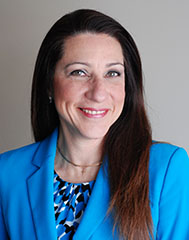 By Marci Malzahn
By Marci Malzahn
As a leader and speaker, I was pondering on what the two things that I am and do have in common. I quickly realized that it is the power of influencing others. Leadership, at the core, is about influencing others. Speaking is also fundamentally about influencing others with our words. Most leaders also have to speak in public. The same way, speakers lead others because people follow their advice, their expertise, and are influenced by their speech. For example, whether a speaker speaks about a business topic where he or she is teaching on that subject to their audience, or the speaker shares their inspirational story, the audience listens—and most of the times, follows.
With the power of influence comes great opportunities and also huge responsibilities. Some of those opportunities that also carry a lot of responsibility are:
Set trends. Leaders and speakers can set a trend. Sometimes those trends can be small things like encouraging people to help their neighbors—whether their neighbor is in the next cubicle or in their neighborhood. Other times trends can be world changing like Steve Jobs when he introduced the new iPhone technology.
Set the example of commitment. Both leaders and speakers have to show up and do their jobs regardless of what’s going on in their personal lives. Speakers make commitments to deliver a keynote or teach a seminar months and sometimes a year in advance. People show up to hear and learn from them. I remember last year I had to teach an all-day seminar on Cash Management and 40 bankers had signed up to spend the day with me to learn. During those days, my father-in-law was not doing well and that very morning at 3 a.m. he passed away in Missouri and I not only couldn’t go and be with my husband but I had to show up and teach the entire day. That was one of my biggest tests as a speaker. I delivered the presentation and no one knew what happened in my private life. I understand that sometimes if it’s your own parent, spouse, sibling, or child, you do need to cancel your commitments. But for the most part, your audience doesn’t care what happened in your personal life and speakers are expected to fulfill their commitments. There was another occasion when one of my co-workers passed away and the president of the bank was out so I, as a member of the executive team, had to announce it to the staff. I was devastated and did cry during the announcement but I got through it. I had to lead in that sad moment.
Be consistent. Leaders as well as speakers need to be consistent on how they deliver their message to their audience—whether the audience is the company’s staff or the attendees at a conference or event. Consistency here means they prepare by doing their research, by practicing, and they show up. They do their part of the job as a team member. Being consistent also means that they behave the same when they are at home as well as on the stage or in the office.
Be authentic and genuine. When leaders and speakers are consistent and behave the same way everywhere, that’s what we call being an authentic and genuine. Each leader must be him or herself in order to be the best and most effective leader he or she can be. The same way, each speaker has a unique message and delivery method that belongs to them. It’s their unique brand.
Bring value. Speakers and leaders who are authentic, genuine, and consistently act the same wherever they go, bring value to their audience. Each speaker and leader has its own value. It’s their unique value proposition. Again, their brand brings value to those who follow them.
Make others feel valued. At the same time that authentic and genuine leaders and speakers bring their own value wherever they go, they make others feel valued. Authentic leaders genuinely care about others so they spend time with people and take time to nurture their relationships. They listen to others and also share their experiences to help people be the best they can be.
If you are a leader, you most likely are already a public speaker even if you’re not a professional speaker, meaning you don’t speak for a career. The same way, if you are a professional speaker, you most likely lead in some way even if you’re not leading a company, because you have followers. So take advantage of the great opportunity to influence others and, at the same time, take the responsibility that comes from influencing others, seriously. In the Latino community we have an even greater opportunity and responsibility to both lead and to speak into people’s lives.
Marci Malzahn is a banking executive and founder of Malzahn Strategic (www.malzahnstrategic.com), a community bank consultancy focused on strategic planning, enterprise risk management and talent management. Marci is also an author and motivational/ inspirational speaker. You can contact Marci for speaking engagements through her website at www.marciamalzahn.com or email her at marcia@marciamalzahn.com. You can purchase Marci’s books at www.Amazon.com.
 Pictured left: Saúl H. Carranza
Pictured left: Saúl H. Carranza
By Saúl H. Carranza
When I arrived in the United States, a friend invited me to the May 5 celebration in Saint Paul, on Cesar Chavez Street. The obligatory question was “What is celebrated on May 5?” My American friend told me, “The Independence of Mexico.” “No,” I said. “Mexico’s independence is on September 16.” Then we both concluded that we did not know what the celebration on May 5 was. My friend told me it is a big party and is a chance to eat good Mexican food. He invited me to a traditional Mexican restaurant in “El Burrito” and we went to find out about the “big party.” The friendly owner of the restaurant explained that this celebration really is bigger here in the United States than in Mexico. She told me the story of the epic battle of Puebla.
As an article on expansion.mx says, this was a historic battle like “David vs. Goliath.” A giant and well-armed French army against a brave but smaller and poorly armed Mexican army commanded by General Ignacio Zaragoza. On May 5, 1862, the Mexican army, supported by peasants armed with machetes and knives, forced the French to flee, causing them many casualties both dead and wounded. Although the French eventually conquered Mexico. This battle is recorded in history as the effort of a handful of brave men who fought against oppression and in favor of a free homeland.
What we see today in Saint Paul and other major cities of the American union, is a celebration of all, with no difference of flags and countries celebrating the Hispanic heritage and the opportunity to live in goodwill and harmony in this country.
This battle presents us with two opportunities. The first is to teach the new generations the richness of a past full of illustrious names that even at the cost of their own lives gave us a heroic heritage that unites us and that enriches our lives through the interaction of peoples and cultures.
The second is that there will always be bad things that attack our lives and families. Situations that frighten us, want to destroy what we are and that seem very powerful to be overcome. Sometimes evils such as poverty, alcoholism, drug addiction, ignorance, violence, and lack of opportunities can affect our lives and the first thought may be “there is nothing to do, it is very powerful, and it cannot be changed.” The Bible says, “For God has not given us a spirit of cowardice, but of power, love, and self-control.” This means that you are not alone. That God has equipped you and your family with a fighting spirit. That you can make him want and trust that with the help of God you will go ahead. Elsewhere the Bible says “just be strong, be brave, do not fear do not be dismayed.”
Surely, there were many moments in which General Zaragoza and his soldiers thought they were going to be defeated, but they went ahead. There will be many difficult times in your life. In them just be strong, have faith and you can change a forecast of defeat into one of victory.
Saul Carranza is originally from Guatemala and pastor of the Church Christ for All Nations in Crystal MN. Tel. 763-245-2378 saulcarranza@yahoo.com
Cinco de mayo, contra todo pronóstico hubo victoria
Por Saúl H. Carranza
Cuando llegué a Estados Unidos un amigo me invitó a la celebración del cinco de mayo en Saint Paul, en la calle Cesar Chávez. La pregunta obligada fue: “¿Qué se celebra el cinco de mayo?” Mi amigo estadounidense me dijo: “La Independencia de México”. No, le dije, “la independencia de México es el 16 de septiembre”. Entonces los dos concluimos que no sabíamos que se celebraba el cinco de mayo. Él me dijo que era una fiesta grande y que era la oportunidad de comer buena comida mexicana. Me invitó a un tradicional restaurante mexicano en “el burrito” y fuimos para averiguar sobre la “fiesta grande”. La amable propietaria del restaurante nos explicó que esta celebración realmente, es más grande aquí en Estados Unidos que en México. Y me contó la historia de la épica batalla de Puebla.
Como dice un artículo de expansión.mx fue una histórica batalla al estilo “David contra Goliat”. Un gigante y bien armado ejército francés contra un valiente, pero más pequeño y mal armado ejército mexicano al mando del General Ignacio Zaragoza. El cinco de mayo de 1862 el ejército mexicano, apoyado por campesinos armados de machetes y cuchillos, obligó a huir a los franceses causándoles muchas bajas entre muertos y heridos. Aunque finalmente los franceses conquistaron México. Esta batalla queda registrada en la historia como el esfuerzo de un puñado de valientes que lucharon contra la opresión y a favor de una patria libre. Lo que vemos hoy en día en Saint Paul y otras grandes ciudades de la unión americana, es una fiesta de todos, sin diferencia de banderas y países celebran la herencia hispana y la oportunidad de vivir en hermandad y armonía en este país.
Recordar esta batalla nos presenta dos oportunidades. La primera es enseñar a las nuevas generaciones la riqueza de un pasado repleto de nombres ilustres que aún a costa de su propia vida nos dieron una herencia heroica que nos une y que enriquece nuestra vida a través de la interacción de los pueblos y las culturas.
La segunda es que siempre habrá cosas malas que atacan nuestra vida y familia. Situaciones que nos atemorizan, quieren destruir lo que somos y que parecen muy poderosas para ser vencidas. A veces males como pobreza, alcoholismo, drogadicción, ignorancia, violencia, falta de oportunidades pueden afectar nuestra vida y el primer pensamiento puede ser “no hay nada que hacer, es muy fuerte, no se puede cambiar”. La Biblia dice: “Porque no nos ha dado Dios espíritu de cobardía, sino de poder, de amor y de dominio propio.” Esto significa que no estás solo. Que tú y tu familia han sido equipados por Dios con un espíritu luchador. Que puedes echarle ganas y confiar que con la ayuda de Dios saldrás adelante. En otra parte la Biblia dice “solo esfuérzate sé muy valiente, no temas no desmayes”.
Seguramente hubo muchos momentos en los que el General Zaragoza y sus soldados pensaron que iban a ser derrotados, pero salieron adelante. Habrá muchos momentos difíciles en tu vida. En ellos solo esfuérzate, ten fe y podrás cambiar un pronóstico de derrota en uno de victoria.
Saúl Carranza es originario de Guatemala y pastor de la Iglesia Cristo Para Todas Las Naciones En Crystal MN. Tel. 763-245-2378 saulcarranza@yahoo.com
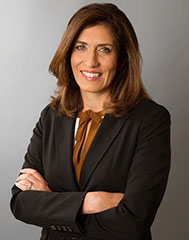 Pictured left: Nina Rees
Pictured left: Nina Rees
By Nina Rees
Today, one in three Hispanics in the United States are of school-going age, and parents are presented with the difficult task of giving their children the best possible education. In the past choices were limited between traditional public schools and private schools; however, as new public charter schools continue to open in neighborhoods with concentrated Hispanic populations, parents are weighing the benefits of this new opportunity. According to the National Alliance For Public Charter Schools, the leading national nonprofit organization committed to advancing the public charter school movement, there are several key factors for parents to consider before they go the traditional routes.
Charter schools are tuition-free, public schools to open to all children. They are unique because they are given greater flexibility in exchange for greater accountability to student outcomes.
“Across the country, charter schools are working with families and communities to help put students on a path to success,” said Nina Rees, president and CEO of the National Alliance for Public Charter Schools. “The charter school movement is made stronger by the diverse backgrounds, talents, and dreams of our students, including the nearly one-third of all charter school students who identify as Hispanic.”
La educación en las escuelas públicas charter comprueba ser una excelente opción para los estudiantes hispanos
Hoy día, uno de cada tres hispanos en los Estados Unidos está en edad escolar y sus padres deben enfrentar la difícil tarea de dar a sus hijos la mejor educación posible. En el pasado las opciones estaban limitadas a las escuelas públicas tradicionales o las escuelas privadas; sin embargo, a medida que nuevas escuelas públicas chárter continúan abriendo sus puertas en comunidades de alta concentración de población hispana, los padres deben sopesar los beneficios de esta nueva oportunidad. Según la Alianza Nacional de Escuelas Públicas Chárter, la organización nacional líder no lucrativa, comprometida con el crecimiento del movimiento de escuelas públicas chárter, hay varios factores claves que los padres deben considerar antes de escoger las opciones tradicionales.
Las escuelas chárter son gratuitas y están abiertas a todos los niños. Son especiales porque tienen mayor flexibilidad, a cambio de una mayor rendición de cuentas por los resultados de los estudiantes.
“A través de todo el país, las escuelas chárter están trabajando con las familias y las comunidades para ayudar a ubicar a los estudiantes en el camino hacia el éxito”, dijo Nina Rees, Presidente y Directora Ejecutiva de la Alianza Nacional de Escuelas Públicas Chárter. “El movimiento de las escuelas chárter se ha hecho más fuerte por los diversos orígenes, talentos y sueños de nuestros estudiantes, incluyendo casi una tercera parte de todos los estudiantes de todas las escuelas chárter que se identifican como hispanos”.
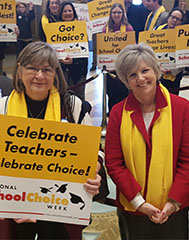 Pictured left: Participants at the OAK rally at the State Capitol Rotunda
Pictured left: Participants at the OAK rally at the State Capitol Rotunda
Bill would provide opportunity for low- and middle-income students to access the best K-12 school for each child
Minnesota legislators have introduced legislation that gives parents the opportunity to access the best educational option for their children.
The bill, H.F. 386 / S.F. 256, known as the Equity and Opportunity Scholarship Act, is being authored by Rep. Ron Kresha (R-Little Falls) in the House and Sen. Roger Chamberlain (R-Lino Lakes) in the Senate. These bipartisan bills have both Republican and DFL co-authors in the House and Senate.
The legislation would authorize creation of “opportunity scholarships” – scholarships provided to low- and middle-income children to attend a school of choice. They are funded through private contributions made to non-profit scholarship granting organizations with 501(c)3 status, and must be approved by the Minnesota Department of Revenue. Similar programs exist in 17 states including Iowa, South Dakota, Arizona and Florida.
“Every child in Minnesota deserves access to a school that best meets their needs,” said Rep. Ron Kresha. “Opportunity scholarships will empower parents and break down the financial barriers that can prevent low- and middle-income families from accessing a good school.”
“Minnesota has a strong history of supporting choice in education,” said Sen. Roger Chamberlain. “Unfortunately we’ve fallen behind in recent decades. This legislation will help our children access the best possible learning environment. We need to give families more and better choices when it comes to their child’s education.”
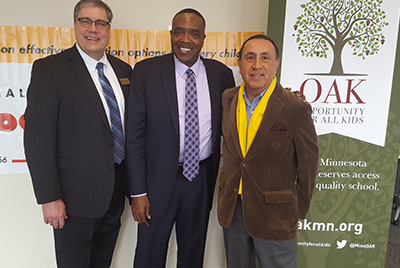 L to R: Barry Lieske, DeLaSalle; George Parker, special guest speaker and Rick Aguilar.
L to R: Barry Lieske, DeLaSalle; George Parker, special guest speaker and Rick Aguilar.
Under the legislation, contributions from individuals and corporations to a non-profit scholarship granting organization would be eligible for a 70% state tax credit, up to certain limits. Eligibility for the scholarships would be income-based; families must not earn more than twice the amount of Reduced Priced Lunch eligibility in order to qualify. The program would begin in 2018 and would be capped at $35 million in FY 2019 and $70 million in FY 2020-21.
Timing of the bill introductions coincides with National School Choice Week (NSCW).The goal of NSCW is to raise public awareness of all types of education options for children. These options include traditional public schools, public charter schools, magnet schools, online learning, private schools, and homeschooling. To meet this goal, NSCW encourages schools, organizations, and individuals to hold positive events that celebrate school choice options, while drawing attention to the need for even greater opportunities for children.
In Minnesota, NCSW efforts are being held led by Opportunities for All Kids (OAK), a statewide advocacy organization supporting public and private school choice.
OAK held a rally in the State Capitol Rotunda on Tuesday, January 24 at 11:00 am featuring former Arizona Superintendent of Public Instruction Lisa Graham Keegan and entrepreneur Reynolds-Anthony Harris, a leader of the Minnesota Harvest Initiative.
In addition, the Equity and Opportunity Scholarship Act will be heard in three legislative committees on Tuesday, January 24.
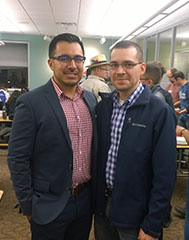 Pictured left: Ricky Coria (L) and Hernán Mercado-Corujo
Pictured left: Ricky Coria (L) and Hernán Mercado-Corujo
By Claud Santiago
The Society of Hispanic Professional Engineers held their annual Noche De Ciencias at Cristo Rey Jesuit High School on Thursday, October 27th. The organizers of the event were very pleased with the turnout of Latino students and parents.
Guest speaker Ricky Coria, an engineer with Honda R & D Americas located in Raymond, Ohio, addresses the students with a story of his efforts to get his education and career opportunities. Congratulations to SHPE-TC Chair Hernán Mercado-Corujo and its members for producing this important event.
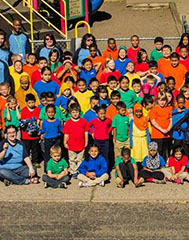 K-6 Public Charter School • www.westsidesummit.org
K-6 Public Charter School • www.westsidesummit.org
651-200-4543 • 497 Humboldt Ave Saint Paul, MN
By Anna Wagner
West Side Summit’s mission is to empower students to find joy in learning and develop the academic efficacy for the rigors of college education and beyond.
Eddie Bueno came to West Side Summit as a second-grade student. When we initially tested him for reading, he tested at a pre-kindergarten reading level. He had great comprehension and asked and answered questions. Yet, he grew frustrated with reading. He cried in the laps of our educational assistants and said he couldn’t do it. With support from Experience Corps, an individualized computer plan, intensive practice, and a burning desire to grow in his reading, he did just that. At the end of grade 3, Eddie was proficient on the Minnesota Comprehensive Assessments in both math and reading and he was reading at a fourth-grade level. He is the definition of a hard-working, college-bound scholar.
Q: What do you like to do for fun?
A: Play on the computer, prodigy; math game, you are a wizard and you do magic, to catch the monster.
Q: Do you do well in school?
A: Yes, last year I had the highest score in the whole school, in MCAs; reading and math and I think it was, science.
Q: What is your proudest accomplishment?
A: That I was able to figure out a way save a worm named fred. It’s a fake worm, you had to lift the cup that fred was under without using your hands. I poked a fork under and I pushed it up. I did that in the third grade.
Q: What is your favorite subject? And why?
A: Science, because you get to do experiment and figure out combination.
Q: What is the most important rule?
A: Treat people how you want to be treated.
 Over 12,000 Catholic grade school students, teachers, and staff at the CHS Stadium in St. Paul on September 22, 2016.
Over 12,000 Catholic grade school students, teachers, and staff at the CHS Stadium in St. Paul on September 22, 2016.
By Annemarie Hansen
Catholic schools have a long history of success in the Twin Cities. In April 2016, a new, innovative organization, the Catholic Schools Center of Excellece (CSCOE), was founded to ensure their prosperity for years to come.
CSCOE is a private, 501c3, nonprofit with a simple two-part mission: to help Catholic elementary schools achieve and maintain excellence while increasing student enrollment. Their approach is to share innovative ideas, sound business practices, proven strategies and financial resources to help meet each school’s specific business and academic needs.
Why? Because Catholic schools work. They are caring. They are community. They are known for academic excellence. And they are celebrated for instilling moral values that children carry with themselves all their lives.
“Our Catholic schools develop the character, spirituality and intellectual growth of all of our students, and this cannot be found in ANY other place besides a Catholic school. Catholic education is important in our society and for our Church. We are focused on building excellence and enrollment in our schools,” said Gail Dorn, President of CSCOE.
CSCOE has invested a total of $2.8 million in the 79 Catholic elementary schools in the Archdiocese of St. Paul and Minneapolis and supports schools in multiple areas including:
• Technology assessments of schools, enabling them to improve technological infrastructure and increase 21st-century learning opportunities in the classroom.
• Early childhood investment in 55 of 79 schools to support new or expanded preschool programs. The Preschool Network of Excellence convened as a forum for professional development and sharing of best practices for preschool leaders.
• Leadership development and support through monthly EdTalks (meetings on relevant educational topics for principals, offering them a chance to learn, network and connect) and bi-annual principal taskforces to create solutions and seek excellence.
• Marketing and Enrollment plan development and support through regional admissions squads where schools learn and share best practices. Visit www.cscoe-mn.org for more information.
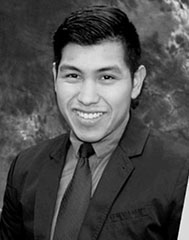
Los padres no tienen que ser expertos en todo pero sí deben estar dispuestos a ayudar
Hay muchas cosas que los padres pueden hacer para ayudar a sus hijos en su regreso a la escuela, como reemplazar la mochila vieja o comprarles los útiles que necesitan. Pero hay algo que pueden hacer que es más importante y no siempre cuesta dinero: ayudarlos con la tarea.
Hay muchas cosas que los padres pueden hacer para ayudar a sus hijos en su regreso a la escuela, como reemplazar la mochila vieja o comprarles los útiles que necesitan. Pero hay algo que pueden hacer que es más importante y no siempre cuesta dinero: ayudarlos con la tarea.
• Hablar con los hijos sobre la tarea. Es importante que los niños entien- dan la importancia de hacer la tarea y el impacto positivo que puede tener en sus calificaciones. Además de repasar y practicar lo que aprendieron en clase, la tarea los ayuda a prepararse para las lecciones del día siguiente y desarrollar la disciplina que necesitan para su éxito académico.
• Reunirse con los maestros. Cuando se trata de la tarea, los maestros pueden tener exigencias distintas. Por lo tanto es importante hablar con ellos para conocer sus expectativas. Por ejemplo, algunos maestros quieren que los padres revisen cuidadosamente la tarea de sus hijos, mientras que otros prefieren que sólo controlen que la hicieron. Además, el maestro puede contestar preguntas como cuánto tiempo debe pasar el estudiante haciendo la tarea y qué hacer si tiene dificultades o si le resulta demasiado fácil.
• Fijar un horario para hacer la tarea. El mejor momento para hacer la tarea es el que mejor funciona con las actividades del estudiante y la disponibilidad de sus papás. Puede ser antes o después de jugar, ver televisión, cenar o de hacer alguna actividad extracurricular. Lo importante es que la hora sea constante y que no sea la última actividad del día, cuando el niño esté cansado y con sueño.
• Escoger un lugar cómodo y eliminar las distracciones. Para fomentar la concentración es importante encontrar un lugar en la casa que tenga buena iluminación donde el niño pueda sentarse y hacer la tarea sin distracciones. Puede ser la mesa de la cocina, un escritorio o su propia habitación, siempre y cuando no haya distracciones como televisores prendidos o aparatos electrónicos a mano, a menos de que sean esenciales para hacer la tarea.
• Proveer los recursos necesarios. Los padres no tienen que ser expertos en todas las materias para ayudar a sus hijos con la tarea. Sin embargo, pueden proveerles los recursos que necesitan, incluyendo lápices, plumas, borradores y papel para escribir. También pueden llevar a sus hijos a la biblioteca o navegar el Internet con ellos para encontrar recursos que ayuden con la tarea. GobiernoUSA. gov, por ejemplo, tiene una sección de niños con información práctica sobre varios temas. Por su parte, el Departamento de Educación cuenta con una serie de folletos para ayudar a los hijos con la tarea de matemáticas, ciencias, lectura y comprensión. Para aprender más sobre temas relacionados a la educación se recomienda consultar GobiernoUSA.gov, el portal oficial del Gobierno de los Estados Unidos en español, que forma parte de la Administración de Servicios Generales (GSA) de EE. UU. Fuente: GobiernoUSA.gov
 Left: Leo Alcantar Parra
Left: Leo Alcantar Parra
By Mark Maribeth
The College of St. Scholastica has provided values-based education in the Catholic Benedictine tradition since 1912.
With 12 locations including campuses in Duluth and downtown St. Paul, St. Scholastica’s students form an inclusive learning community grounded in respect, hospitality, stewardship, community and the love of learning.
More than 40 undergraduate programs range from accounting, education and nursing, to social work, Catholic studies and information technology. In addition, St. Scholastica has more than 20 graduate-level programs for working adults. Evening, weekend and online programs are designed to meet the needs of busy professionals.
“I really like the program I’m in at St. Scholastica,” said Leo Alcantar Parra, a Computer Information Systems major. “It mixes the liberal arts with technical studies, which broadens the worldview of students. Especially in the technology field, if you learn about other areas and communities, it gives you ideas about what you should create.”
Parra participates in the SUCCEED program, a unique blend of online coursework and face-to-face campus support for students at the St. Paul campus. Plus, there’s a significant tuition discount. “What I like about SUCCEED is the time you get to spend with your mentor — someone who already has professional experience doing what you want to do,” Parra said.
Whether you’re a recent high school graduate, have some college experience but no degree, are changing careers, or are ready for graduate studies, St. Scholastica can help you prepare for a meaningful life and a rewarding career.
Duluth Campus:
Patrick Donaway, Admissions Counselor
651-403-8654 or pdonaway@css.edu
Twin Cities Campus:
Nu Ly, Inver Hills Campus Manager
651-403-8654 or nly@css.edu
 Left: Marci Malzahn, Founder of Malzahn Strategic
Left: Marci Malzahn, Founder of Malzahn Strategic
By Marci Malzahn
A young professional once told me, “I want to be a leader like you are.” After thanking her for the compliment, I responded, “Why do you want to be a leader? And do you think you have the gift of leadership?” Many people think being a leader is an easy task and it’s not. They only focus on the outside perceived benefits of leaders such as the big titles, having people reporting to them, making the big decisions for the companies they lead, and usually having a high salary.
Being a leader is a serious responsibility. And it is different than being a manager. Great leaders know they are responsible for their employees’ actions and the company’s outcome. They answer to the Board of Directors and to the shareholders of the company. The leaders of individual divisions or departments within large organizations answer to the CEO and are responsible for their contribution to the overall performance of the company. Everything every employee does at a company has an impact and the leaders of those employees are responsible for the positive or negative outcome.
Some people are excellent managers, yet terrible leaders because they lack the vision and fire that it takes to lead people. Others are excellent leaders. They have the power to influence others and encourage them to follow their vision—together. Yet these leaders may be poor managers because they lack the dedication it takes to execute the vision of the company down to the details. It is rare to find people who possess both the gift of leadership and the management skills.
Often, however, leaders need to be managers and managers need to lead. So, how can you do both successfully? I believe there are certain skills you can hone and talents you can develop in order to become a great leader and an effective manager.
Professionalism. Regardless of your position in a company, but especially leaders and managers, you must act professionally. Professionalism is reflected in everything you do—from your written emails, how you leave a voice mail, how you treat others (peers, vendors, shareholders, employees, customers, etc.), how you dress, to how you do presentations and conduct meetings. The way you present yourself to others matters at every level in the organization and to the public.
Assertiveness. You become assertive with experience as you learn your trade more and as you acquire working-life experience in general. Knowledge is powerful. Having a life-long learning attitude will ensure you will always be learning something new. The more you know about your specific job, industry, and company, the more assertive you become. The same way you can learn to be a better manager and leader. Don’t confuse, however, assertiveness with arrogance. No one likes arrogant people. You need to stay humble as you acquire knowledge.
Decisiveness. Leaders and managers who are able to make decisions assertively and professionally are the most respected ones. Making decisions is not an easy task and your employees expect you to make decisions with the information you have at the time—in a timely manner. Great leaders and managers own their decisions and take the responsibility for the results. It is a risk well worth taking.
Mentoring. Leaders and managers mentor others. They also have a mentor. Mentoring relationships are extremely important to succeed in business. At some point in your life, you may need a mentor to teach you from their life experiences. You will also want to mentor others as a way to give back and pass down your knowledge to the next generation. As a manager, you have a unique opportunity to mentor your employees in many ways. You can mentor them on how to succeed in their specific jobs, how to continue to grow in their careers, and how to navigate the political environment in the company (mostly companies have some politics whether we like it or not). As a leader, you have the unique opportunity to mentor the other leaders and managers under you—your executive team. You can mentor them to become better managers and in some cases, help them decide if they should stay as managers or move back to performing a non-management job.
Entrepreneurship. Regardless of the industry you work in, you will always need to develop some entrepreneurial skills in order to stay flexible, creative, and innovative. As your company grows, you need to be nimble and adjust to the new ways of doing things, accommodate to the ongoing growth, and move around within the company to fill in the gaps as needed.
Sociability. Some people hate networking. But it is a necessary skill to develop in order to stay connected to your industry, learn from your peers, find new opportunities in your career, and grow as a leader. Using humor the appropriate way is also a great tool to win others over. Humor that is simple, clean, and not degrading to others is safe to use at any occasion. People appreciate genuine friendliness too. People can tell when you sincerely care about them and when you’re only using them as a connection or to get ahead. Therefore, hone your networking skills and be genuine.
Community. Being involved in your local community is key to succeeding in your business. You should also explore involving yourself with industry associations and representing your industry in the political arena if that is something that interests you. When you apply all the ideas above, you can truly influence your community to improve the lives of others and those in your industry.
Leading and managing people is a serious responsibility. If you are a leader in the making, ask yourself the questions, “Why do I want to be a leader?” and also “Do I have the gift of leadership?” If you truly want to be a great leader, invest time and effort in developing these traits. You will then experience the wonderful feeling of leading others and helping them succeed as well.
As Latino leaders, we have an amazing opportunity to lead here in the United States. Take that opportunity and responsibility seriously and go for it! Marci Malzahn is a banking executive and founder of Malzahn Strategic (www.malzahnstrategic.com), a community bank consultancy focused on strategic planning, enterprise risk management and talent management. Marci is also an author and motivational/ inspirational speaker. You can contact Marci through her website at www.marciamalzahn.com, and for speaking engagements please contact Preferred Speakers at www.preferredspeakers.com.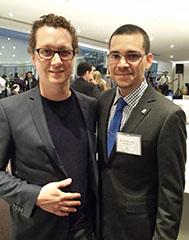 Right: Hernán Mercado-Corujo, President of SHPE-TC
Right: Hernán Mercado-Corujo, President of SHPE-TC
By Claud Santiago
The Society of Hispanic Professional Engineers, Twin Cities professional chapter (SHPE-TC) hosted their 5th Annual Scholarship and Professional Gala on Friday April 29, 2016 at the Walker Art Center. The event featured an overview of the activities of SHPE in Minnesota, as well as a keynote speech by 2015 MFESTS Young Science and Technology Professional of the Year award winner Dr. Annette Raigoza. Dr. Raigoza is an Assistant Professor of Physical Chemistry at the College of Saint Benedict and Saint John’s University, and she spoke about “Empowering and Mentoring of First Generation College Students.”
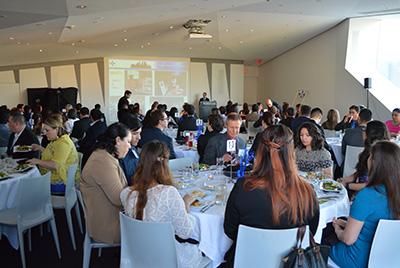
Attendees at the 5th Annual Scholarship and Professional Gala
The highlight of the night was the awarding of seven scholarships to deserving students entering Science, Technology, Engineering, and Math (STEM) fields, all made possible by the generous support and continued commitment of our chapter and scholar sponsors, 3M, Hormel, Medtronic, Mortenson Construction, and Latino American Today. The evening included live music from local talents Bob Murray, on classical Spanish guitar, and Alma Andina, performing South American Electro Cumbia, Salsa, and Merengue. “It was a wonderful evening seeing these talented students we have in our Latino community and the passion they have as they strive for their future careers. Congratulations to all of the scholarship recipients, their parents and to SHPE,” stated Rick Aguilar, Publisher of Latino American Today.
 St. Paul Police Department and U.S. Marines meet with students
St. Paul Police Department and U.S. Marines meet with students
Over 80 Latino students at Henry Sibley High School met for an after school meeting with dozens of business, education and professional mentors. The program was put together by Robert Hanson who is a teacher at Henry Sibley. Here is the message from Mr. Hanson to the Mentors after the successful meeting.
Esteemed Colleagues,
I hope that you were equally energized as the students and I were after yesterday’s meeting. The word has already spread throughout the school regarding how awesome it was- this coming from the students. As I had the luxury of standing back and observing all the groups, it was heartwarming to see how engaged all of the students and you were. The students were intent on getting all the information that you had to give.
Let me take this opportunity once again to thank you all for making the event a success. I’ll have you know that not one professional backed out after first committing. I know that all of you are busy with your work and lives so to take time to meet with the kids was so important to them.
So, a heartfelt thank you from me to you. My hope is that I will see you again so I can give you the “abrazo” that you deserve and the expression of thanks that just does not show evident in words.
—Robert Hanson
Here is the list of the Mentors who attended the meeting.
Dr. Ramon A. Pastrano, IV President and CEO ImpactLives Inc.
1. Medical
Dr. Joshua Dorn - Internal Medicine at Hennepin
County Medical Center
Dr. KrissAnn Schultz - Hematology and Oncology, Pediatric
Dr. Gloria López Franco DDS - Killian Millnar and
Associates
2. Financial/Business/ IT
Raymond Luna - MassMutual Financial Group
Angel Arreola - sales at Concur Technologies
Jeff Dietrich - Thomson Reuters
3. Marketing/Music
Rick Aguilar - CEO Aguilar Productions
Maya Santamaria - CEO Santamaria Broadcasting, - La
Raza 1400 am and Telemundo MN Owner Midwest
Latino Entertainment and Talent and El Nuevo Rodeo
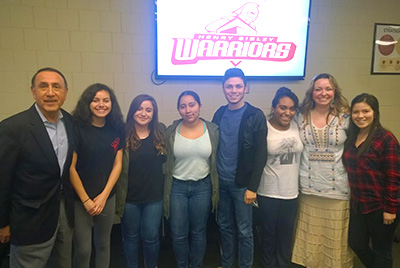
4. Education
Elia Bruggeman - Deputy Education Officer at the
Minneapolis Public Schools
Venessa Moe - Jobs for America’s Graduates
5. Law
Michael Boston - Boston Law Office specializing in
Immigration Law
6. Construction/ Engineering
Hernán Mercado Corujo - Mechanical Engineer at
Crane Engineering and President of the Society of
Hispanic Professional Engineers
Foster Hackett - Owner of Advanced Design Contracting
Pedro López - Founder and President of the Hispanic
Contractors Association of Minnesota.
Karin McCabe - Director at McGough Construction
7. Military/Police/Fire
Frank Ortiz - St Paul Police
Sergio Alvarez - U.S. Navy
Staff Sgt. Hernandez- U.S. Marines
8. Psychology
Faye Foote - A mental health counselor at The
Associated Clinic of Psychology
9. Social Work/ Public Service/ Cosmetology/ Air Traffic Control
Jim Sexton - Lockheed Martin - Sibley Grad
Josselyne Nila - Currently a student at the Minnesota
School of Cosmetology - a Sibley Grad and Former
ALMAS member
Leanny Hernández - a bachelor’s degree in Political
Science and now working at the Latino Economic
Development Center and former ALMAS member
10. Photography/ Film
Greg Winter - Director of Photography at Blue 60
Pictures
11. Automotive
Michael Lewis - WyoTech - Technical Education Recruiter
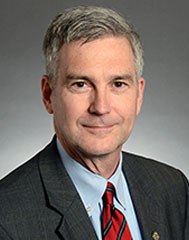
By Senator David Hann (pictured left)
Two-thirds of Latino students are not reading proficiently. Latino students are graduating high school at rates far below that of their white counterparts. For students who are learning English as a second language, their chances of doing well in school are even smaller.
This is no fault of theirs. The system is failing them.
Experts always stress the importance of education, yet the achievement gap has persisted for decades. Every year elected officials talk about how shameful it is, but every year they resist any meaningful change.
Republicans know we can close the gap and put all children—particularly minority children—on the road to a bright future.
The first key is to put parents back in the driver’s seat. Research shows students perform better when their parents take an active role in their education. One way we can do this is by giving parents more control over which school their child attends. Too many children are trapped at underperforming schools, but often there is little families can do. To address this, Republicans propose creating Education Savings Accounts. These accounts will function like scholarships, making it easier for Latino parents to send their children to a better school.
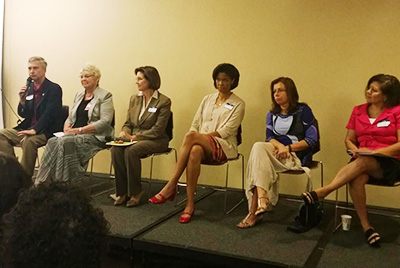
We can improve opportunities for Latino students, but we should also raise our expectations. That means requiring every student to be reading proficiently by third grade. By expecting results before promoting students to the next grade we can reduce the dropout rate, improve test scores, and make sure every child has the tools they need to perform well in school.
It’s tragic that we have failed so many students with our inaction, but with the Republican education plan and some outside-the-box thinking we can finally put every student on the path to prosperity.

By Aaron Rodriguez
When state legislators say they oppose expanding the school choice program, they’re sending a message to Hispanic parents that they’re not smart enough to decide which schools are best for their children. Allow me to explain.
Numerous surveys published recently have indicated an overwhelming support for the school choice program among Hispanic voters. According to a 2012 report published by the American Federation for Children—a pro-school choice advocacy group—91% of Hispanics in Florida, Arizona, New Mexico, New Jersey and Nevada support school voucher and scholarship programs. In Texas, a survey published earlier this year by Braun Research showed that 80% of registered Hispanic voters support school choice.
If you’re not a fan of surveys, let’s try some different numbers.
St. Anthony School in Milwaukee is now the largest private school to participate in a school choice program across the country. It wasn’t always this way. From 2002 to 2011, the school’s annual student enrollment ballooned from 400 to 1,700 students. The rate of growth is impressive; but underscoring that growth is the statistic that 99% of St. Anthony’s student body is Latino. St. Anthony’s expansion and demographics corroborate what surveys have been telling us: There is a strong demand for school choice among Hispanics.
The state Legislature should keep two things in mind when considering the expansion of school choice. First, the Hispanic community is the fastest-growing ethnic group in the country, quickly becoming an important voting bloc in American elections. Second, many of the areas targeted this year in Wisconsin for expanding school choice have growing Hispanic communities. Let’s briefly look at three of the nine areas in Wisconsin targeted for school choice expansion: Green Bay, Kenosha and Beloit.
Green Bay’s Hispanic population density is twice the state average. Hispanic population growth there has doubled the past 10 years and quadrupled in the past 15 years. Kenosha’s Hispanic population is now approaching three times the state average and has grown 79% in the past 10 years. Beloit’s Hispanic population is almost three times the state average and has grown 94% the past 10 years. Opposing the expansion of the school choice program in cities where Hispanics are quickly growing is playing political chicken with an increasingly important voting bloc.
A recent op-end submitted by a group of public school teachers argued that voucher schools are not accountable to taxpayers and have not increased student achievement beyond public schools. I won’t get into the weeds on some of the particulars, but I will point out something that seems to be ignored by the anti-school choice crowd. A five-year longitudinal study published by Patrick Wolf of the University of Arkansas showed that students in the Milwaukee Parental Choice Program were 7% more likely to graduate high school and 4% more likely to enroll in college than their Milwaukee Public Schools peers.
Nationally, Hispanic students are three times more likely to drop out of high school. Knowing that the choice schools excel precisely in the areas where Hispanics have the greatest academic deficit strengthens the argument to expand school choice into Hispanic communities.
Over the last decade, St. Anthony School in Milwaukee accepted on average more than 100 additional low-income, low-performing Hispanic students a year. For any school to expand that quickly is a risk because first-year, low-performing students will inevitably drop the schools’ average test scores.
St. Anthony accepted the risk and met the community demand. As a result, it is graduating 93% of its first senior class with a 96% college enrollment rate. St. Anthony is a good test case showing that a school consisting of 99% Latino students from low-income homes can buck the national trend, exceed the state’s high school graduation and college enrollment rates and corroborate peer-reviewed studies of the program with real results.
Like public schools, the school choice program is not without its flaws. Just saying that a school participates in the school choice program doesn’t make it a good school. We should advocate closing any school that continues to perform poorly because our kids deserve it; however, we also should balance the interest of accountability with the growing demand for school choice in populations of need.
It’s nearly impossible for good private schools in the voucher program to expand when they continue to receive a fraction of the per-pupil funding as public schools. St. Anthony was able to expand because it scraped together the resources; but not all schools in the program have the resources. Per-pupil funding for the school choice program must increase, especially for schools offering a secondary education.
Legislators should be encouraged by the Hispanic community’s desire for education reform. Hispanics like the school choice program and want it in their community. To deny them a choice among a broader marketplace of schools is no different than telling them they don’t know what’s best for their children.
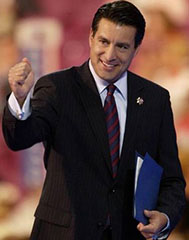
Pictured: Gov. Brian Sandoval
By SANDRA CHEREB
LAS VEGAS REVIEW-JOURNAL CAPITAL BUREAU
Gov. Brian Sandoval sat at a wooden desk Monday in a historic, creaky classroom on the famed Comstock to sign into a law a bill enacting school choice, a measure he said was equally historic for education in Nevada. Sandoval was joined by state lawmakers and others at the Fourth Ward School in Virginia City, where he signed Assembly Bill 165.
“This bill is going to make history, which is why I wanted to sign this bill at this school,” Sandoval said.
The law allows tax breaks for businesses that donate to a scholarship program for disadvantaged students to attend private school, including those run by religious organizations.
Assembly Bill 165 is part of the Republican governor’s ambitious education agenda winding its way through the state Legislature. The measure passed along party lines in both the Assembly and Senate.
The law establishes tax credits for businesses that donate money to the Nevada Educational Choice Scholarship Program, up to $5 million in the first year of the budget and $5.5 million in the second year. The maximum scholarship would be $7,755 per student.
“Up until this moment, we have not had true school choice in Nevada,” Sandoval said.
A second-term Republican who handily won re-election in November, Sandoval has long been an advocate for school choice, though his plans were thwarted in 2011 and 2013 by a Democratically controlled Legislature. That changed this year, when Republicans took command of the Senate and Assembly following a “red wave” election last fall.
“Today is a day I’ve been looking forward to for a very long time,” Sandoval said.
Democrats opposed the bill, arguing it would funnel money from public schools through tax breaks to benefit private schools.
Under the law, students in kindergarten through 12th grade who have been enrolled in public school for at least 100 consecutive days can receive the per-pupil amount guaranteed by the state to attend a private school.
Students in poverty or with special needs will receive 100 percent of the per-pupil funding, while other students can get 90 percent.
Nevada is the fifth state to create an education savings account program, according to The Friedman Foundation for Education Choice, a nonprofit group that advocates for educational options.
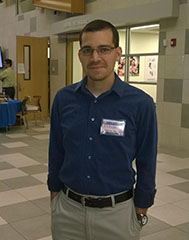
Hernan Mercado-Corujo
President of SHPE-TC
The Society of Hispanic Professional Engineers (SHPE) presented the Noche de Ciencias/Science Night on October 22 at Cristo Rey Jesuit High School in Minneapolis. The event drew over 50 energetic Latino students, some coming with their parents. The program agenda included a presentation from SHPE member, Christopher Chapa who works as a test development engineer at Medtronic. Chapa, who is from Texas, was an excellent student who was the Valedictorian of the 2009 class of IDEA preparatory high school in Donna, TX.
Christopher attended Cornell University; it was there that he joined SHPE. He also received his Master’s degree from Cornell. Chapa discussed the STEM program, the collaboration among business, education, civic and community leaders to increase the appeal of science, technology, engineering and mathematics for Latino students and their families.

Afterwards, there was a meeting of students, parents and SHPE leadership to discuss attending college and the scholarships available. Dinner and refreshments were available to all. It was a great night, thanks to SHPE and the sponsors of Science Night, Medtronic, Hormel, 3M, and Latino American Today.

Flex Academy Staff:
Hector Betance and Keri O’Keefe
Por Keri O’Keefe
Flex Academy es una escuela charter nueva gratuita localizada en el centro comercial “HUB” en Richfield disponible para estudiantes de sexto y séptimo grado (se añadirán los grados de 8-12 en los próximos años). Flex en un rediseño completo de la educación publica y es única en su habilidad de suplir las demandas de los estudiantes de todas capacidades, nuestra misión en proveer una experiencia de aprendizaje personalizada para cada uno de nuestros estudiantes. Podremos lograr esto ofreciendo lecciones en línea juntamente con instrucción personal en los salones de clase proporcionada por maestros con licencia en el estado de Minnesota. Sea que necesite apoyo adicional en un área, o esté listo para un reto mayor, Flex tiene la habilidad de personalizar la experiencia de aprendizaje de cada estudiante a través de su modelo educacional de clases en línea o en salón.
Además de nuestra enseñanza personalizada, Flex Academy ofrece un ambiente de enseñanza pequeño y seguro. Todas nuestras clases serán de 18 estudiantes o menos. Estos grupos pequeños permitirán a nuestros maestros satisfacer las necesidades sociales y académicas de nuestros estudiantes para crear una comunidad de apoyo al aprendizaje.

Flex Academy está inscribiendo alumnos para sexto y séptimo grados para el año escolar 2015-2016 (se añadirán los grados de 8-12 en los próximos años). Flex Academy ofrecerá transporte gratuito a los estudiantes que vivan en Richfield, Bloomington, en el sur de Minneapolis. Si está interesado en obtener más información acerca de Flex Academy llámenos al 612-470-0601 o visítenos en línea en www.mnflex.org.

Panelist and Attendees at the Summit.
By Claud Santiago
Afull house turnout attended the Latino Education Achievement Gap Summit that was held on Saturday morning, August 8, at the Neighborhood House in St. Paul. The Summit was part of the 13th annual La Familia Latino Family Festival & Expo produced by Aguilar Productions. Over 100 attendees representing community,
Latino youth, educators, private and public schools, superintendents and business and political leaders attended this important gathering. Several panels presented data, demographics, case studies and discussion about the Achievement Gap that is the worst in the country. Consensus of the attendees was that all options should be on the table in order to make changes andgains in the Latino high school graduation rates. The next Summit is scheduled for February 2016.
For more information contact Aguilar Productions at 651-665-0633 or email
aguilarproductions@msn.com
“Rick, everyone at the summit was highly engaged, and there was general consensus that we can close the Latino achievement gap only if we all work together to achieve this goal-legislators, school leaders, teachers, parents, students and the broader community. It’s in everyone’s best interests because children shape our future.”
Jill Reilly
President
Education, Leadership and Management Consultants
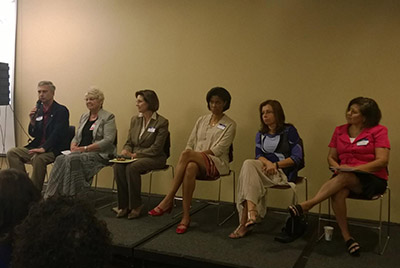
One the key panels at the Summit. The Policy Leaders panel.
“Richard, thank you for facilitating this great gathering. I thought the conversation was great, and a wonderful mix of people that impact education. We look forward to supporting this effort.”
Poppy Potter
Director of Operations
Twin Cities Center
Voyageur Outward Bound School
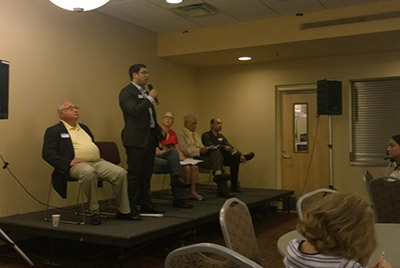
Victor Cedeno, Generation Next, presented on the “Status Quo is Not Working” Panel.
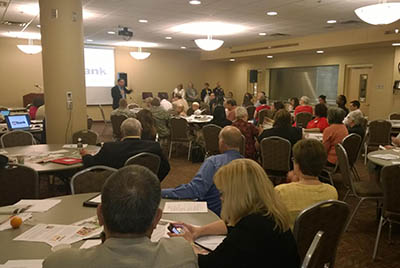
The “What’s Working” panel.
“It was a great day, we want to thank all the attendees and panelists for being part of this important Summit.”
Rick Aguilar
Aguilar Productions
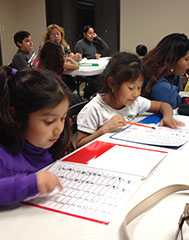 Pictured left: Young students at Garlough Environmental Magnet School
Pictured left: Young students at Garlough Environmental Magnet School
By Gina Nyhus
At Garlough Environmental Magnet School, there has been an idea floating around for many years. That idea was to place a satellite classroom in a nearby apartment building as a way to engage more Latino parents. On January 8th, 2014 the Native Language Literacy Class began and this idea became a reality.
There has been a definite need for this type of program at Garlough. This school year, 39% of our students are Latino. Many of them live in a cluster of apartments near the Oakdale/Marie Ave intersection in West St. Paul and do not always have transportation to come to school events. Many of these students are also not meeting grade-level academic standards. However, our Spanish-speaking parents want to learn how they can better support their child’s learning, as well as maintain their Spanish language skills.
Since I started at Garlough as an AmeriCorps VISTA in 2013, it has been my job to build this program from the ground up. Now that the legwork is done, our class has been running smoothly. We meet almost every Wednesday evening in the Westview Park Apartments community room. Alana Lucio Thomas teaches the class completely in Spanish. Our main goal is to reinforce the skills and concepts that are being taught in regular classes, as well as increasing parent involvement by introducing activities that can be replicated and expanded upon at home. Lately, we have had about 20 people attend each class including students, siblings, and parents. One parent said, “Gracías por pensar en estas clases de español. Es muy importante que los niños aprender a temprana edad.” Another mom said she learned “que pueden aprendar el alfabeto en dos idiomas sin equivocarse o confundirse.” All of these parents are eager to help their children learn, and we are simply empowering them to do just that.
Editor’s Note: This program received funding from ISD 197 Education Foundation.
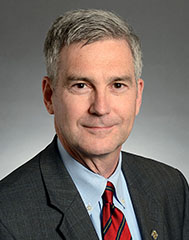 Pictured left: Senate Republican Leader David Hann
Pictured left: Senate Republican Leader David Hann
By Senator David Hann
Think of three Latino children you know in Minnesota. Chances are, one of them is living in poverty. Chances are even higher that one of them is attending a failing school district in Minneapolis or St. Paul.
Recent high school test scores paint a dismal picture for students living in the Twin Cities. Compared to white students, Latinos are especially disadvantaged, with about 70% of students unable to read as well as expected for their grade level.
Many community leaders claim the key to a successful future is a quality education, but few are willing to make the changes necessary to give Latino students a fighting chance. Republicans think they can change those poor statistics into success stories for our kids with education reforms focused on increasing achievement levels and giving students the opportunity to leave failing schools.
One Republican idea is to provide “opportunity scholarships” to students in poverty. Under this plan, Latino parents can decide which school their child will attend and give them the best opportunity to succeed. A similar bill geared toward special needs families also allows parents to choose the school that will best suit their child’s unique needs. Students would be able to attend their school of choice for free, rather than forcing them into schools that continually fail to provide a good education.
Another plan offered by Republicans is to make sure all students are able to read English by third grade. Up to 67% of Latino students in Minneapolis who don’t speak English as their primary language will drop out of high school before graduating. Republicans want to provide extra help to those kids in their early school years to reduce the drop-out rate and give them better career opportunities later in life.
Minority students, particularly Latinos, have been left behind in poorly performing schools for decades. These Republican education plans aim to end the cycle of poverty and give all students a fighting chance at success.
 Pictured left to right: Anoka HS Jovenes de Salud group, left to right: Taylor Larson, Ari Lott, Myriam Parada, Merry Cayetano, Noela Tabukum, Karina Rodriguez
Pictured left to right: Anoka HS Jovenes de Salud group, left to right: Taylor Larson, Ari Lott, Myriam Parada, Merry Cayetano, Noela Tabukum, Karina Rodriguez
By Carmen Robles, Director Latino Achievement Gap Pilot Project
JdeS board member Jaisey Fuentes is attending the UofM and suggested to her friend Myriam Parada she contact JdeS for assistance in a senior, graduating project at Anoka High School.
The group first met in December and decided to collect clothes for homeless youth in Anoka County. On Wednesday, February 25th the JdeS Anoka High School group met at Hope 4 Youth, an organization serving homeless youth in Anoka County www.hope4youthmn.org.
The JdeS Anoka HS group used Face Book as their main outreach tool and received donations from family, friends, neighbors, school and church. Most items were slightly used and were all washed before they were donated.
Myriam Parada, group spokesperson explained why they decided on clothing for homeless youth:
“It was for Anoka high school senior project. Which is a project that helps the community. We picked clothing the homeless because we think that many people had the idea of the stereotypical homeless person who sits on the corner asking for money for a drug addiction. We wanted people to know that there are many youth who are homeless sitting in school right next to you, but you wouldn’t even know. We wanted them to know that most if not all of the time these kids have no fault on being homeless. Sometimes kids families don’t have financial resources, sometimes there is abuse going on, unfortunately many times parents just don’t care for their children as much as they care for other unnecessary things. That’s what we want people to know. To not be so judgemental or rude because we never and will never really understand what battles the person who we just yelled at could be facing”.
Jovenes de Salud (JdeS), Latino Youth taking action for Health, Education and Economic Strength is a peer-to-peer youth leadership organization leading stay-in-school initiatives.
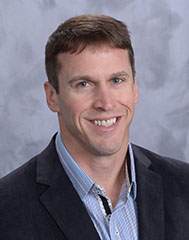 By Jay Wendell, Student Loan Debt Relief Specialist
By Jay Wendell, Student Loan Debt Relief Specialist
When most people enter college, they will incur a fair amount of student loan debt. Although it isn’t necessary for most students, it’s what usually ends up happening for one reason or another. It is a problem that will plague most graduates for many many years after they graduate.
A recent study by the Center for American Progress found that twothirds of students who earn undergraduate degrees have more than $25,000 in Student Loan Debt and 1 in 10 owe more than $54,000.
Many students with larger Student Loan Debt choose the term extension option to make the monthly payments more manageable. Though these payments become more manageable with choosing the longer term; studies show that the larger the Student Loan Debt and the longer the term is, the more likely it will be for borrowers to fall behind on these payments and ultimately default on their Student Loans.
Analysis of National Center for Education Statistics (NCES) data shows higher student loan default rates for Hispanic students, students who leave college with a heavy debt burden and college graduates who take lowpaying jobs.
In 2011, NCES data also showed that only 13.2% of all US Latinos over the age of 25 had bachelor’s degrees, compared to 31.8% of their white peers. Latinos, who continue to face an achievement gap, state that the most common reason for this gap was pressure to support their families financially as reported in a 2009 Pew Hispanic Center Survey. This pressure forces many Latinos to choose between attending college or caring for their families.
The financial impact of heavy Undergraduate Student Loan Debt combined with the pressure to to care for their families may dissuade many future Hispanic generations from choosing college or any other postsecondary option; thus, the Latino Achievement Gap continues.
For all Student Borrowers, there are many recommendations to help with managing your Student Loans; i.e. track your balances, know your deferment and forbearance options, review your consolidation options, start a separate account and start “paying” your Student Loans while you’re still in college, etc.
Another option which every borrower should consider is consulting with a Student Loan Specialist about the options to manage your Student Loan Debt. Beacon Student Loan Services is a Twin Cities company that is registered with and certified by the Association For Student Loan Relief www.AFSLR.org. Beacon Student Loan Services can provide an independent analysis of your Student Loan Repayment Options and help you review the many programs that are available to Student Borrowers to help with their monthly Student Loan Payments.
Even though many Student Loan Servicers will promote that these options can be obtained through them by yourselves; there has been numerous studies by the Consumer Finance Protection Bureau that have shown that these Servicers are more concerned about their own bottomline financials than they are about the Student Borrowers’ most beneficial repayment options.
With their proprietary software and Department of Education (DOE) interface, Beacon Student Loan Services can help you decide the most beneficial repayment option, determine your eligibility for Student Loan Forgiveness and complete all of the necessary paperwork to finalize your Student Loan Consolidation and Enrollment through the experienced, professional help of their Underwriters and Processors that have a combined 47+ years of working with Student Loans and the DOE.
Beacon Student Loan Services also provides Rehabilitation and Reconciliation Services to help with Defaulted Student Loans which will stop any Wage or Tax Garnishment and ultimately regain your DOE eligibility to request additional Student Loans to finalize your schooling or degree.
Beacon Student Loan Services is fully compliant with the DoddFrank Act and the Consumer Finance Protection Bureau.
Call Beacon Student Loan Services today tollfree at 1.855.777.6555 or email them at info@beaconsls.com for a free, noobligation, confidential consultation to help with managing your Student Loan Debt.
 By Aaron Rodriguez
By Aaron Rodriguez
When state legislators say they oppose expanding the school choice program, they’re sending a message to Hispanic parents that they’re not smart enough to decide which schools are best for their children. Allow me to explain.
Numerous surveys published recently have indicated an overwhelming support for the school choice program among Hispanic voters. According to a 2012 report published by the American Federation for Children — a pro-school choice advocacy group — 91% of Hispanics in Florida, Arizona, New Mexico, New Jersey and Nevada support school voucher and scholarship programs. In Texas, a survey published earlier this year by Braun Research showed that 80% of registered Hispanic voters support school choice.
If you’re not a fan of surveys, let’s try some different numbers.
St. Anthony School in Milwaukee is now the largest private school to participate in a school choice program across the country. It wasn’t always this way. From 2002 to 2011, the school’s annual student enrollment ballooned from 400 to 1,700 students. The rate of growth is impressive; but underscoring that growth is the statistic that 99% of St. Anthony’s student body is Latino. St. Anthony’s expansion and demographics corroborate what surveys have been telling us: There is a strong demand for school choice among Hispanics.
The state Legislature should keep two things in mind when considering the expansion of school choice. First, the Hispanic community is the fastest-growing ethnic group in the country, quickly becoming an important voting bloc in American elections. Second, many of the areas targeted this year in Wisconsin for expanding school choice have growing Hispanic communities. Let’s briefly look at three of the nine areas in Wisconsin targeted for school choice expansion: Green Bay, Kenosha and Beloit.
Green Bay’s Hispanic population density is twice the state average. Hispanic population growth there has doubled the past 10 years and quadrupled in the past 15 years. Kenosha’s Hispanic population is now approaching three times the state average and has grown 79% in the past 10 years. Beloit’s Hispanic population is almost three times the state average and has grown 94% the past 10 years. Opposing the expansion of the school choice program in cities where Hispanics are quickly growing is playing political chicken with an increasingly important voting bloc.
A recent op-ed submitted by a group of public school teachers argued that voucher schools are not accountable to taxpayers and have not increased student achievement beyond public schools. I won’t get into the weeds on some of the particulars, but I will point out something that seems to be ignored by the anti-school choice crowd. A five-year longitudinal study published by Patrick Wolf of the University of Arkansas showed that students in the Milwaukee Parental Choice Program were 7% more likely to graduate high school and 4% more likely to enroll in college than their Milwaukee Public Schools peers.
Nationally, Hispanic students are three times more likely to drop out of high school. Knowing that the choice schools excel precisely in the areas where Hispanics have the greatest academic deficit strengthens the argument to expand school choice into Hispanic communities.
Over the last decade, St. Anthony School in Milwaukee accepted on average more than 100 additional low-income, low-performing Hispanic students a year. For any school to expand that quickly is a risk because first-year, low-performing students will inevitably drop the schools’ average test scores.
St. Anthony accepted the risk and met the community demand. As a result, it is graduating 93% of its first senior class with a 96% college enrollment rate. St. Anthony is a good test case showing that a school consisting of 99% Latino students from low-income homes can buck the national trend, exceed the state’s high school graduation and college enrollment rates and corroborate peer-reviewed studies of the program with real results.
Like public schools, the school choice program is not without its flaws. Just saying that a school participates in the school choice program doesn’t make it a good school. We should advocate closing any school that continues to perform poorly because our kids deserve it; however, we also should balance the interest of accountability with the growing demand for school choice in populations of need.
It’s nearly impossible for good private schools in the voucher program to expand when they continue to receive a fraction of the per-pupil funding as public schools. St. Anthony was able to expand because it scraped together the resources; but not all schools in the program have the resources. Per-pupil funding for the school choice program must increase, especially for schools offering a secondary education.
Legislators should be encouraged by the Hispanic community’s desire for education reform. Hispanics like the school choice program and want it in their community. To deny them a choice among a broader marketplace of schools is no different than telling them they don’t know what’s best for their children.
 By Shawn M. Peterson
By Shawn M. Peterson
Originally printed in The Catholic Spirit, November 6, 2014 edition
Of all the important and interesting policy areas I work on, none is more personal than education.
Education issues have always held a particular interest for me. This interest has been greatly influenced by my own experience growing up, and now by experiences my wife and I have had with our three children’s education.
When it came time for my wife and me to send our first child to school, we did some research. We attended open houses, talked to friends and neighbors, and looked into all our options in the area, including the public, charter and private schools. We live in an area that has great options for all three, an embarrassment of riches as education goes. After much discussion, prayer and discernment, we made our choice — a choice based on what we wanted for our children and what best fit our family’s all-around education needs. It wasn’t the newest school, the biggest school or even the most well-funded school, but it was the best school for our kids.
My parents had choices, my wife and I had choices. Yet for tens of thousands of families in Minnesota, there are no choices. At a Latino education summit I attended, the Minnesota commissioner of education, Brenda Cassellius, stated that Minnesota was No. 1 in the nation for providing school choice. She said we have great public, private, charter and homeschool options. Yes, commissioner, we do have “options” in our state, but options don’t equal choices. An option is something that exists; a choice is something you have the ability to make.
For too many in our state — especially those who live in minority communities, disadvantaged neighborhoods or many rural communities, and for families who are struggling economically — there is only one option. Therefore, there is no choice. Many parents are forced to send their children to the local school that might be failing to educate their child or meet their needs as parents. Those parents feel trapped and are unable to fulfill their responsibility as the first educators of their children. Catholic social teaching is clear on this: Parents are the first educators of their children and therefore, must have choices to appropriately address their educational needs.
In Blessed Pope Paul VI’s “Declaration on Christian Education,” he states:
“Parents who have the primary and inalienable right and duty to educate their children must enjoy true liberty in their choice of schools. Consequently, the public power, which has the obligation to protect and defend the rights of citizens, must see to it, in its concern for distributive justice, that public subsidies are paid out in such a way that parents are truly free to choose according to their conscience the schools they want for their children.”
Parental choice in education is important because no one knows a child better than his or her parent. No one else should be able to judge better on a daily basis if their child is learning. No one should know better what their child is going through at school or if their education needs — no matter what they are — are being met. A parent has to have the ability to say, “This school isn’t the best fit for my child and I need to make a different choice.” But if no opportunity for choice exists, it doesn’t matter what the parent knows or thinks; they are rendered powerless. And no parent should have to feel that way when it comes to their child’s future.
Through legislation, such as an Opportunity Tax Credit Scholarship bill, parents would have the ability to take advantage of actual options and make a real choice. In the next “Faith in the Public Arena” column, I will address in more detail what some of these legislative solutions might look like.
Peterson is the associate policy director of the Minnesota Catholic Conference.
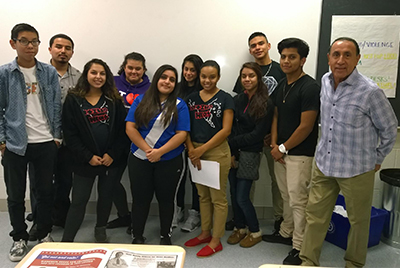 Harding High School Students
Harding High School Students
Back row: Issac, Genesis, Tatiana, Jeovani
Front Row: Juan, Yabi, Sulmy, Gabby, Jennifer, Erwin, and Rick Aguilar
By Claud Santiago
The recently launched Achievement Gap Pilot Project kicked off at Harding High School in St. Paul.
Carmen Robles, director of Jovenes de Salud hosted a meeting for the Harding Latino HEAT group,which was formed in 2006 by Ms. Robles.
The goals of the Pilot Project are to:
*Support academic goals and build school spirit
*Encourage completion of high school education
*Engage Parent involvement through youth led presentations
*Cultivate the pursuit of higher educational goals by providing mentor opportunities.
“I was pleased to be part of this kick off meeting, and meet these wonderful kids who deserve the opportunity to obtain the American Dream...and they will with hard work and determination,” stated Rick Aguilar who is a mentor for the Jovenes de Salud group.
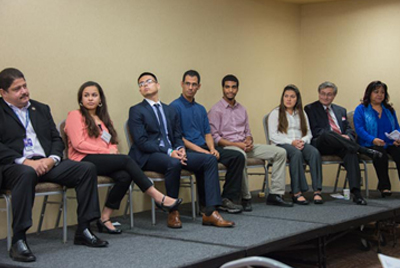 Latino Education Summit Youth Leadership Panel
Latino Education Summit Youth Leadership Panel
L to R: Miguel Ramos, Minnesota Twins; Jóvenes de Salud members Carissa Ontiveros, Manny Hernandez, Rafael Alvarez, Yorki Ramirez, Breidy Garcia; Dr. Jose Wm. Castellanos; Patricia Baker, Ramsey County
By Carmen Robles
Jóvenes de Salud proposes a pilot program that will use the established the model to recruit chapters in 5 participating high schools in four districts: Schools to be named at press conference.
PILOT PROGRAM SNAPSHOT GOALS:
1. To recruit and engage 150 Latino middle and high school students in the leadership pilot program in three schools in St. Paul and two in rural MN., providing leadership, mentors, tutors, peer training, supporting community outreach efforts, and other relevant activities designed by the JdS participants.
2. To help build school spirit, promote higher educational goals, and encourage JdS participants to pursue careers that are relevant to the empowerment of their communities.
3. To become leaders who promote healthy life styles, and are community, bilingual and bicultural advocates to deliver culturally specific educational presentations on relevant topics identified in a participatory process and adopted by JdS consensus.
4. To adopt a youth apprenticeship model of combining academic goals with actual hands-on work experiences. The program will be supported by a mentor and sponsor components.
5. To evaluate the program, including an external evaluation by HACER and anecdotal evidence from the participants.
OBJECTIVES:
1. Develop peer educators for the delivery of peer to peer presentations.
2. Support academic goals and build school spirit.
3. Encourage completion of high school education by combing academics with hands-on experiences.
4. Engage parent involvement through youth led presentations.
5. Cultivate the pursuit of higher educational goals by providing mentor opportunities.
Jóvenes de Salud Background Information:
Jóvenes de Salud, Inc. Latino Youth Taking Action for Health, Education and Economic Development is an award winning culturally competent and linguistically appropriate community-based participatory leadership program designed to empower students to become a community leaders and advocates.
Through the Jóvenes de Salud afterschool program, Latino youth are taught valuable skills of community organizing, advocacy, participation in the democratic system, civic engagement, and a sense of responsibility for improving their social status and that of their communities. These skills will help to foster their self-esteem and shapes the potential future leaders of one the fastest growing minorities of the US.Youth are engaged in every step of the way, creating a participatory process that promotes ownership over accomplishments. Jóvenes de Salud creates a safe space and a network of students who can encourage, help, and protect each other while working towards a common, positive goal of environmental change.
Carmen Robles, President
Jóvenes de Salud, Inc.
rinconcr@yahoo.com
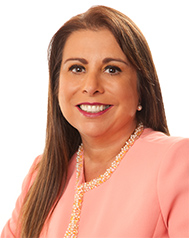 Pictured left: Valeria Silva,
St. Paul School Superintendent
Pictured left: Valeria Silva,
St. Paul School Superintendent
By Claud Santiago
La Familia 2014 will open the day with an Education Summit that will bring together education, political, and faith leaders along with Hispanic community, business, civic, and youth leadership. Minnesota has the distinction of having the highest high school dropout rate in the country for Latino students. Less than 50% of Latinos graduate from high school in Minnesota. In the Twin Cities, Minneapolis only graduates 43 % of all Latinos. St. Paul is slightly better but still way below the rate of white high school graduates.
“This graduation rate is a crisis for the Latino community and the state of Minnesota,” stated Sam Hernandez, one of the organizers of the Education Summit. Rick Aguilar, producer of La Familia, is pleased to be hosting this Summit. “This achievement gap is unacceptable and we need to answer the challenge and began the process of closing this gap,” Aguilar explained.
Hector Garcia, executive director of CLAC, along with Sam Hernandez, went about forming a coalition to help produce the Summit. Carmen Robles, director of Jovenes de Salud, is organizing Latino youth leaders who will be participating in a panel.
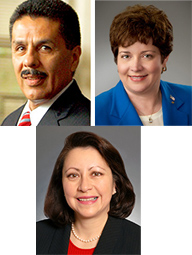 Top row, from left to right: Michael Munoz, Rochester School Superintendent,
Senator Carla Nelson; bottom: Senator Patricia Torres Ray
Top row, from left to right: Michael Munoz, Rochester School Superintendent,
Senator Carla Nelson; bottom: Senator Patricia Torres Ray
The panelists and speakers at the Summit will present and discuss ideas, solutions, case studies, and plan of action to combat this education crisis.
Speakers and Panelists include:
Archbishop, John C. Nienstedt
Alberto Fierro, Consul, Mexican Consulate in St. Paul
Commissioner Brenda Cassellius, Minnesota Dept. of Education
Joe Nathan , Center for School Change
Senator Foung Hawj
Rep. Sondra Erickson
Valeria Silva, St. Paul School Superintendent
Michael Munoz, Rochester School Superintendent
Hector Garcia, CLAC
Sam Hernandez, Diversity consultant
Michael Goar, CEO Minneapolis Public Schools
Rodolfo Gutierrez, HACER
Mitch Pearlstein, Center of the American Experiment
Elia Bruggeman, MN Dept. of Education
Senator Patricia Torres Ray
Senator Carla Nelson
Larry Lucio
Rob Hanson, Henry Sibley H.S.
Fr. Tim Manatt, Cristo Rey H.S.
Carlos Gallegos, Think Small
Carmen Robles and Jovenes de Salud
And others to be announced.
ATTENDANCE IS FREE, SPACE IS LIMITED. YOU NEED TO RSVP!
Email aguilarproductions@msn.com or call 651-665-0633
 You don’t need to be an expert on every subject, just be willing to help
You don’t need to be an expert on every subject, just be willing to help
There are many things you can do to help your kids start the school year on the right track, like replacing an old backpack or getting them the school supplies they need. But there’s something more meaningful you can do that may not cost money: help them with their homework.
Students who do their homework consistently tend to have better grades. It’s not always easy to get them to do their homework, especially after a busy day, but these tips can help:
• Talk to your children about their homework. It’s important that your kids understand why it’s important to do their homework and the positive impact it has on grades. Homework helps them practice what they’ve learned as well as prepare them for upcoming classes. Plus, by doing their homework they develop the discipline and skills they need to be successful throughout their school years.
• Talk to the teachers. Different teachers might expect different things from parents, so be sure to talk to them to figure out your role. For example, some teachers prefer parents review their kids’ homework; others prefer parents make sure kids do their homework. Teachers can also tell you how much time your child should spend doing homework and what to do if the homework is too easy or too difficult.
• Select a fixed time to do homework. The best time to do homework is the one that works best for your child and you. It can be before or after playing, watching television or dinnertime. What’s important is that homework time is consistent. Avoid leaving it for the end of the day, when your child is tired and sleepy.
• Pick a quiet area and eliminate distractions. To help your children focus on homework, pick a place in the house where there’s plenty of light and no distractions. It doesn’t have to be fancy. It can be the kitchen table or a desk. Make sure the TV is off and put away electronic devices, unless they’re essential to doing homework.
• Get them the resources they need. You don’t have to be an expert in all subjects to help your kids with homework. However, you need to make sure they have the tools they need to succeed. If you need expert help, you can always take them to the library or help them with their search online. You can also visit kids.gov to find information on homework topics. The Department of Education also has several resources to help your child with homework in different areas, including math, reading and writing.
USA.gov and GobiernoUSA.gov are the U.S. Government’s official web portals in English and Spanish, and part of the U.S. General Services Administration (GSA).
School Lunches! What’s a parent to do?
• Read food labels and compare the sodium amount in different products, then choose the options with the lowest amounts of sodium. Some varieties of bread can vary from 80 to 230 mg of sodium per slice! That can make a big difference in lunchtime sandwiches.
• Pack fresh fruits and vegetables with lunch every day.
• For a healthy snack, make trail mix using unsalted nuts, dried fruits, and whole grain cereal.
• When buying prepared meals, look for those with less than 600mg of sodium per meal.
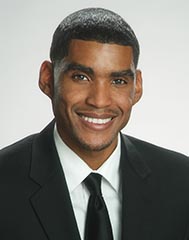 Pictured: Jovan Agee
Pictured: Jovan Agee
By Jovan Agee
Across the country, students and teachers are celebrating. In his decision in Vergara v. California, Judge Rolf M. Treu affirmed that California’s students have a constitutional right to educational equality.
This ruling is a huge win for kids and teachers in the Golden State.
The journey towards this decision began in May 2012, when nine courageous public school students filed a lawsuit in Los Angeles Superior Court. They challenged several statutes that forced schools and districts to push out great teachers and retain ineffective ones—thus directly harming students.
For instance, state law required that, in the unfortunate case of layoffs, the last teacher hired be the first teacher fired—regardless of the teacher’s effectiveness. Known as “last-in, first-out” (LIFO), this policy guarantees that great teachers will be taken away from the students who need them.
Additionally, the plaintiffs challenged laws that awarded tenure before teachers showed a track record of success and made it nearly impossible to remove ineffective teachers from the classroom.
It’s easy to see how these laws deny students the right to equal educational opportunity. Research shows that teacher quality is the most important in-school factor affecting student achievement. Therefore, if we want to maximize student achievement, we need the best teachers in our classrooms. And the statutes that were challenged in Vergara worked directly against that goal.
It’s no surprise, then, that the case has kick-started a desperately needed national conversation on the structural flaws of our public education system. For far too long, harmful and illogical policies have persisted simply because they were considered politically untouchable. It is my sincere hope that we will ride this momentum and work towards making the reforms necessary to ensure that every student receives a great education.
The nine brave plaintiffs and Students Matter deserve our gratitude for filing this case. Challenging powerful groups that are committed to preserving the status quo is a daunting task.
*Editors Note: Minnesota is one of only 11 states to support LIFO policies. Help us change this harmful policy in Minnesota by visiting: http://www.StudentsFirst.org/Minnesota.
Jovan Agee currently serves as the State Director for StudentsFirst California. He has previously worked as director of political and legislative affairs for a local labor organization in his home state. Agee holds a Bachelor of Arts degree in government from California State University, Sacramento.
 Pictured: Veronica Chapel
Pictured: Veronica Chapel
By Veronica Chapel
All parents want their child to attend a great school, but did you know you have choices when it comes to the school your child attends? As another school year ends, now is the time to reflect on whether your child’s school is a good fit or if it is time to make a change.
To make the best decisions, parents need meaningful information about their local schools. They need to know which schools serve children well, how schools compare with each other, and which schools can best meet their child’s specific needs.
StudentsFirst supports empowering parents, so we want to provide you with some useful tools that you can use to determine if your child’s school is the best fit. We advocate for policies that ensure parents have access to meaningful data about schools because informed parents make the best choices for their kids. We also support increasing the number of high-quality school options.
With just a click of a button you can find out more about the schools in your community. Here are a few resources:
Charter School Partners (CSP) recently launched a website called MinneapolisSchoolFinder.org to help Minneapolis parents find the best school for their child. CSP focuses on schools getting strong academic results for kids.
The Minnesota Department of Education (MDE) also recently developed a new School Report Card website to give families easy access to district and school information and student test results. Parents can review and compare schools. Visit rc.education.state.mn.us to view the MDE School Report Card.
Greatschools.org is another great site to learn about the academic achievement of schools in our state. To find Minnesota schools go to: greatschools.org/minnesota.
StudentsFirst supports a parent’s right to choose from both high quality traditional public schools and public charter schools in their community. To learn more about our work and to join our movement, please visit our website at www.studentsfirst.org/minnesota or e-mail us at minnesota@studentsfirst.org.
Veronica Chapel serves as Field Coordinator for StudentsFirst Minnesota. Before joining StudentsFirst, Veronica worked on staff in the Minnesota Legislature and served in the Minnesota Army National Guard.
 Pictured: Veronica Chapel
Pictured: Veronica Chapel
By Veronica Chapel
All parents want great teachers for their children. But as the current legislative session comes to a close, some Minnesota legislators are standing in the way.
Shockingly, Minnesota is one of only a handful of states left that forces school leaders to consider seniority over effectiveness when staffing their schools. This could mean that great teachers are removed from the classroom. Furthermore, studies show that this policy disproportionately impacts children of color.
We must change this harmful policy.
But that’s not all that we need to change. No child should have an ineffective teacher for even one year. Research tells us that a student with an ineffective teacher can learn 50 percent less over a school year than one with an average teacher.
But having an ineffective teacher for two years in a row? That can have a devastating effect on a student, and should be prohibited by law.
That’s why your voice is extremely important. We need you to remind legislators that you’ll stand with them if they vote “yes” to support policies that ensure the best interests of kids--even in an election year.
Get involved. Contact your legislators and let them know they need to stand up for Minnesota’s students!It’s not too late for lawmakers to find common-sense solutions, but time is running out. Legislators will cast their votes in the next hours and days, so they need to hear from you as soon as possible. By taking action, you can make a difference!
Get Involved With StudentsFirst Minnesota!
Email Veronica Chapel at Minnesota@studentsfirst.org and visit www.StudentsFirst.org/Minnesota.
Veronica Chapel serves as Field Coordinator for StudentsFirst Minnesota. Before joining StudentsFirst, Veronica worked on staff in the Minnesota Legislature and served in the Minnesota Army National Guard.
 Pictured: Veronica Chapel
Pictured: Veronica Chapel
By Veronica Chapel
As highlighted by the 2014 Minnesota Education Summit, a persistent achievement gap has impacted Minnesota’s students for too long. In one example, only 23% of Hispanic students are proficient in reading. The inability of antiquated policy structures to meet the needs of students is clear, and unacceptable.
As the 2014 legislative session kicks off, there’s never been a more important time to have a robust discussion about how to improve education in Minnesota. Lackluster results implore state leaders to take bold and action.
The StudentsFirst Policy Report Card provides a roadmap for us to improve. Currently we’re ranked 34th in the nation, down eight spots from 2013. Overall, we earned a “D” on the 2014 report card with a 1.19 GPA. We can and must do better.
It’s time to repeal outdated laws that prohibit school leaders from keeping the most effective teachers in Minnesota’s classrooms. We know that teacher quality is the most important in-school factor affecting student achievement. That’s why we must support school leaders who are asking for changes in state law so they can retain highly effective teachers.
We must prohibit students from being assigned to an ineffective teacher for consecutive years. An ineffective teacher generates 50% less learning over the course of a single school year than an average teacher. Our kids deserve better.
For us to be successful we must have a sense of urgency and work together to ensure all of Minnesota’s students receive a world-class education. We cannot allow our policy system to fail them or our children any longer.
Veronica Chapel currently serves as a Field Coordinator for StudentsFirst Minnesota. Before joining StudentsFirst, Veronica worked on staff in the Minnesota Legislature and served in the Minnesota Army National Guard.
Get Involved With StudentsFirst Minnesota!
Visit: studentsfirst.org/state/minnesota/complete-your-registration
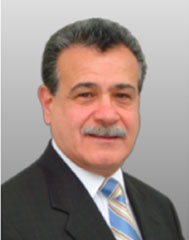 Pictured: Tony Colón
Pictured: Tony Colón
Tony Colón is a distinguished educator with over 30 years of experience as a teacher and principal. He is one of the nation’s most outspoken diversity advocates who has been instrumental in bringing education reform to the Hispanic community and increasing recruitment and professional development opportunities for minority educators.
From the classroom to the boardroom, he uses his broad leadership and education experience to forge strategic partnerships and raise awareness for Latino issues among a broad audience of decision makers.
The breakfast was sponsored by Minnesota’s National School Choice Week Planning Committee: African American Leadership Forum; Center of the American Experiment; Institute for Justice Minnesota Chapter; Minnesota Business Partnership; Minnesota Catholic Conference; Minnesota Independent School Forum; Minority Liberty Alliance; StudentsFirst MN.
National School Choice Week shines a positive spotlight on effective education options for children – including traditional public schools, public charter schools, magnet schools, private schools, online academies, and homeschool.
 Female Hispanics, or Latinas, are an increasingly powerful force in driving the economy as a whole, including being the primary or joint decision-makers in household purchases in food, beverages and all other key categories, according to a new report from Nielsen.
Female Hispanics, or Latinas, are an increasingly powerful force in driving the economy as a whole, including being the primary or joint decision-makers in household purchases in food, beverages and all other key categories, according to a new report from Nielsen.
The “Latina Power Shift” report highlights the role of Hispanic women, their growing numbers, economic condition, purchasing behavior and consumption.
In a recent Nielsen study in the U.S., 86% of Latinas reported that they are the primary shoppers in their households -- meaning that they control the majority of the current $1.2 trillion in Hispanic buying power (estimated to rise to $1.5 trillion by 2015), according to the report.
The percentages of Latinas who say that they’re the primary decision-maker in specific categories include 67% in food; 66% in clothes; 59% in pharmaceuticals; 55% in beverages; 45% in social activities; 41% in family finances; 38% in insurance; 38% in personal electronics; 33% in home electronics; and 30% in auto/transportation.
The percentages reporting that purchasing decisions are jointly made with the males in their households: 33% in food; 34% in clothes; 38% in pharmaceuticals; 41% in beverages; 52% in social activities; 50% in family finances; 50% in insurance; 50% in personal electronics; 50% in home electronics; 48% in auto/transportation.
The report lists more than 50 specific product categories within perishable and non-perishable foods, beverages, household products and personal care/beauty in which Latinas over-index in market-share dollars, compared to non-Hispanic white females.
According to Nielsen, Latinas are expected to comprise 30% of the total female population by 2060. Further, demographic patterns make it clear that Latinas’ influence on consumption patterns in the U.S. will continue to grow: 23% of all U.S. births in 2011 were to a Latina mom, with 63% of Hispanic families having children under the age of 18, compared to 40% for non-Hispanic White females.
Latinas’s influence in household purchasing decisions reflects that they are increasingly becoming the primary income earners, creating a shift away from traditional male-dominated family units, reports Nielsen.
The percentage of households with Latinas 18+ with an annual income of $75,000 or more increased five points over the past 10 years (from 16% to 21%), and those households with an income of $25,000 or more declined six points (from 33% to 27%).
Nearly three-quarters (73%) of Hispanic high school female graduates are enrolling in college -- more than Hispanic males (61%) and slightly more than non-Hispanic females (72%).
Other findings from the report include:
* Latinas are embracing entrepreneurship. The number of Latina-owned firms rose 46% between 2002 and 2007 -- faster than Latino-owned firms (+33%) and faster than total female-owned businesses (+20%).
* Whether they view themselves as culturally “more American,” ‘more Latino” or equally Latino and American, majorities of Latinas embrace their duality and want to shift to being “ambicultural” (functioning competently in both cultures, including the ability to pivot between English and Spanish).
* Online Latinas (77%) are more likely than their non-Hispanic White counterparts (55%) to own smartphones.
* 15% percent of Latinas mostly use Spanish to surf the web and 31% use both Spanish and English equally.
* When Latinas search for Latino subject matters online, recipes top the list, followed by news, music, family health, beauty and celebrations.
The full report is available for download at www.nielsen.com.
 On Monday, Oct. 28, with help from Henry Sibley ALMAS students, the West St. Paul City Council unanimously voted to update their retail tobacco licensing ordinance. Among other changes, this update requires that area vendors selling electronic cigarettes obtain a tobacco license from the city and makes the sale of electronic cigarettes to minors illegal.
On Monday, Oct. 28, with help from Henry Sibley ALMAS students, the West St. Paul City Council unanimously voted to update their retail tobacco licensing ordinance. Among other changes, this update requires that area vendors selling electronic cigarettes obtain a tobacco license from the city and makes the sale of electronic cigarettes to minors illegal.
According to The Association for Nonsmokers - Minnesota (ANSR, http://www.ansrmn.org), who also supported the ordinance changes, the West St. Paul tobacco ordinance did not previously include electronic cigarettes because they are such a new and distinct product. Electronic cigarettes were first introduced in the U.S. in 2006.
“It is important for students, like the ALMAS group, to be involved in combating the influence of tobacco. Teens are the target of a large portion of the industry’s marketing and promotion,” said Alicia Leizinger, a program and policy specialist at ANSR. “Testifying in support of stronger tobacco ordinances is one way teens can take the power back from the tobacco industry and feel pride and ownership in the improvements they’ve helped to make in their communities.”
ALMAS Advisor Robert Hanson said students in the group have been interested in reducing teen smoking and tobacco use for many years. When the students heard that the West St. Paul Police Chief had presented a proposal to the City Council regarding electronic cigarettes, they instantly wanted to become involved.
Throughout the Council’s discussions regarding the changes to the City’s tobacco licensing ordinance, ALMAS students shared information and statistics on the dangers of e-cigarettes, as well as their own personal stories about the negative impact tobacco has had on their lives or those close to them.
“This was a great experience for our students,” Hanson said. “They were able to see that they can and should work to make a difference in their local community and that our local leaders are interested in what they have to say.”
Beyond the ban on the sale of e-cigarettes to minors, the recent updates to the West St. Paul ordinance require that all tobacco products, including electronic cigarettes, be kept behind the counter or in a locked cabinet. The new law also prohibits sampling within the indoor area of any establishment with a retail tobacco license. This sampling prohibition means that electronic cigarettes may not be “vaped” or “sampled” inside tobacco retailers. West St. Paul now joins other cities across Minnesota in regulating the sale of e-cigarettes and prohibiting indoor sampling.
ALMAS, which stands for Anglos Latinos Motivated to Succeed, is a student group at Henry Sibley High School. The group meets outside of the school day and focuses on service, leadership, cultural heritage and more. The ALMAS students who presented to the West St. Paul City Council include Tony Salazar-Mejia, Crystal Espinoza, Andrea Galván, Erick Cordova and Marquís Vásquez.
 Hay muchas cosas que los padres pueden hacer para ayudar a sus hijos en su regreso a la escuela, como reemplazar la mochila vieja o comprarles los útiles que necesitan. Pero hay algo que pueden hacer que es más importante y no siempre cuesta dinero: ayudarlos con la tarea.
Hay muchas cosas que los padres pueden hacer para ayudar a sus hijos en su regreso a la escuela, como reemplazar la mochila vieja o comprarles los útiles que necesitan. Pero hay algo que pueden hacer que es más importante y no siempre cuesta dinero: ayudarlos con la tarea.
Hay muchas cosas que los padres pueden hacer para ayudar a sus hijos en su regreso a la escuela, como reemplazar la mochila vieja o comprarles los útiles que necesitan. Pero hay algo que pueden hacer que es más importante y no siempre cuesta dinero: ayudarlos con la tarea.
• Hablar con los hijos sobre la tarea. Es importante que los niños entien- dan la importancia de hacer la tarea y el impacto positivo que puede tener en sus calificaciones. Además de repasar y practicar lo que aprendieron en clase, la tarea los ayuda a prepararse para las lecciones del día siguiente y desarrollar la disciplina que necesitan para su éxito académico.
• Reunirse con los maestros. Cuando se trata de la tarea, los maestros pueden tener exigencias distintas. Por lo tanto es importante hablar con ellos para conocer sus expectativas. Por ejemplo, algunos maestros quieren que los padres revisen cuidadosamente la tarea de sus hijos, mientras que otros prefieren que sólo controlen que la hicieron. Además, el maestro puede contestar preguntas como cuánto tiempo debe pasar el estudiante haciendo la tarea y qué hacer si tiene dificultades o si le resulta demasiado fácil.
• Fijar un horario para hacer la tarea. El mejor momento para hacer la tarea es el que mejor funciona con las actividades del estudiante y la disponibilidad de sus papás. Puede ser antes o después de jugar, ver televisión, cenar o de hacer alguna actividad extracurricular. Lo importante es que la hora sea constante y que no sea la última actividad del día, cuando el niño esté cansado y con sueño.
• Escoger un lugar cómodo y eliminar las distracciones. Para fomentar la concentración es importante encontrar un lugar en la casa que tenga buena iluminación donde el niño pueda sentarse y hacer la tarea sin distracciones. Puede ser la mesa de la cocina, un escritorio o su propia habitación, siempre y cuando no haya distracciones como televisores prendidos o aparatos electrónicos a mano, a menos de que sean esenciales para hacer la tarea.
• Proveer los recursos necesarios. Los padres no tienen que ser expertos en todas las materias para ayudar a sus hijos con la tarea. Sin embargo, pueden proveerles los recursos que necesitan, incluyendo lápices, plumas, borradores y papel para escribir. También pueden llevar a sus hijos a la biblioteca o navegar el Internet con ellos para encontrar recursos que ayuden con la tarea. GobiernoUSA. gov, por ejemplo, tiene una sección de niños con información práctica sobre varios temas. Por su parte, el Departamento de Educación cuenta con una serie de folletos para ayudar a los hijos con la tarea de matemáticas, ciencias, lectura y comprensión. Para aprender más sobre temas relacionados a la educación se recomienda consultar GobiernoUSA.gov, el portal oficial del Gobierno de los Estados Unidos en español, que forma parte de la Administración de Servicios Generales (GSA) de EE. UU. Fuente: GobiernoUSA.gov
You don’t need to be an expert on every subject, just be willing to help There are many things you can do to help your kids start the school year on the right track, like replacing an old backpack or getting them the school supplies they need. But there’s something more meaningful you can do that may not cost money: help them with their homework.
Students who do their homework consistently tend to have better grades. It’s not always easy to get them to do their homework, especially after a busy day, but these tips can help:
• Talk to your children about their homework. It’s important that your kids understand why it’s important to do their homework and the positive impact it has on grades. Homework helps them practice what they’ve learned as well as prepare them for upcoming classes. Plus, by doing their homework they develop the discipline and skills they need to be successful throughout their school years.
• Talk to the teachers. Different teachers might expect different things from parents, so be sure to talk to them to figure out your role. For example, some teachers prefer parents review their kids’ homework; others prefer parents make sure kids do their homework. Teachers can also tell you how much time your child should spend doing homework and what to do if the homework is too easy or too difficult.
• Select a fixed time to do homework. The best time to do homework is the one that works best for your child and you. It can be before or after playing, watching television or dinnertime. What’s important is that homework time is consistent. Avoid leaving it for the end of the day, when your child is tired and sleepy.
• Pick a quiet area and eliminate distractions. To help your children focus on homework, pick a place in the house where there’s plenty of light and no distractions. It doesn’t have to be fancy. It can be the kitchen table or a desk. Make sure the TV is off and put away electronic devices, unless they’re essential to doing homework.
• Get them the resources they need. You don’t have to be an expert in all subjects to help your kids with homework. However, you need to make sure they have the tools they need to succeed. If you need expert help, you can always take them to the library or help them with their search online. You can also visit kids.gov to find information on homework topics. The Department of Education also has several resources to help your child with homework in different areas, including math, reading and writing.
USA.gov and GobiernoUSA.gov are the U.S. Government’s official web portals in English and Spanish, and part of the U.S. General Services Administration (GSA).
School Lunches! What’s a parent to do?
• Read food labels and compare the sodium amount in different products, then choose the options with the lowest amounts of sodium. Some varieties of bread can vary from 80 to 230 mg of sodium per slice! That can make a big difference in lunchtime sandwiches.
• Pack fresh fruits and vegetables with lunch every day.
• For a healthy snack, make trail mix using unsalted nuts, dried fruits, and whole grain cereal.
• When buying prepared meals, look for those with less than 600mg of sodium per meal.
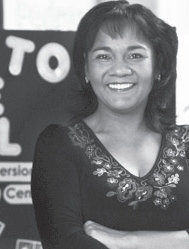 Como en todo quehacer humano los sistemas siempre son reticentes al cambio. Dentro de estos, los sistemas educativos también se caracterizado por una gran resistencia al cambio, sin embargo en nuestros días el uso de las nuevas tecnologías de la información y la comunicación (TIC) son un hecho que seguirá creciendo y con ello se irán instaurando nuevos paradigmas de enseñanza y aprendizaje en los diferentes niveles de educación. Las nuevas tecnologías informáticas y de la comunicación están produciendo nuevas relaciones entre la sociedad, los centros educativos y la familia. Asistimos a retos nunca antes planteados: ¿Cómo hacer frente a estos nuevos cambios?, y ¿Cómo hacer para que estos cambios operen en nuestras vidas de manera positiva?
Como en todo quehacer humano los sistemas siempre son reticentes al cambio. Dentro de estos, los sistemas educativos también se caracterizado por una gran resistencia al cambio, sin embargo en nuestros días el uso de las nuevas tecnologías de la información y la comunicación (TIC) son un hecho que seguirá creciendo y con ello se irán instaurando nuevos paradigmas de enseñanza y aprendizaje en los diferentes niveles de educación. Las nuevas tecnologías informáticas y de la comunicación están produciendo nuevas relaciones entre la sociedad, los centros educativos y la familia. Asistimos a retos nunca antes planteados: ¿Cómo hacer frente a estos nuevos cambios?, y ¿Cómo hacer para que estos cambios operen en nuestras vidas de manera positiva?
Existen diferentes motivos que son la causa de estos cambios: la desaparición de la escuela tradicional para convertirla en uno de los ejes de nuestra sociedad; el dominio de una economía de mercado que actualmente domina no menos del setenta por ciento de la población mundial; la globalización de mercados, con la consiguiente desregulación de los mercados de capital y de trabajo.
Todos estos elementos, en constante cambio, redefinen un nuevo perfil laboral para el trabajador de hoy, ya que a este le urge actualizar su formación al ritmo que cambian las tecnologías y las nuevas formas de producción y de servicios. Por otro lado estamos viviendo, cada día en procesos más acelerados, ciclos cada vez más cortos de innovación tecnológica, entre las que destacan los que corresponden a biotecnologías, las tecnologías de la información, de la comunicación y el entretenimiento. El acceso al procesamiento y distribución de la información, incluida la comunicación y su influencia en los sistemas educativos, es un fenómeno imparable y que redefine radicalmente todo lo que en nuestra cultura conocemos y valoramos. Lamentablemente, estos cambios afectan de manera muy diferente a los países en todo el orbe. Mientras que los países ricos imponen sus condiciones y estas condiciones favorecen a sus ciudadanos convirtiendo estas tendencias en ventajas para ellos, en los países pobres, estos no pueden competir en este modelo y perciben esta perspectiva como una constante y gran amenaza para su desarrollo. Inclusive, dentro de los países ricos, los cambios mencionados afectan de manera diferente a los diferentes niveles de la población.
Los cambios sociopolíticos y tecnológicos de comienzo de siglo están reestructurando una nueva situación social en la que se plantean nuevos modelos de interacción basados en la producción transnacional, acceso masivo al conocimiento y economía multinacional. Estos nuevos modelos exigen un replanteamiento de los modelos de capacitación y educación para hacer frente a las nuevas necesidades del mercado laboral. A este modelo lo podemos denominar “aprendizaje a lo largo de la vida”.
Son varias las razones que definen a este nuevo modelo. Tenemos los cambios en las expectativas de vida y la estructura de edad de la población, que representa un incremento del periodo productivo de la población adulta; las necesidades de la economía de la globalización hacen que la producción sea cada vez más dinámica con el consecuente cambio en las estructuras de producción; la influencia de las tecnologías de la información y la comunicación están cambiando las economías y su organización; los ciclos de innovación tecnológica son cada vez más cortos y aparecen nuevas profesiones y categorías de trabajo que no existían hace unos años; las personas tienen que daptarse al mercado y aprender nuevos conocimientos y habilidades. Dentro de este nuevo panorama, la dimensión educativa se enfrenta a cambios paradigmáticos constantes tanto en la educación escolar, pero sobretodo en la educación superior, a fin de preparar a los nuevos profesionales para una sociedad cada vez más global y tecnológica.
El nivel de utilización de tecnologías de la educación ha crecido muchísimo con el desarrollo de nuevas tecnologías y con el avance de nuevos descubrimientos científicos. Existen hoy diversos equipos y accesorios que ayudan y replantean otras y nuevas formas de interacción al interior de las escuelas y universidades. El alumno cada vez es más protagonista de su formación, debido a la amplia gama de información que ahora está a su alcance. Los maestros, van dejando de ser directores y guías educativos para convertirse en facilitadores de los procesos formativos; la educación abandona el modelo estructuralista clásico para convertirse en un sistema altamente dinámico con procesos cada vez más tecnificados de aprendizaje. En el siglo pasado la forma era agrupar a los alumnos en las escuelas para enseñar a todo un grupo por igual. Actualmente se organiza al alumnado de maneras diferentes: se mantiene el grupo clase como unidad de aprendizaje, pero también se organizan pequeños grupos, e inclusive hay sistemas que priorizan la educación individual. Ahora se considera a cada alumno diferente de los demás con sus particulares habilidades de aprendizaje, con distintos niveles de conocimientos y estilos de aprendizaje. Finalmente, todas estas nuevas tecnologías han hecho que se produzcan cambios en: las metodologías de aprendizaje; en las relaciones alumno-maestro; en la organización de los centros educativos, cambios en la acreditación de los conocimientos; en la manera de enseñar y aprender, etc.
El panorama de la influencia de la tecnología en la enseñanza es complejo y no tenemos una visión clara de lo que pueda avecinarse en un futuro mediano. Hay muchas razones a favor de su uso, pero también hay muchas opiniones en contra. Corresponde a los padres, a las escuelas y a la sociedad en su conjunto evaluar el impacto que estas nuevas tecnologías producen al interior de sus instituciones educativas. No hay que dejar de considerar que cada comunidad es independiente y diferente, por lo que los ajustes y prevenciones ante este nuevo entorno deben ser hechas a la medida de cada realidad específica.
Si tiene alguna pregunta sobre este artículo o desea información con respecto a Rayito de Sol Spanish Immersion Early Learning Center NAEYC accredited program contacte a Luisa Fuentes-Tuel a rayitodesolpreschool@gmail.com
First Covenant Church of Saint Paul and The Saint Paul Covenant will present Creative Arts Camp taking place at First Covenant Church of Saint Paul on August 5-8, 2013 from 2 to 5pm and will conclude with a Celebration, Arts Gallery and Showcase on Thursday, August 8 beginning at 5:30pm at the Phalen Park Picnic Pavilion and Amphitheater.
Creative Arts Camp is for students entering 1st through 8th grades, designed to provide these young people a safe and fun place to explore creative expression through visual and performing arts. Workshops will feature: mosaics, murals, music + drumming, hip-hop, zumba, salsa dancing and more! Cost is $5 per day, but scholarships are also available.
Camp will run Monday, August 5 through Thursday, August 8 from 2 to 5pm daily at First Covenant Church of Saint Paul (1280 Arcade Street) with a closing Celebration and Arts gallery on Thursday, August 8 at 5:30pm at the Phalen Park Picnic Pavilion and Amphitheater (1600 Phalen Drive)
Through Creative Arts Camp, First Covenant Church of Saint Paul and The Saint Paul Covenant strive to offer children and youth a safe and fun atmosphere to build self-confidence and self-worth, foster positive interactions between peers, develop leadership skills for youth and to provide opportunities for students to express themselves through visual and performing arts. Funding for this camp is provided by the Youth Philanthropy Fund of The Minneapolis Foundation.
To register online, visit http://first-covenant.org and click on the Creative Arts Camp logo or call the church office for a registration form at 651-774-0344.
First Covenant Church of Saint Paul
Contact Information:
Carmen Robles
651-774-0344
creativeartscamp@first-covenant.org
1280 Arcade Street
Saint Paul, MN 55106
©2013 latino american today. All Rights Reserved.
